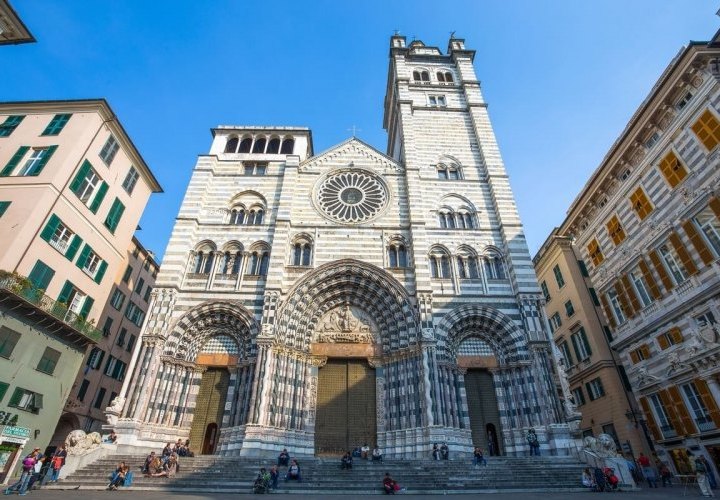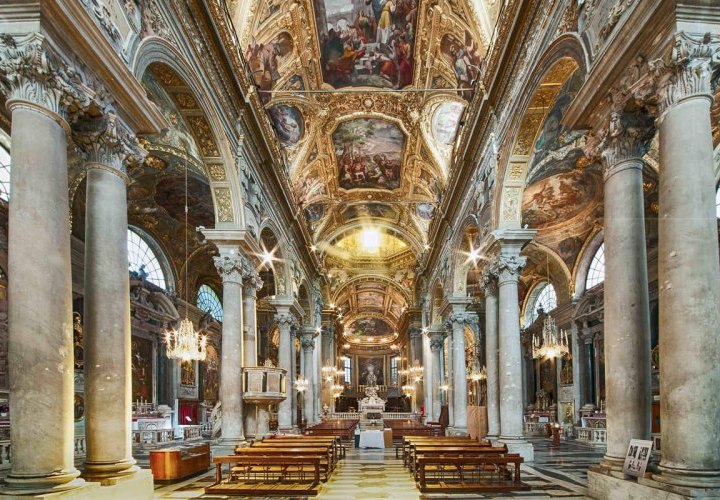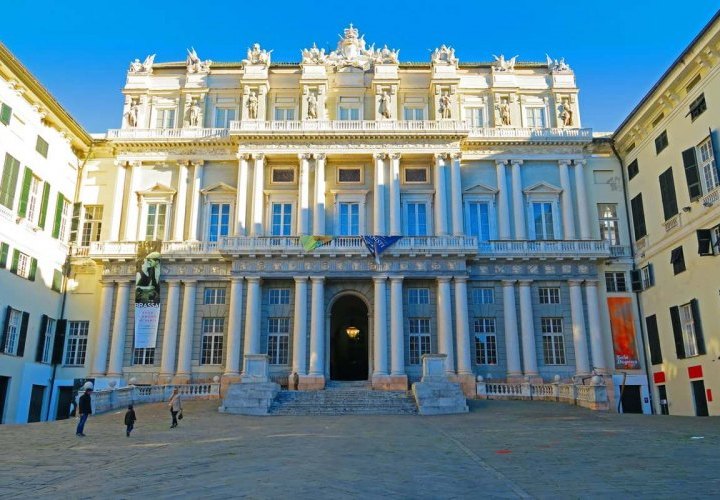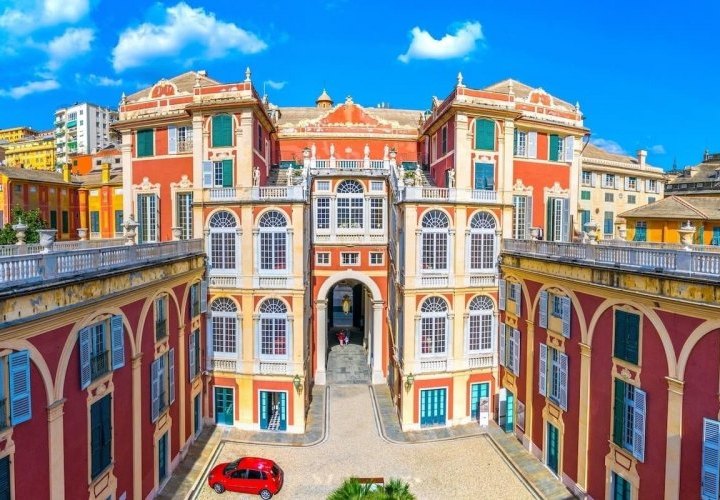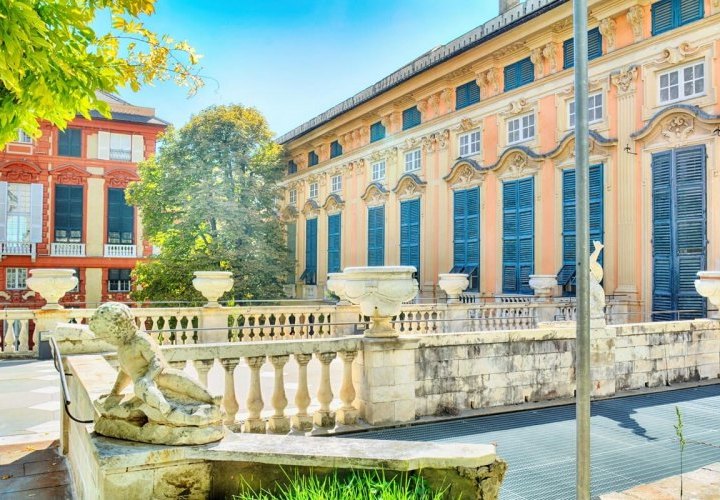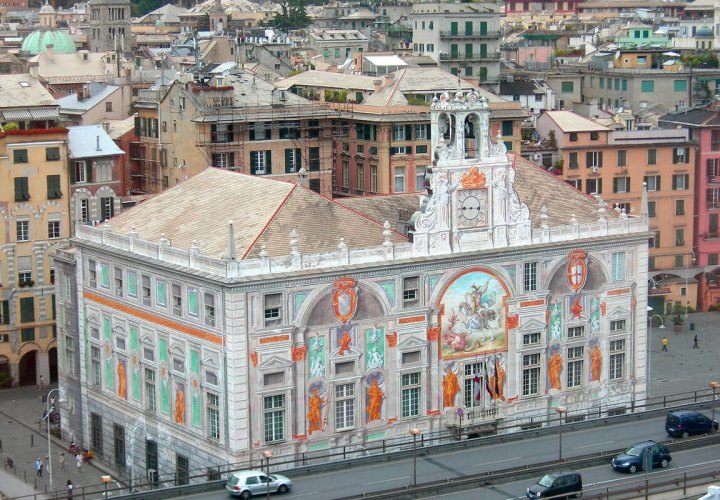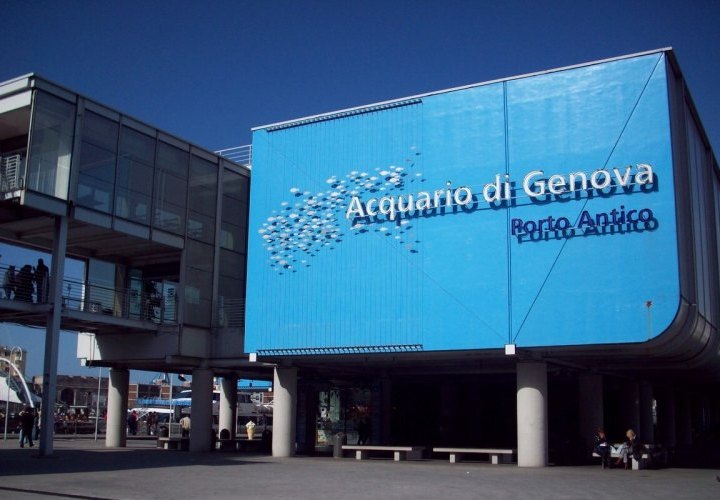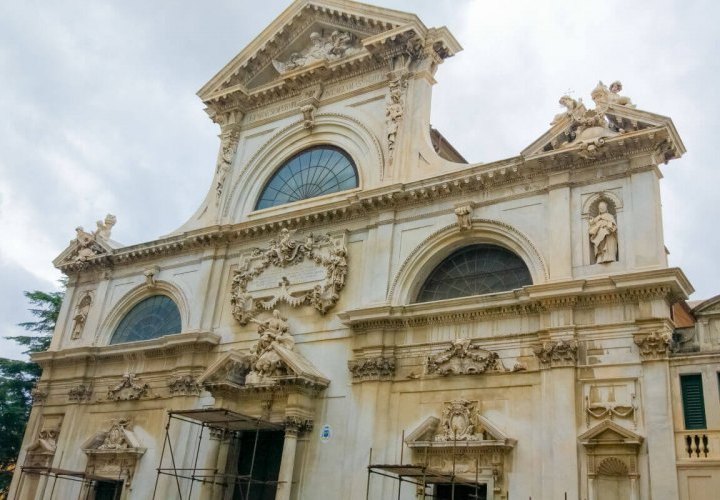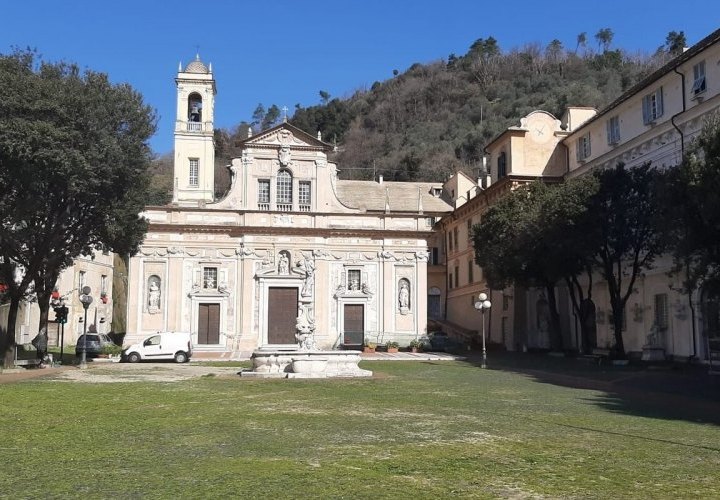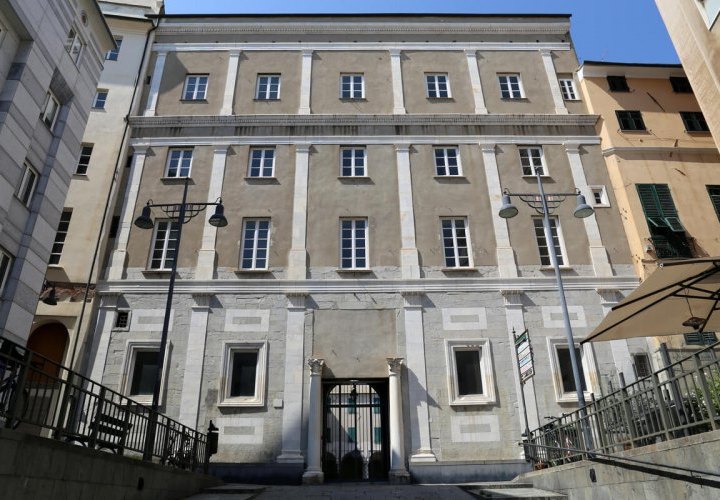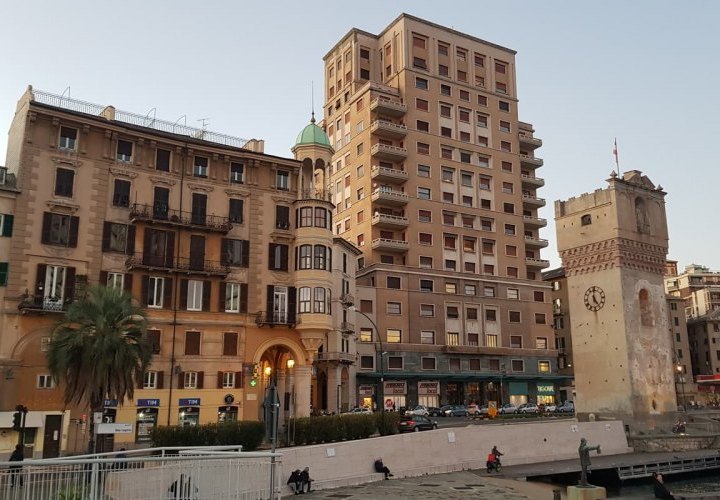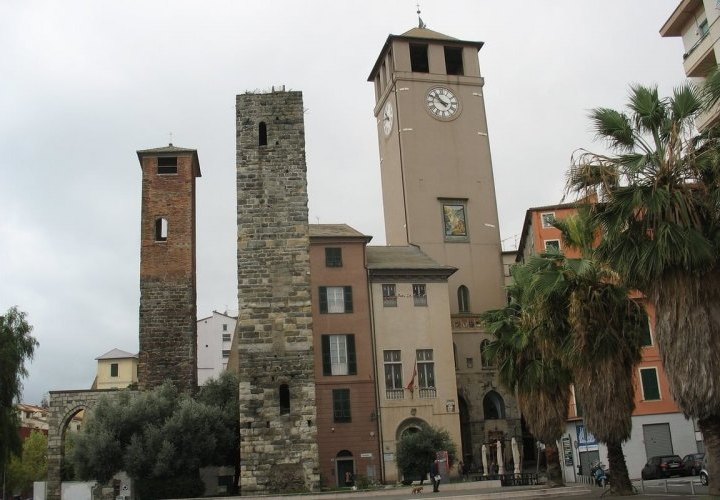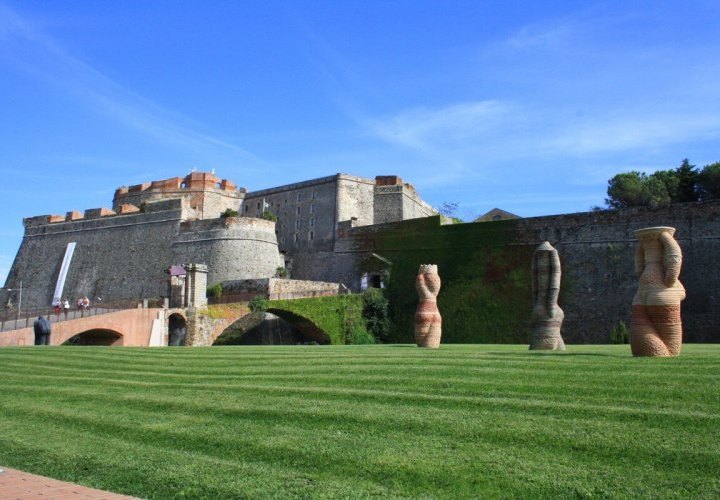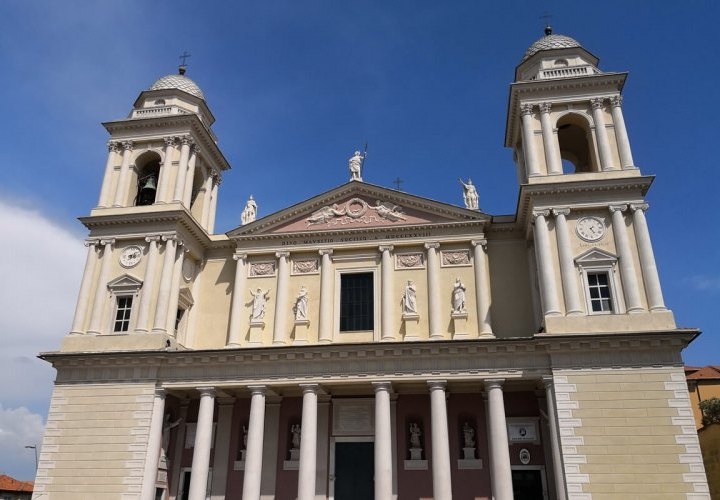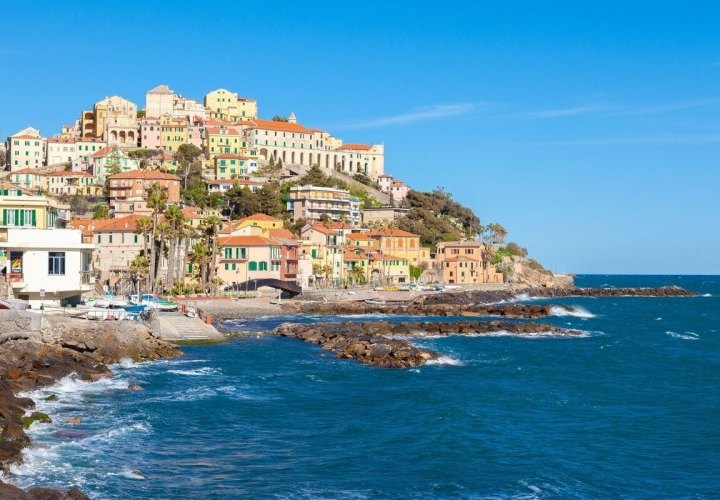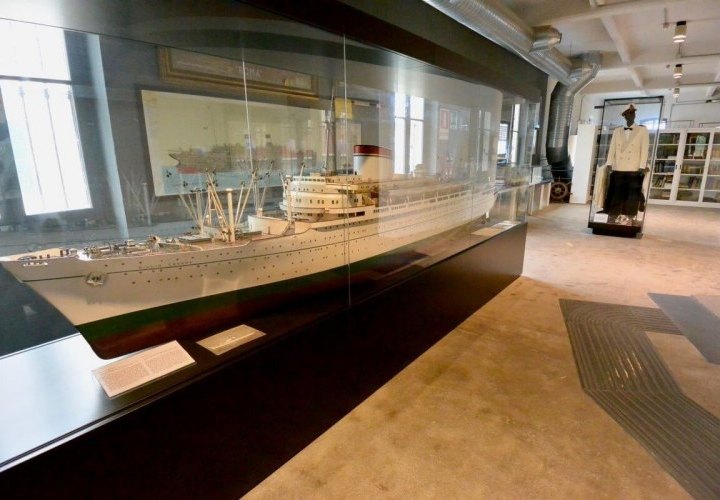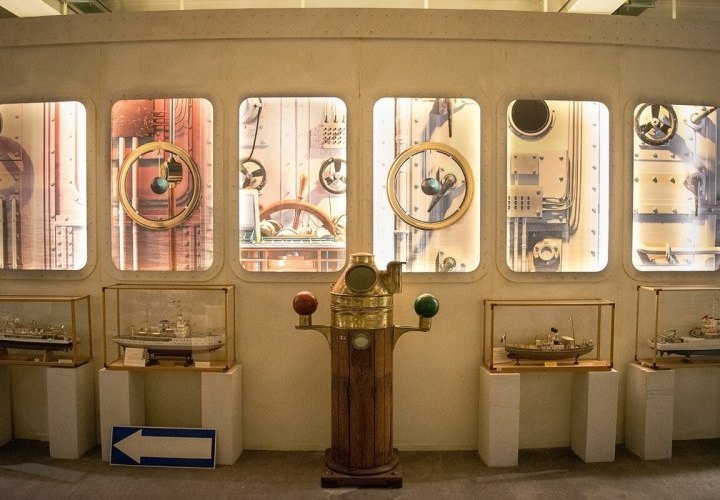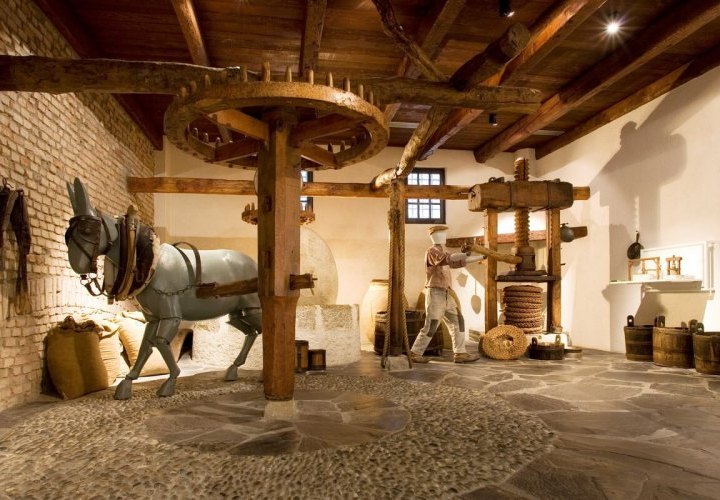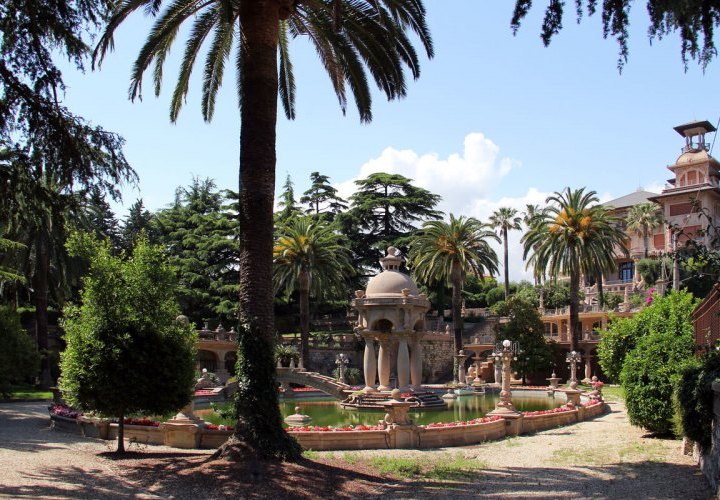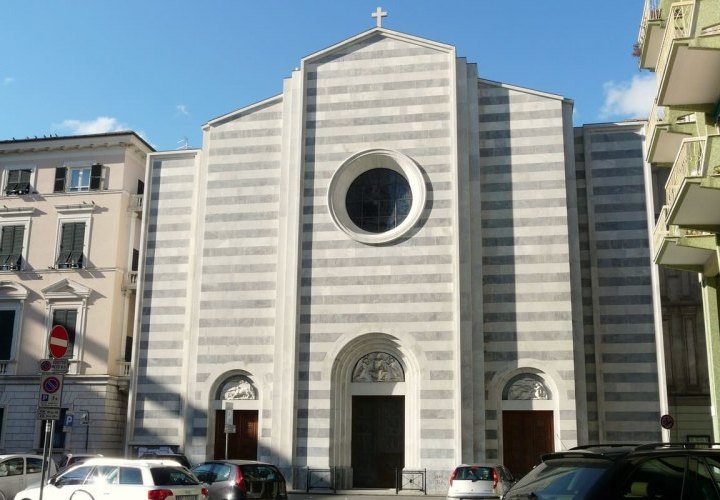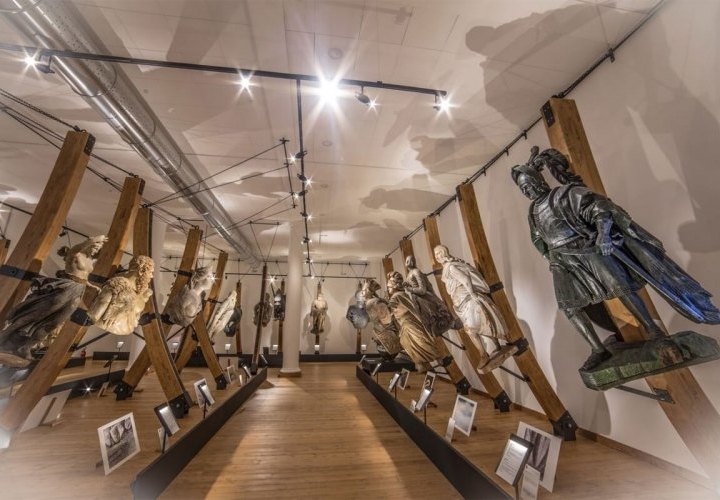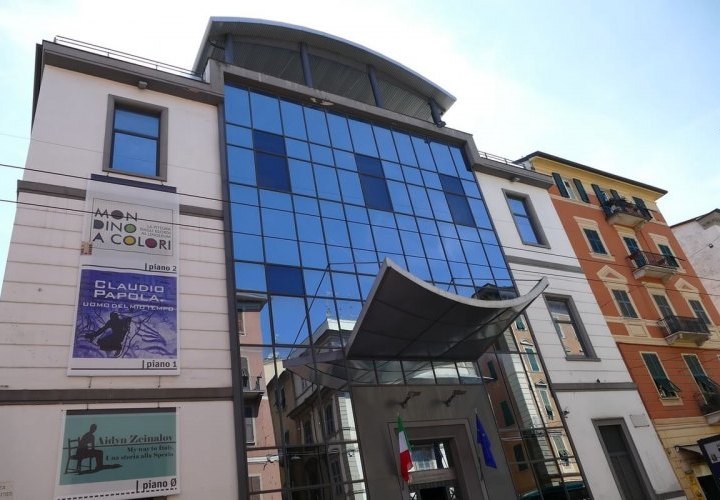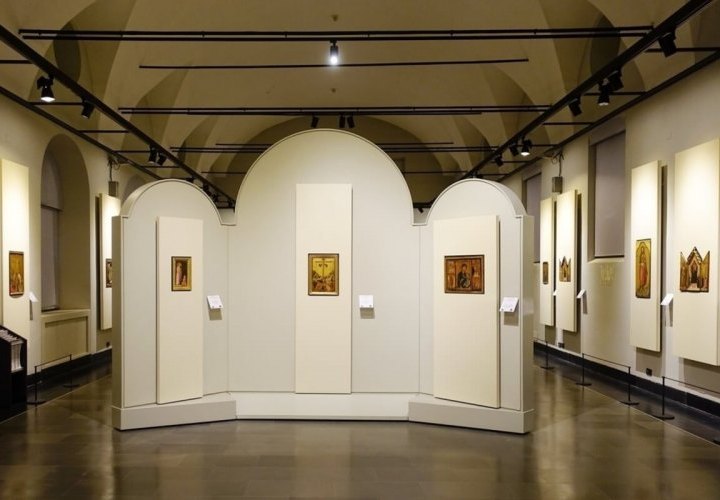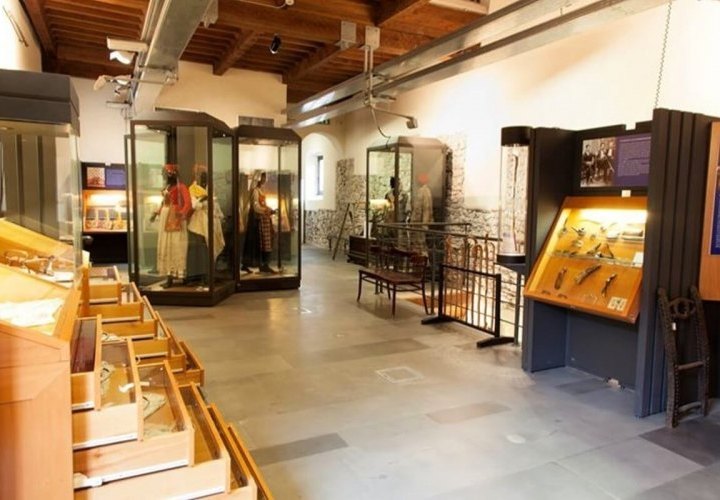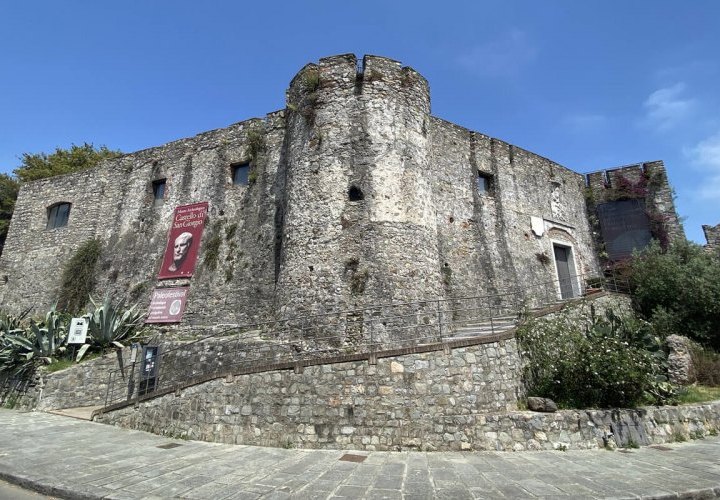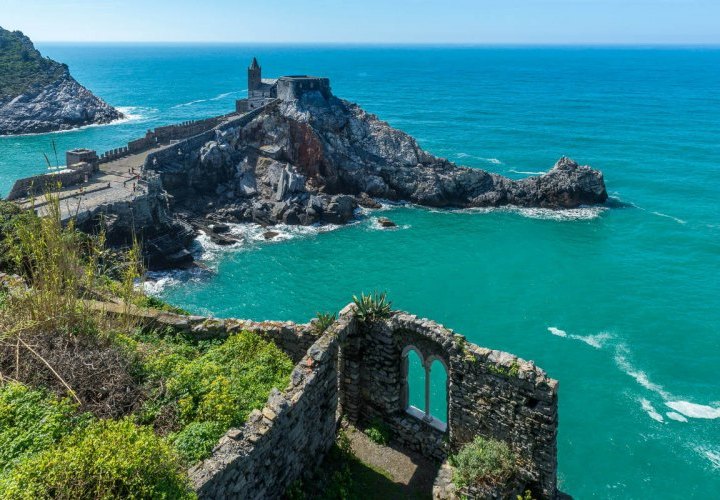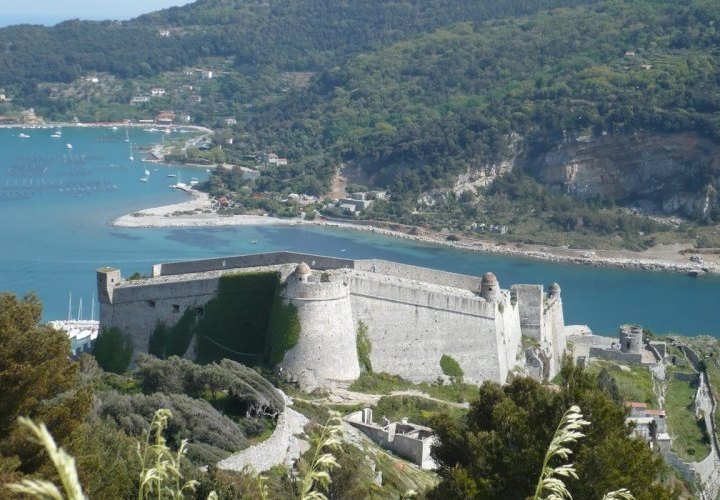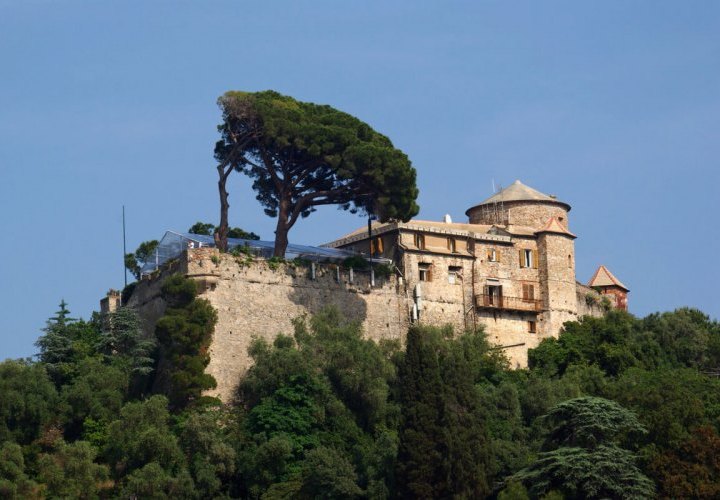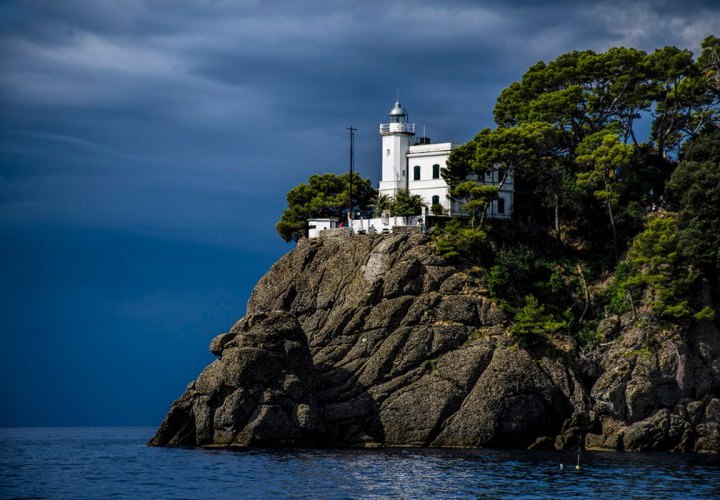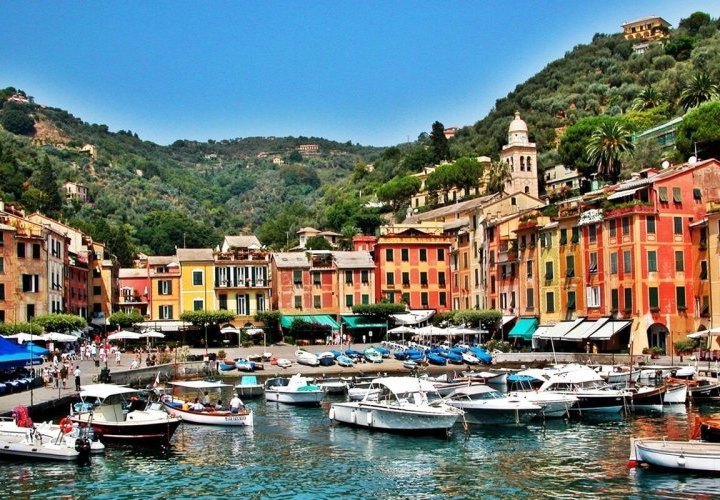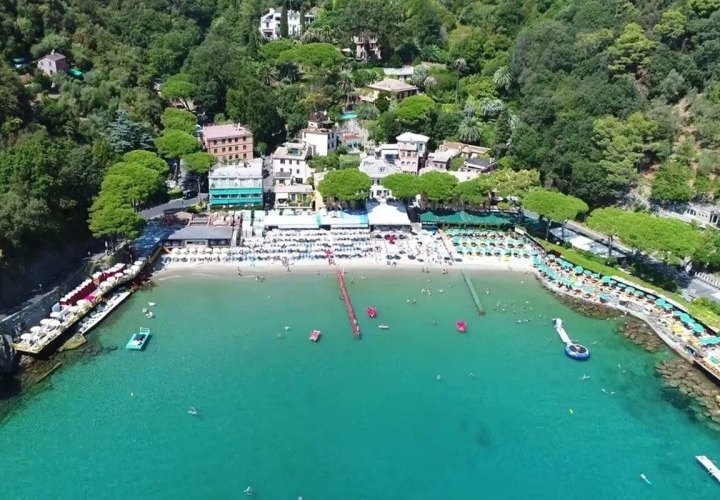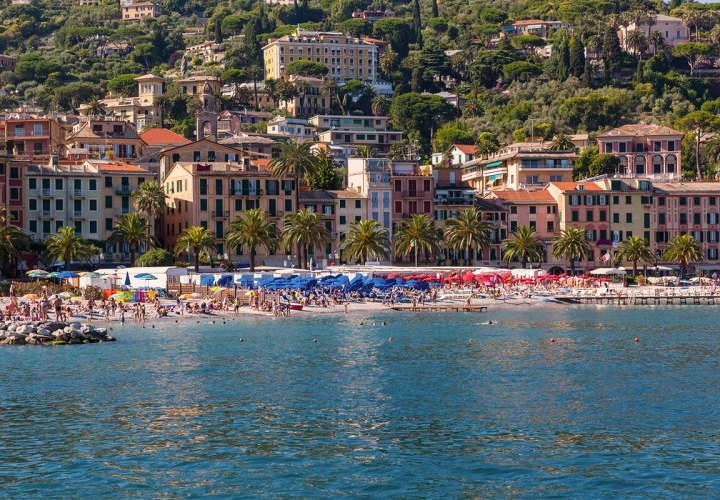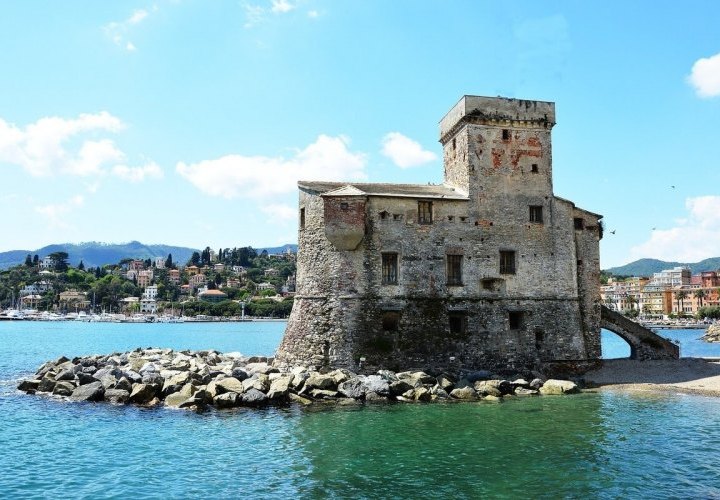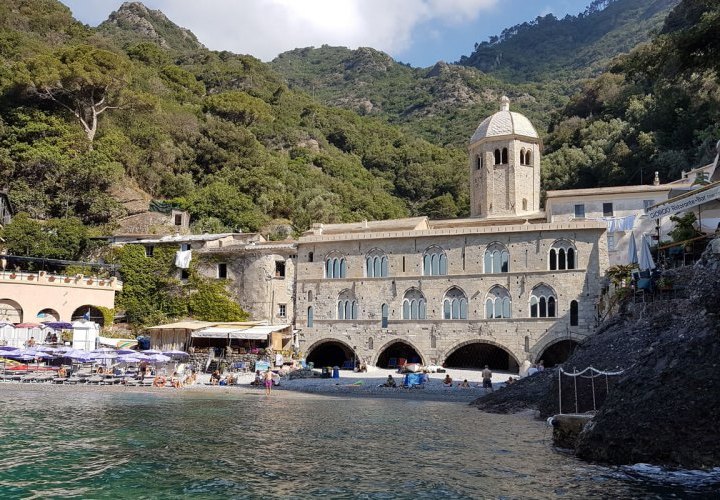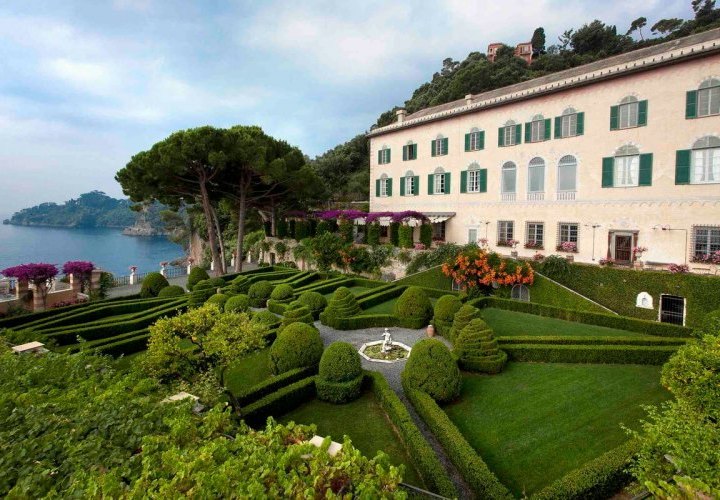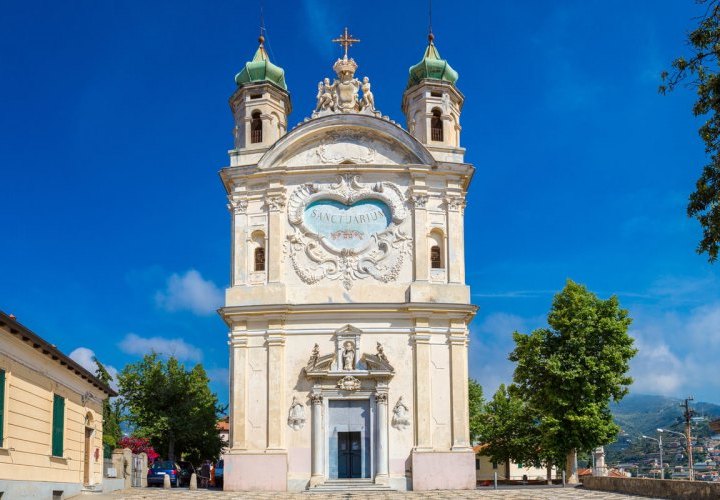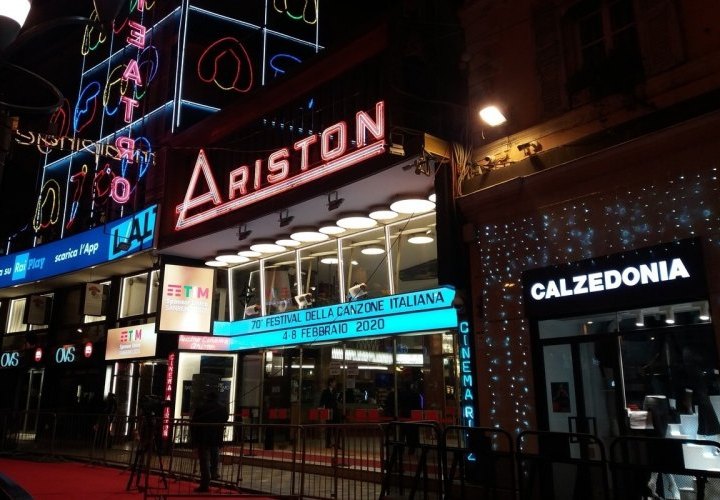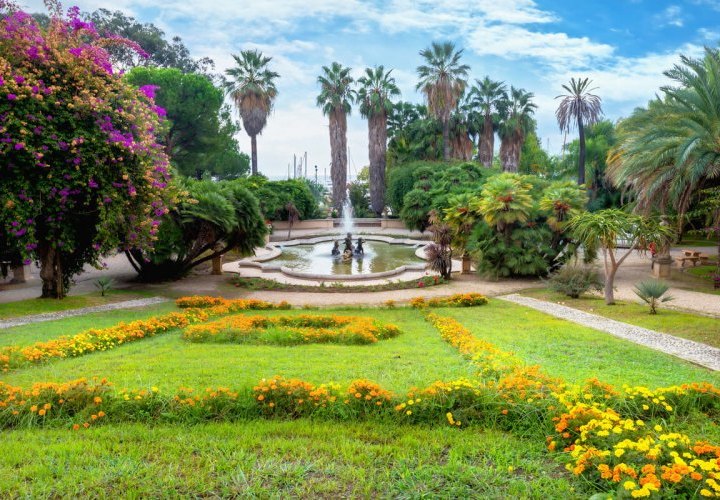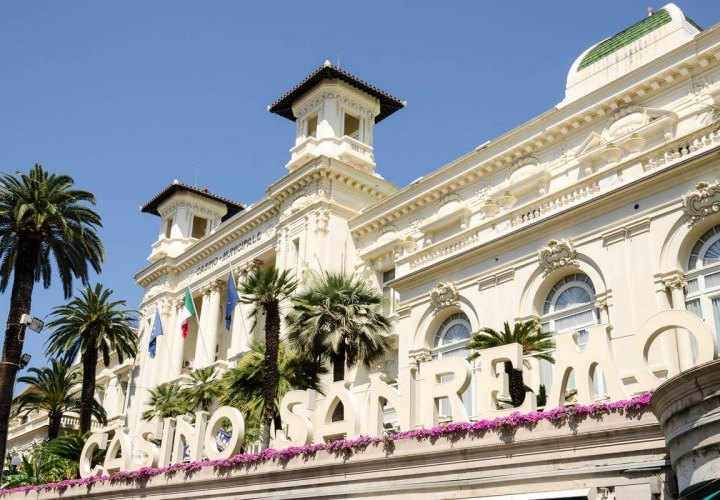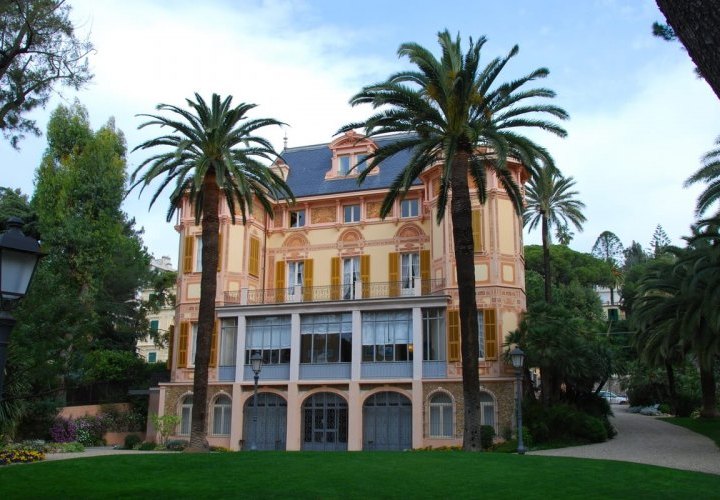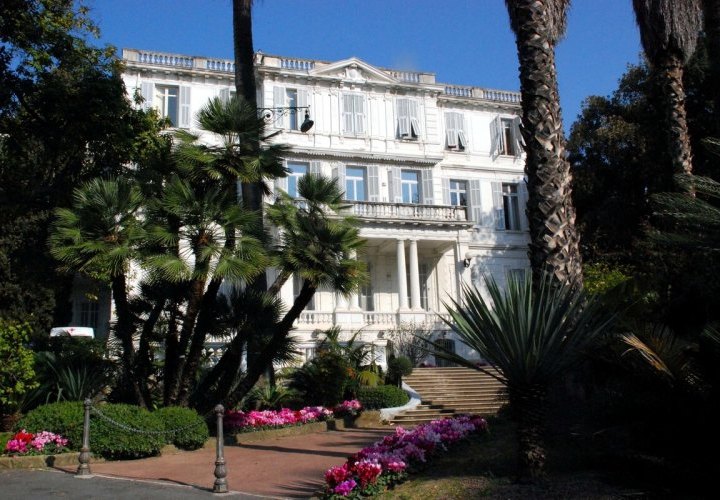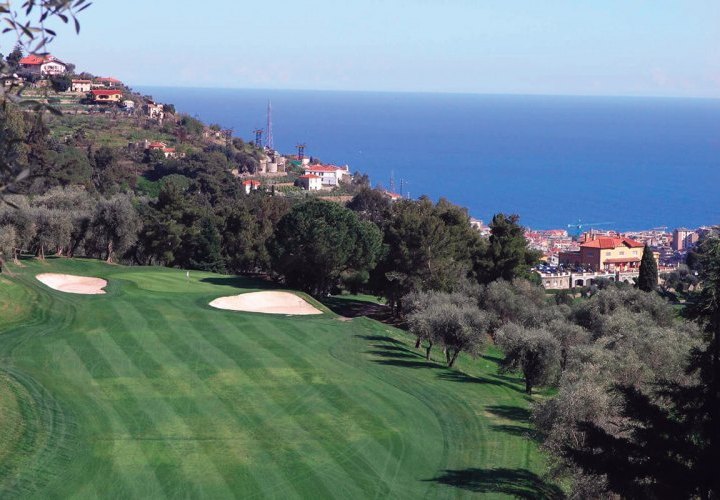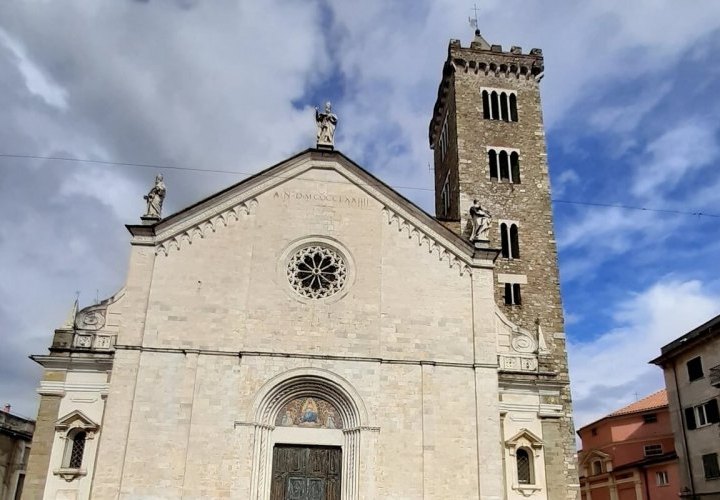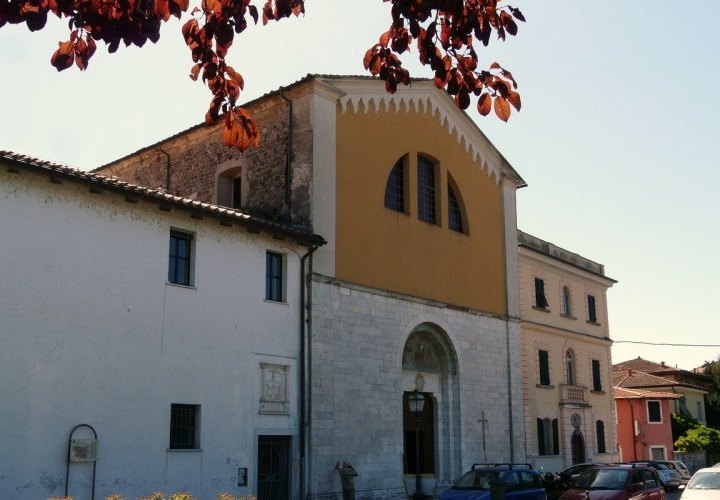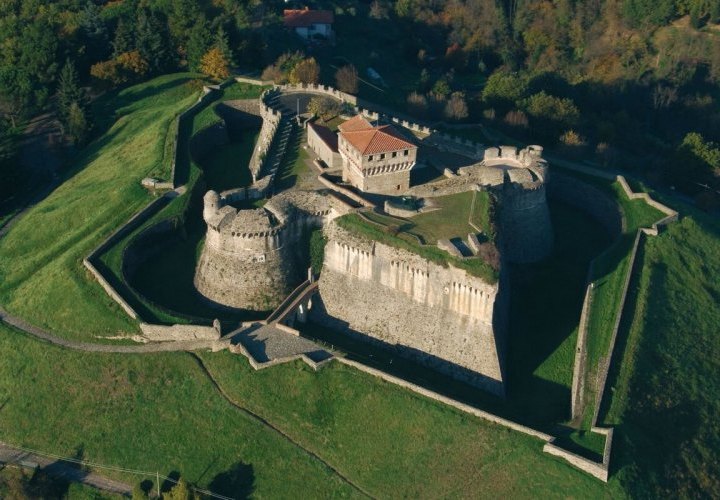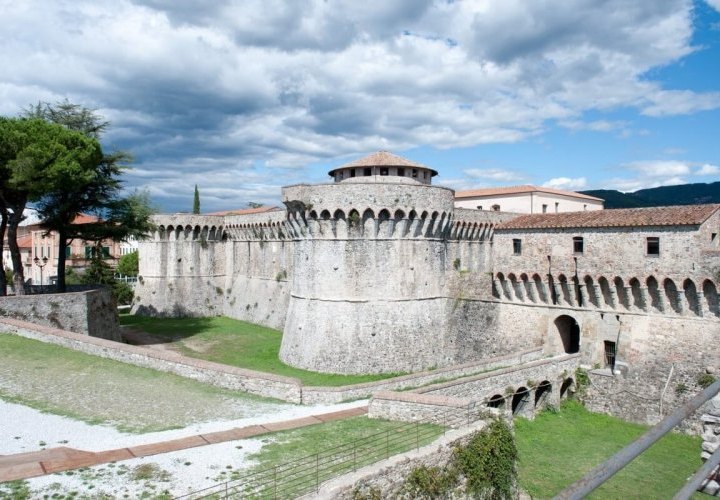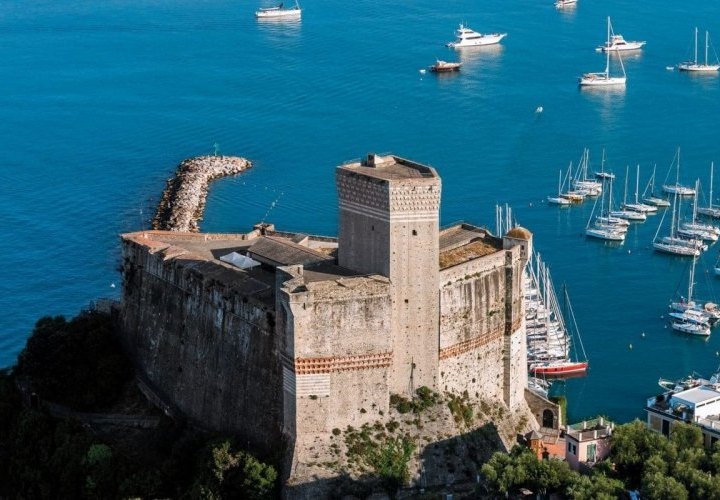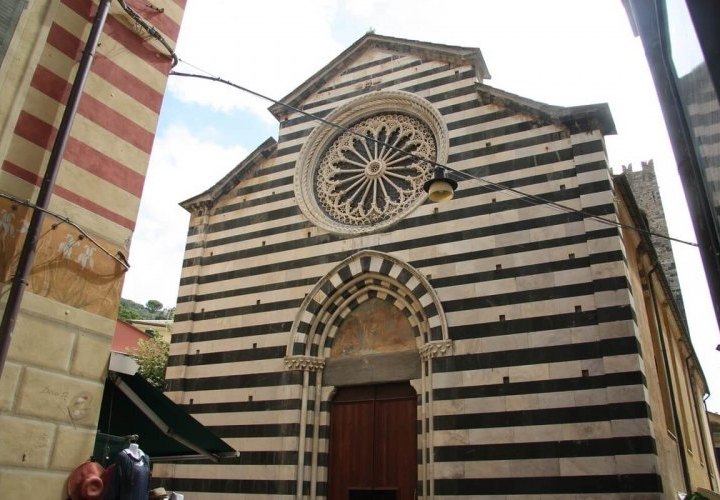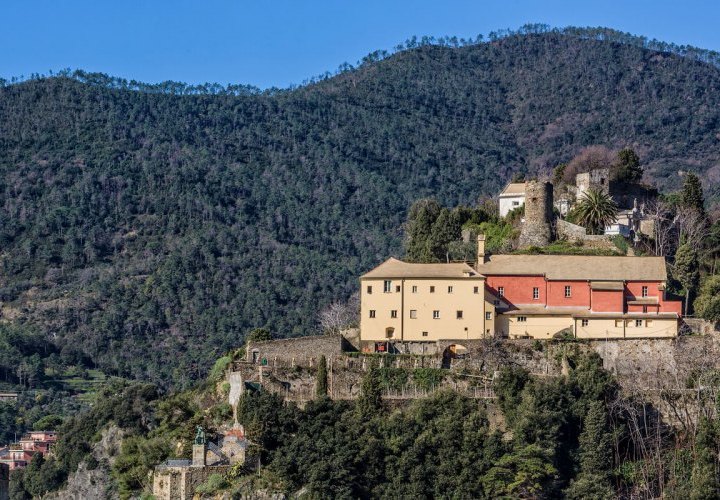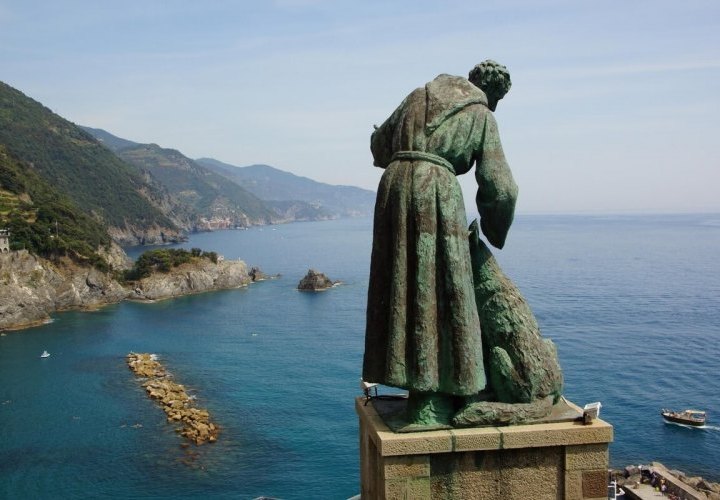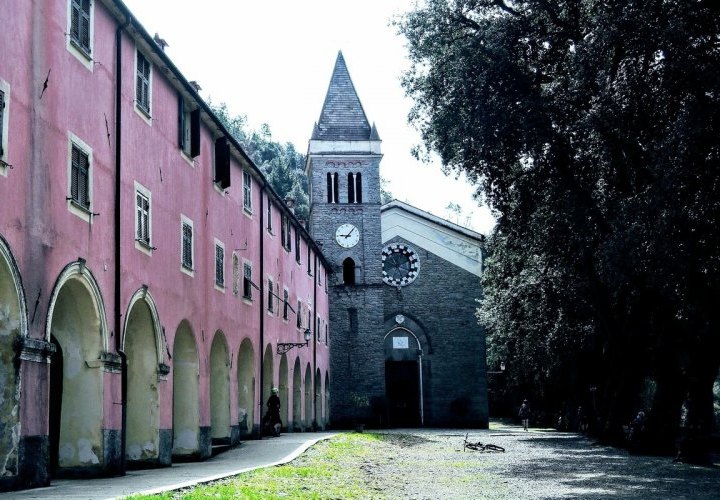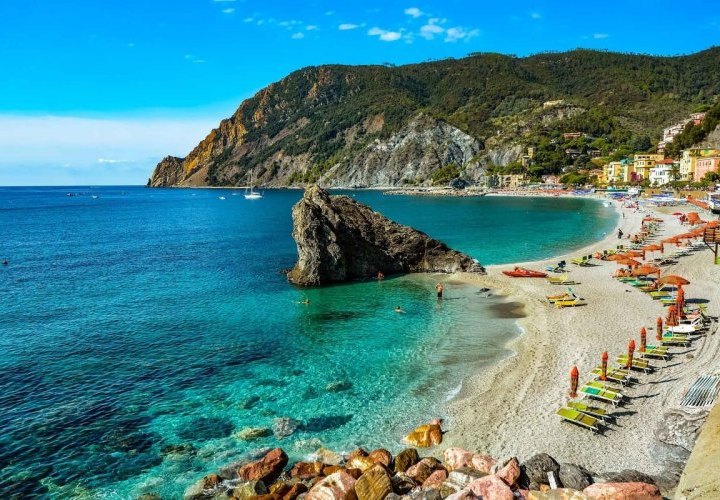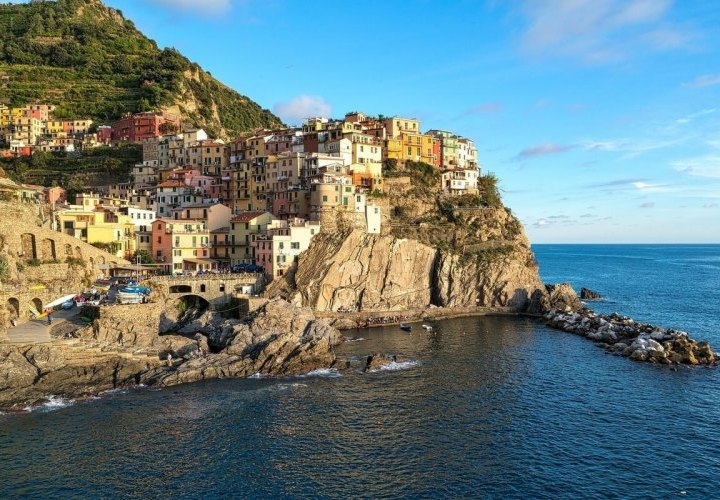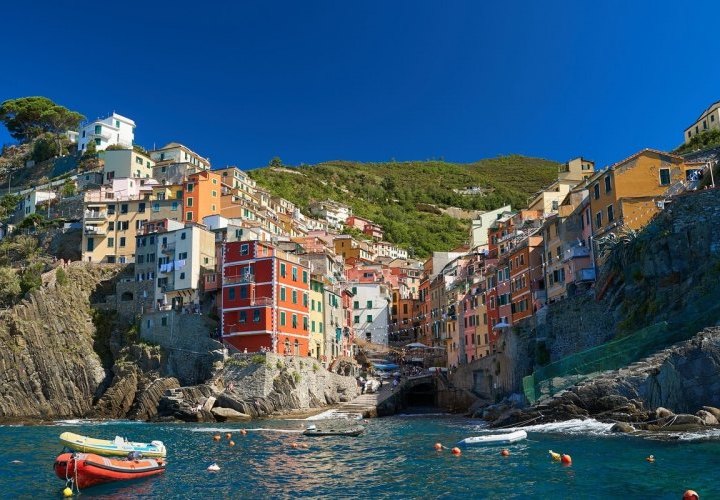Liguria is a region of north-western Italy and its capital is Genoa. Encircled by the Maritime Alps in the west, the Apennines in the east and the Ligurian Sea, its territory is roughly coextensive with the former territory of the Republic of Genoa. It is bordered by France (Provence-Alpes-Côte d'Azur) to the west, Piedmont to the north, and Emilia-Romagna and Tuscany to the east and has a population of 1,557,533 inhabitants. Although Liguria is the third smallest Italian region after Aosta Valley and Molise, it is one of the most densely populated region, with a population density of 287 ab/km².
The continental shelf is very narrow and steep so that it descends almost immediately to considerable depths along its 350-kilometre coastline. Liguria can amaze you with beautiful nature reserves and parks that cover 12% of the entire region or 600 km2 of land. more
The continental shelf is very narrow and steep so that it descends almost immediately to considerable depths along its 350-kilometre coastline. Liguria can amaze you with beautiful nature reserves and parks that cover 12% of the entire region or 600 km2 of land. more
At the mouths of the biggest watercourses there are small beaches offering you the possibility to relax and enjoy sunbathing, walking or practicing open-air sports. Here you will find a place where you can get lost in the Mediterranean scrub forests, the harbours, the coastal areas with steep cliffs or the olive groves, vineyards and pine forests on the hills. You will discover amazing villages, charming landscapes and romantic sunsets in the region.
Genoa, also known as la Superba (“the Superb one”), is the capital of the picturesque Ligurian capital placed in the centre of the region and the sixth-largest city in Italy. Overlooking the Ligurian Sea, Genoa has historically been one of the most important ports on the Mediterranean. Its Porto Antico (old harbor), which is the ancient part of the port of Genoa, is still one of the most important in Italy and one of the largest in the Mediterranean and in Europe. The lighthouse, placed near the old harbor and called la Lanterna (the Lantern), is the symbol of the city.
Currently the city is a famous tourist, scientific and university centre where about 855,834 resident persons live. Some of the most interesting and beautiful areas to visit are the old town centre with its carruggi (little and narrow streets), the Aquarium, the Palazzo Ducale (historical seat of the Doge) and San Lorenzo Cathedral. In 2006, one part of Genoa historic centre, Le Strade Nuove and the system of the Palazzi dei Rolli, was included in the UNESCO World Heritage and in 2004, it was the European Capital of Culture.
TOURIST ATTRACTIONS IN GENOA
Cathedral of San Lorenzo
Built between 1100 and 1557, the Cathedral of San Lorenzo dedicated to San Lorenzo Martire is the most important place of Catholic worship in the city of Genoa. It was originally built as a Romanesque basilica in 1100, remodeled in Gothic style in between 1307 and 1312, and finished off with a Renaissance dome in 1557. In 1118, the cathedral was consecrated by Papa Gelasio I, and in 1133, became the seat of the archbishop of Genoa.
After a fire that occurred in 1296, some parts were reconstructed in Gothic style. Between 1307 and 1312, the majestic facade with white and black stripes was finished, the counter facade was frescoed and the inner colonnades where restyled with new capitals, but the well preserved Romanesque structures were maintained. On both sides of the staircase, in front of the facade, there are two lions that belong to the Gothic period.
Between the 14th and the 15th century, the cathedral was enriched with new altars and chapels, including the large 15th-century Cappella San Giovanni Battista, which is the earliest example of Renaissance architecture in Genoa, built to guard the remains of St. John the Baptist. In the middle of the 16th century, the architect Galeazzo Alessi from Perugia redesigned the whole building, but only the roofing of the aisles, the floors, the dome and the apse area were reconstructed.
Basilica of Santa Maria delle Vigne
Built in the 10th century and located in Piazza delle Vigne, the Basilica of Santa Maria delle Vigne is one of the oldest Catholic churches in Genoa. The perimeter walls, the cloister, the bell tower and a column painted with the Madonna of the Milk are remains of the Romanesque architecture, while the main facade of the church is the most important work of Hippolytus Cremona in late neoclassical style. The columns of the neoclassical facade, which were added to the structure of 1640 in 1842, come from the demolished church of St. Paul “il Vecchio” that was situated nearby, in Campetto. Outside, on the right side of the church, there is a fresco depicting the Madonna with Child and Young Saint John offering a bunch of grapes done by Domenico Piola in the late seventeenth century.
Above the altar of the Virgin, on the right side of the high altar, you can see a panel depicting the Madonna and Child attributed to Taddeo di Bartolo.
Piazza De Ferrari
Situated in the heart of Genoa between the historical and the modern centre, Piazza De Ferrari is the main square of the city, renowned for its splashing bronze fountain designed by the architect Giuseppe Crosa di Vergagni and built in 1936, which became one of the symbols of the city. At the end of the 19th century Genoa was the main financial centre of Italy along with Milan, and many institutions, such as the stock exchange, the Credito Italiano, the branch offices of the Bank of Italy, founded in 1893 were established in Piazza De Ferrari. The square is about 11.000 m² and is dedicated to the Italian banker and politician Raffaele De Ferrari, duke of Galliera.
Built between 1899 and 1983, the square took shape in the first two decades of the twentieth century with the creation of three streets: Via XX Settembre, Via Dante and Via Petrarca. Here you can see neoclassic buildings such as Carlo Felice Theatre and the Accademia Ligustica di Belle Arti. In front of the theatre, you can see a statue dedicated to Giuseppe Garibaldi, built by the Italian sculptor Augusto Rivalta in 1893.
Boccadasse
Even if Genoa is located on the Mediterranean between two major beach regions of the Italian Riviera, there are no real beaches in the city except a small beach at Boccadasse, an old and picturesque fishing village, which is now a neighbourhood of Genoa.
The ancient village of Boccadasse lies at the eastern end of the main promenade of the city of Genoa and you can stroll along the seafront promenade or take a local bus to this little seaside enclave with pastel coloured houses and cobblestone beach. Next to the bay, there are ice cream shops, restaurants, bars, bakeries, and art galleries. Boccadasse is also known for its church named after Saint Anthony of Padua that faces on the east side Corso Italia and on the west side the panoramic square dedicated to the Genoese poet Edoardo Firpo. From the bay, one of the several narrow streets goes up to Capo Santa Chiara dominated by the Türcke Castle, offering a wide view of the Paradise Gulf and of Portofino. The castle was designed by the Italian architect Gino Coppedé in 1903, was built in Florentine style in 1400, and has similarities with Palazzo Vecchio in Florence, Italy.
Doge’s Palace (Palazzo Ducale)
Situated in the heart of the city, the Doge’s Palace (Palazzo Ducale), which was once the home of the Doges of Genoa, is now one of the most important museums in the city and a centre for cultural events and arts exhibitions. It was built in 13th century, but only in 1339 became the seat of Genoa’s first Doge, Simon Boccanegra. The building has been enlarged and renovated many times throughout the centuries and today the original medieval structure is hardly visible. The palace has two different entrances and facades, the main one on Piazza Matteotti, and the second one on Piazza De Ferrari and was reopened to the public in 1992, after a complex restoration.
Royal Palace (Palazzo Reale)
Located in Balbi Street near the university and the station of Genoa, the Royal Palace (Palazzo Reale) was built between 1618 and 1620 by Stefano and Francesco Balbi, who belonged to a rich family. The building includes three important parts: the historical residence, the courtyard and the unique art gallery and preserved luxurious Genoese, French and Piedmontese furniture.
In 1677, the Balbi family sold the building to Durazzo family who enlarged it. In 1832, Savoia family gained the ownership of the building and chose it as the official residence. In 1919, the palace becomes part of the State patrimony and a beautiful museum. In 2006, the Royal Palace became an UNESCO World Heritage Site and is enlisted as a palace of the Rolli of Genoa, public lodging palaces and mansions of eminent Genoese families.
Red Palace (Palazzo Rosso)
Built between 1671 and 1677 for the brothers Brignole Sale of Genoa by the architect Pietro Antonio Corradi, the Red Palace located in Via Garibaldi is a house museum with a rich art collection inside. In 1874, the last heir of the family, the Duchess of Galliera, Maria Brignole Sale, donated to the Municipality of Genoa the palace and the art collections therein, which formed the historical collections of the Palace Museum.
The collections of the palace consist of paintings of the Flemish school, created by Guido Reni, Guercino, Mattia Preti, Bernardo Strozzi, Veronese, and a textile collection from different countries, a topographic and cartographic collection. In 2006, the palace was included in the list of palaces, which now form the UNESCO World Heritage Site Genoa: Le Strade Nuove and the system of the Palazzi dei Rolli.
White Palace (Palazzo Bianco)
The White Palace (Palazzo Bianco) is located in the beautiful historical centre of Genoa and was built between 1530 and 1540 for Luca Grimaldi, member of one of the most important Genoese families. In 1580, the property was given to De Franchi family and in 1711, the heirs of Federico De Franchi, ceded the building to Maria Durazzo Brignole, their main creditor. In 1899, it was donated to the city of Genoa by Maria Brignole Sale, Duchess of Galliera.
The visitors can admire masterpieces by the Genoese school of the 16th and first half of the 17th centuries, important works by the Venetian School of the 16th century and many European paintings between 13th and 18th centuries.
Doria-Tursi Palace (Palazzo Doria-Tursi)
Doria-Tursi Palace (Palazzo Doria Tursi) was built approx. between 1530 and 1630 and houses the boardrooms of the Mayor, as well as the enlargement of the Palazzo Bianco Gallery. The palace features a small but absorbing collection of the legendary violinist Niccolò Paganini, including Il Cannone del Gesù violin (the Cannon), often appended with Guarneri del Gesù made by Giuseppe Antonio Guarneri of Cremona, letters, musical scores and his travelling chess set. Its halls also display a remarkable exhibition of decorative art pieces, and a collection of official coins, weights and measures from the old Republic of Genoa.
Palace of Saint George (Palazzo San Giorgio)
The Palace of St. George (Palazzo San Giorgio) situated in the Caricamento Square is one of the most well-known buildings in Genoa and was built in 1260 under the order of Guglielmo Boccanegra, who was the uncle of Simone Boccanegra, the first Doge of Genoa.
The palace is a marvelous example of Medieval Civil architecture. Moreover, the ancient section of the structure is made of materials used from the demolition of the Venetian embassy in Constantinople, obtained from the Byzantine Emperor Michael VIII as a reward for Genoese aid against the Latin Empire. In 1262, Guglielmo Boccanegra was forced into exile and the palace was used for a period of time as a prison. Marco Polo, who was imprisoned here by the Republic of Genoa, told the memories of his voyage to Rustichello from Pisa. In the 15th century the palace became home to the Bank of Saint George (one of the first banks developed in Italy) that gave the name to the building. The facade of the palace has a fresco painting by Lazzaro Tavarrone, which dates back to 1610 representing Saint George.
Spinola Palace (Palazzo Spinola)
Spinola Palace (Palazzo Spinola), also known as Francesco Grimaldi Palace (Palazzo Francesco Grimaldi), is a historical building located in Piazza di Pellicceria in the historical centre of Genoa.
Through history, the palace was the home of some of the most important noble families of Genoa such as the Grimaldi, the Pallavicino, the Doria and the Spinola families. In 1958, the Spinola family donated the palace with its works of art and furniture to the Italian State.
Currently, the building houses the National Gallery of the Spinola Palace including works bought, commissioned and inherited during more than three centuries. You can see collections of paintings, furniture, ceramics, books and other private treasures belonging to all the families who lived here in the past. You will be impressed by important paintings by Antonello da Messina, Peter Paul Rubens, Orazio Gentileschi and Van Dyck, and the Galleria degli Specchi (the Hall of Mirrors) built in 1736.
Spinola Palace was one of the 163 Palazzi dei Rolli of Genoa, the selected private residences where the important guests of the Republic of Genoa were hosted during State visits. In 2006, it was included in the list of the palaces that now form the UNESCO World Heritage Site Genoa: Le Strade Nuove and the system of the Palazzi dei Rolli.
Aquarium of Genoa (Acquario di Genova)
Located in the old harbor area of Genoa, the 3,100-square-metre Aquarium of Genoa is the largest aquarium in Italy and one of the largest in Europe. It was inaugurated in 1992 on the occasion of the 500th anniversary of Columbus’ “discovery” of the New World and hosts the most extensive range of aquatic biodiversity in Europe. The exhibition gallery consists of over 70 exhibits and about 12,000 marine animals of 600 species including fishes, marine mammals, birds, reptiles, amphibians and invertebrates from all the seas of the world.
The walk between the amazing cold sea, tropical sea, Mediterranean and sweet water pools will take you about 2 hours and 30 minutes. The touching pools offer you the possibility to put your hands in these open polls and gently pet the animals. Beside the sea tour, you can also enjoy a walk in the tropical forests zone, the home of many different species including hummingbirds.
Museum of World Cultures (Museo delle Culture del Mondo)
The Museum of World Cultures is housed in the D’Albertis Castle, home of the captain Enrico Alberto D’Albertis, and was opened in 2004, when Genoa was the European Capital of Culture. During his travels by sea and land between the 19th-20th centuries (three times around the world and one circumnavigation of Africa), he collected many souvenirs from people he met, now exhibited in the museum.
Captain D’Alberti travelled all his life, first with the Military Navy, and then with the Merchant Navy and in 1879 he founded the first Italian Yacht Club. The castle and its collections were donated by him to Genoa Municipality.
Museum of Ethnomedicine “Antonio Scarpa”
The Museum of Ethnomedicine “Antonio Scarpa” is one of the few museums of its kind in the whole Europe and hosts about 1,500 objects, instruments, medicines, texts that Antonio Scarpa collected during his travels. Antonio Scarpa can be considered one of the first researchers in ethnomedicine who for 55 years travelled all over the continents and approached hundreds of ethnic groups in order to learn how they alleviated suffering through the particular practices of their traditional medical systems.
The museum, which shows us different medical traditions all over the world, was donated to the University of Genoa, and together with the activity of Genoese anthropology, led to the establishment of the UNESCO Chair “Anthropology of Health. Biosphere and care systems”.
Museum of Ligurian Archaeology
The Museum of Ligurian Archaeology is situated out of the centre of Genoa, in the beautiful Villa Pallavicini and houses the largest collection of Ligurian Archaeology: prehistory and early history of Liguria, the Paleolithic burials from the Arene Candide cave, the extensive items of pre-Roman necropolis of Genoa, the excavations of the city during the Roman Empire, the collection of Greek and Roman antiquities of Prince Odone of Savoy, and two rooms dedicated to the Egyptian collection and Roman marbles.
Museum of Oriental Art Edoardo Chiossone (Museo d’Arte Orientale Edoardo Chiossone)
The Museum of Oriental Art Edoardo Chiossone in Genoa is the most important museum of its kind in Italy and displays a rich heritage of Japanese and Oriental art, collected in Japan by Edoardo Chiossone. The painter, native of the province of Genoa, lived many years in Japan and left his large collection counting over 15,000 pieces of Oriental art to the museum.
The museum contains magnificent Japanese works from various epochs: paintings from the 11th to the 19th century, armours and weapons, enamels, bronzes, ceramics, lacquers, porcelains, polychrome prints, musical instruments, theatre masks, beautiful costumes and textiles, and a rich collection of large sculptures from Japan, China and Siam.
Galata Maritime Museum (Galata Museo del Mare)
Galata Maritime Museum (Galata Museo del Mare) is located in the area between the Aquarium and the Maritime Station of Genoa and is housed in the oldest building of the Darsena (the old marina), once the Arsenal of the Republic of Genoa. A beautiful and elegant glass and steel cladding designed by the Spanish architect Guillermo Vázquez Consuegra gave a new life to the oldest building in the Darsena area, where galleys of the Genoese fleet were built, armed and launched.
Galata Maritime Museum, which was opened in 2004, when Genoa was awarded the European Capital of Culture is today the largest maritime museum in the Mediterranean Sea. The museum spreads on an area of over 10,000 square metres and has innovative, interactive multimedia stations, high-tech displays, real-life replica galley ships, over 6,000 original items, and constantly updated themes and exhibitions.
Prince’s Palace (Villa del Principe)
The Prince’s Palace (Villa del Principe), which was built in 1530 for the admiral Andrea Doria is one of the most beautiful and authentic Genoese palaces. It’s the largest and most sumptuous noble residence in the city of Genoa, the villa of the only Prince that Genoa has ever had.
The palace offers you a magnificent walk through the prince’s and princess’ apartments and the extraordinary large halls, all carefully decorated by the artist Perin del Vaga. The artist, who took care of the decoration and furnishings of most of the rooms, conceived a pictorial cycle of extraordinary beauty for the noble floor inspired by the Ovid's Metamorphoses aimed at celebrating the prince and his family.
Outside, you can enjoy the beauty of the prince’s great garden with seaside view, fountains and the artificial cave from the 16th century, which became a part of the splendid garden in 1603. Perin del Vaga was inspired by the model of the Hellenistic-Roman villa with a long monumental portico towards the splendid garden and the sea shore, where the galleys of the Doria fleet stood. Andrea Doria’s successors, among whom was distinguished the great-grandson Giovanni Andrea I Doria, continued to embellish the residence and its gardens.
The particularity of the villa, among the wide number of Genoese historical residences, resides in the continuity of ownership of the family up to our days. In fact, the owners, Doria Pamphili family, take care of the restoration and allow the building to be visited.
SIDE TRIPS FROM GENOA
Dragonara Castle
Dragonara Castle is an ancient defensive building in the Ligurian village of Camogli dating back to the second half of the 13th century. It overlooks the gulf of Paradiso and was used as an excellent sighting and defence centre of both the village and the portion of the sea in front of the cliff on which the castle was erected.
During the centuries, the castle has been modified a lot: at first, it was conceived as a fortress against the pirates of the Mediterranean Sea, then it was a prison, and later became a consultative assembly. During the twentieth century, after decades of abandonment, the castle was restored and dedicated to accommodate the Tyrrhenian aquarium hosting marine species typical of Camogli waters.
Villa Durazzo-Pallavicini
Located in Pegli, about 6 miles away from Genoa city centre, the Villa Durazzo-Pallavicini is a villa with a spectacular 19th-century park in the English romantic style and a small botanical garden.
The estate was initiated in the late 17th century by the marquise Clelia Durazzo Grimaldi, who established the Giardino botanico Clelia Durazzo Grimaldi at that time. The villa and the park, which were created at the initiative of her nephew Ignazio Alessandro Pallavicini after he inherited the property, were designed by Michele Canzio, set designer for the Teatro Carlo Felice and built between 1840 and 1846. Located at the top of the hill San Martino, the villa in neoclassical style is in fact the complete restoration of a summer residence of Giovanni Battista Grimaldi, later inherited by Clelia Durazzo Grimaldi, a world-renowned botanist, who had married a Grimaldi. The park contains two ponds, a number of plantings of botanical interest, a dozen notable structures, various statues, and an extensive grotto. It covers some 97,000 m² of hillside behind the villa and in 2017 was elected as the most beautiful garden in Italy.
In 1928, the owner, Matilde Gustinani, donated both the park and the botanical garden to Genoa for use as a public park. The villa currently houses the Museo di Archeologia Ligure, and is located immediately next to the railway station in Pegli.
Genoa, also known as la Superba (“the Superb one”), is the capital of the picturesque Ligurian capital placed in the centre of the region and the sixth-largest city in Italy. Overlooking the Ligurian Sea, Genoa has historically been one of the most important ports on the Mediterranean. Its Porto Antico (old harbor), which is the ancient part of the port of Genoa, is still one of the most important in Italy and one of the largest in the Mediterranean and in Europe. The lighthouse, placed near the old harbor and called la Lanterna (the Lantern), is the symbol of the city.
Currently the city is a famous tourist, scientific and university centre where about 855,834 resident persons live. Some of the most interesting and beautiful areas to visit are the old town centre with its carruggi (little and narrow streets), the Aquarium, the Palazzo Ducale (historical seat of the Doge) and San Lorenzo Cathedral. In 2006, one part of Genoa historic centre, Le Strade Nuove and the system of the Palazzi dei Rolli, was included in the UNESCO World Heritage and in 2004, it was the European Capital of Culture.
TOURIST ATTRACTIONS IN GENOA
Cathedral of San Lorenzo
Built between 1100 and 1557, the Cathedral of San Lorenzo dedicated to San Lorenzo Martire is the most important place of Catholic worship in the city of Genoa. It was originally built as a Romanesque basilica in 1100, remodeled in Gothic style in between 1307 and 1312, and finished off with a Renaissance dome in 1557. In 1118, the cathedral was consecrated by Papa Gelasio I, and in 1133, became the seat of the archbishop of Genoa.
After a fire that occurred in 1296, some parts were reconstructed in Gothic style. Between 1307 and 1312, the majestic facade with white and black stripes was finished, the counter facade was frescoed and the inner colonnades where restyled with new capitals, but the well preserved Romanesque structures were maintained. On both sides of the staircase, in front of the facade, there are two lions that belong to the Gothic period.
Between the 14th and the 15th century, the cathedral was enriched with new altars and chapels, including the large 15th-century Cappella San Giovanni Battista, which is the earliest example of Renaissance architecture in Genoa, built to guard the remains of St. John the Baptist. In the middle of the 16th century, the architect Galeazzo Alessi from Perugia redesigned the whole building, but only the roofing of the aisles, the floors, the dome and the apse area were reconstructed.
Basilica of Santa Maria delle Vigne
Built in the 10th century and located in Piazza delle Vigne, the Basilica of Santa Maria delle Vigne is one of the oldest Catholic churches in Genoa. The perimeter walls, the cloister, the bell tower and a column painted with the Madonna of the Milk are remains of the Romanesque architecture, while the main facade of the church is the most important work of Hippolytus Cremona in late neoclassical style. The columns of the neoclassical facade, which were added to the structure of 1640 in 1842, come from the demolished church of St. Paul “il Vecchio” that was situated nearby, in Campetto. Outside, on the right side of the church, there is a fresco depicting the Madonna with Child and Young Saint John offering a bunch of grapes done by Domenico Piola in the late seventeenth century.
Above the altar of the Virgin, on the right side of the high altar, you can see a panel depicting the Madonna and Child attributed to Taddeo di Bartolo.
Piazza De Ferrari
Situated in the heart of Genoa between the historical and the modern centre, Piazza De Ferrari is the main square of the city, renowned for its splashing bronze fountain designed by the architect Giuseppe Crosa di Vergagni and built in 1936, which became one of the symbols of the city. At the end of the 19th century Genoa was the main financial centre of Italy along with Milan, and many institutions, such as the stock exchange, the Credito Italiano, the branch offices of the Bank of Italy, founded in 1893 were established in Piazza De Ferrari. The square is about 11.000 m² and is dedicated to the Italian banker and politician Raffaele De Ferrari, duke of Galliera.
Built between 1899 and 1983, the square took shape in the first two decades of the twentieth century with the creation of three streets: Via XX Settembre, Via Dante and Via Petrarca. Here you can see neoclassic buildings such as Carlo Felice Theatre and the Accademia Ligustica di Belle Arti. In front of the theatre, you can see a statue dedicated to Giuseppe Garibaldi, built by the Italian sculptor Augusto Rivalta in 1893.
Boccadasse
Even if Genoa is located on the Mediterranean between two major beach regions of the Italian Riviera, there are no real beaches in the city except a small beach at Boccadasse, an old and picturesque fishing village, which is now a neighbourhood of Genoa.
The ancient village of Boccadasse lies at the eastern end of the main promenade of the city of Genoa and you can stroll along the seafront promenade or take a local bus to this little seaside enclave with pastel coloured houses and cobblestone beach. Next to the bay, there are ice cream shops, restaurants, bars, bakeries, and art galleries. Boccadasse is also known for its church named after Saint Anthony of Padua that faces on the east side Corso Italia and on the west side the panoramic square dedicated to the Genoese poet Edoardo Firpo. From the bay, one of the several narrow streets goes up to Capo Santa Chiara dominated by the Türcke Castle, offering a wide view of the Paradise Gulf and of Portofino. The castle was designed by the Italian architect Gino Coppedé in 1903, was built in Florentine style in 1400, and has similarities with Palazzo Vecchio in Florence, Italy.
Doge’s Palace (Palazzo Ducale)
Situated in the heart of the city, the Doge’s Palace (Palazzo Ducale), which was once the home of the Doges of Genoa, is now one of the most important museums in the city and a centre for cultural events and arts exhibitions. It was built in 13th century, but only in 1339 became the seat of Genoa’s first Doge, Simon Boccanegra. The building has been enlarged and renovated many times throughout the centuries and today the original medieval structure is hardly visible. The palace has two different entrances and facades, the main one on Piazza Matteotti, and the second one on Piazza De Ferrari and was reopened to the public in 1992, after a complex restoration.
Royal Palace (Palazzo Reale)
Located in Balbi Street near the university and the station of Genoa, the Royal Palace (Palazzo Reale) was built between 1618 and 1620 by Stefano and Francesco Balbi, who belonged to a rich family. The building includes three important parts: the historical residence, the courtyard and the unique art gallery and preserved luxurious Genoese, French and Piedmontese furniture.
In 1677, the Balbi family sold the building to Durazzo family who enlarged it. In 1832, Savoia family gained the ownership of the building and chose it as the official residence. In 1919, the palace becomes part of the State patrimony and a beautiful museum. In 2006, the Royal Palace became an UNESCO World Heritage Site and is enlisted as a palace of the Rolli of Genoa, public lodging palaces and mansions of eminent Genoese families.
Red Palace (Palazzo Rosso)
Built between 1671 and 1677 for the brothers Brignole Sale of Genoa by the architect Pietro Antonio Corradi, the Red Palace located in Via Garibaldi is a house museum with a rich art collection inside. In 1874, the last heir of the family, the Duchess of Galliera, Maria Brignole Sale, donated to the Municipality of Genoa the palace and the art collections therein, which formed the historical collections of the Palace Museum.
The collections of the palace consist of paintings of the Flemish school, created by Guido Reni, Guercino, Mattia Preti, Bernardo Strozzi, Veronese, and a textile collection from different countries, a topographic and cartographic collection. In 2006, the palace was included in the list of palaces, which now form the UNESCO World Heritage Site Genoa: Le Strade Nuove and the system of the Palazzi dei Rolli.
White Palace (Palazzo Bianco)
The White Palace (Palazzo Bianco) is located in the beautiful historical centre of Genoa and was built between 1530 and 1540 for Luca Grimaldi, member of one of the most important Genoese families. In 1580, the property was given to De Franchi family and in 1711, the heirs of Federico De Franchi, ceded the building to Maria Durazzo Brignole, their main creditor. In 1899, it was donated to the city of Genoa by Maria Brignole Sale, Duchess of Galliera.
The visitors can admire masterpieces by the Genoese school of the 16th and first half of the 17th centuries, important works by the Venetian School of the 16th century and many European paintings between 13th and 18th centuries.
Doria-Tursi Palace (Palazzo Doria-Tursi)
Doria-Tursi Palace (Palazzo Doria Tursi) was built approx. between 1530 and 1630 and houses the boardrooms of the Mayor, as well as the enlargement of the Palazzo Bianco Gallery. The palace features a small but absorbing collection of the legendary violinist Niccolò Paganini, including Il Cannone del Gesù violin (the Cannon), often appended with Guarneri del Gesù made by Giuseppe Antonio Guarneri of Cremona, letters, musical scores and his travelling chess set. Its halls also display a remarkable exhibition of decorative art pieces, and a collection of official coins, weights and measures from the old Republic of Genoa.
Palace of Saint George (Palazzo San Giorgio)
The Palace of St. George (Palazzo San Giorgio) situated in the Caricamento Square is one of the most well-known buildings in Genoa and was built in 1260 under the order of Guglielmo Boccanegra, who was the uncle of Simone Boccanegra, the first Doge of Genoa.
The palace is a marvelous example of Medieval Civil architecture. Moreover, the ancient section of the structure is made of materials used from the demolition of the Venetian embassy in Constantinople, obtained from the Byzantine Emperor Michael VIII as a reward for Genoese aid against the Latin Empire. In 1262, Guglielmo Boccanegra was forced into exile and the palace was used for a period of time as a prison. Marco Polo, who was imprisoned here by the Republic of Genoa, told the memories of his voyage to Rustichello from Pisa. In the 15th century the palace became home to the Bank of Saint George (one of the first banks developed in Italy) that gave the name to the building. The facade of the palace has a fresco painting by Lazzaro Tavarrone, which dates back to 1610 representing Saint George.
Spinola Palace (Palazzo Spinola)
Spinola Palace (Palazzo Spinola), also known as Francesco Grimaldi Palace (Palazzo Francesco Grimaldi), is a historical building located in Piazza di Pellicceria in the historical centre of Genoa.
Through history, the palace was the home of some of the most important noble families of Genoa such as the Grimaldi, the Pallavicino, the Doria and the Spinola families. In 1958, the Spinola family donated the palace with its works of art and furniture to the Italian State.
Currently, the building houses the National Gallery of the Spinola Palace including works bought, commissioned and inherited during more than three centuries. You can see collections of paintings, furniture, ceramics, books and other private treasures belonging to all the families who lived here in the past. You will be impressed by important paintings by Antonello da Messina, Peter Paul Rubens, Orazio Gentileschi and Van Dyck, and the Galleria degli Specchi (the Hall of Mirrors) built in 1736.
Spinola Palace was one of the 163 Palazzi dei Rolli of Genoa, the selected private residences where the important guests of the Republic of Genoa were hosted during State visits. In 2006, it was included in the list of the palaces that now form the UNESCO World Heritage Site Genoa: Le Strade Nuove and the system of the Palazzi dei Rolli.
Aquarium of Genoa (Acquario di Genova)
Located in the old harbor area of Genoa, the 3,100-square-metre Aquarium of Genoa is the largest aquarium in Italy and one of the largest in Europe. It was inaugurated in 1992 on the occasion of the 500th anniversary of Columbus’ “discovery” of the New World and hosts the most extensive range of aquatic biodiversity in Europe. The exhibition gallery consists of over 70 exhibits and about 12,000 marine animals of 600 species including fishes, marine mammals, birds, reptiles, amphibians and invertebrates from all the seas of the world.
The walk between the amazing cold sea, tropical sea, Mediterranean and sweet water pools will take you about 2 hours and 30 minutes. The touching pools offer you the possibility to put your hands in these open polls and gently pet the animals. Beside the sea tour, you can also enjoy a walk in the tropical forests zone, the home of many different species including hummingbirds.
Museum of World Cultures (Museo delle Culture del Mondo)
The Museum of World Cultures is housed in the D’Albertis Castle, home of the captain Enrico Alberto D’Albertis, and was opened in 2004, when Genoa was the European Capital of Culture. During his travels by sea and land between the 19th-20th centuries (three times around the world and one circumnavigation of Africa), he collected many souvenirs from people he met, now exhibited in the museum.
Captain D’Alberti travelled all his life, first with the Military Navy, and then with the Merchant Navy and in 1879 he founded the first Italian Yacht Club. The castle and its collections were donated by him to Genoa Municipality.
Museum of Ethnomedicine “Antonio Scarpa”
The Museum of Ethnomedicine “Antonio Scarpa” is one of the few museums of its kind in the whole Europe and hosts about 1,500 objects, instruments, medicines, texts that Antonio Scarpa collected during his travels. Antonio Scarpa can be considered one of the first researchers in ethnomedicine who for 55 years travelled all over the continents and approached hundreds of ethnic groups in order to learn how they alleviated suffering through the particular practices of their traditional medical systems.
The museum, which shows us different medical traditions all over the world, was donated to the University of Genoa, and together with the activity of Genoese anthropology, led to the establishment of the UNESCO Chair “Anthropology of Health. Biosphere and care systems”.
Museum of Ligurian Archaeology
The Museum of Ligurian Archaeology is situated out of the centre of Genoa, in the beautiful Villa Pallavicini and houses the largest collection of Ligurian Archaeology: prehistory and early history of Liguria, the Paleolithic burials from the Arene Candide cave, the extensive items of pre-Roman necropolis of Genoa, the excavations of the city during the Roman Empire, the collection of Greek and Roman antiquities of Prince Odone of Savoy, and two rooms dedicated to the Egyptian collection and Roman marbles.
Museum of Oriental Art Edoardo Chiossone (Museo d’Arte Orientale Edoardo Chiossone)
The Museum of Oriental Art Edoardo Chiossone in Genoa is the most important museum of its kind in Italy and displays a rich heritage of Japanese and Oriental art, collected in Japan by Edoardo Chiossone. The painter, native of the province of Genoa, lived many years in Japan and left his large collection counting over 15,000 pieces of Oriental art to the museum.
The museum contains magnificent Japanese works from various epochs: paintings from the 11th to the 19th century, armours and weapons, enamels, bronzes, ceramics, lacquers, porcelains, polychrome prints, musical instruments, theatre masks, beautiful costumes and textiles, and a rich collection of large sculptures from Japan, China and Siam.
Galata Maritime Museum (Galata Museo del Mare)
Galata Maritime Museum (Galata Museo del Mare) is located in the area between the Aquarium and the Maritime Station of Genoa and is housed in the oldest building of the Darsena (the old marina), once the Arsenal of the Republic of Genoa. A beautiful and elegant glass and steel cladding designed by the Spanish architect Guillermo Vázquez Consuegra gave a new life to the oldest building in the Darsena area, where galleys of the Genoese fleet were built, armed and launched.
Galata Maritime Museum, which was opened in 2004, when Genoa was awarded the European Capital of Culture is today the largest maritime museum in the Mediterranean Sea. The museum spreads on an area of over 10,000 square metres and has innovative, interactive multimedia stations, high-tech displays, real-life replica galley ships, over 6,000 original items, and constantly updated themes and exhibitions.
Prince’s Palace (Villa del Principe)
The Prince’s Palace (Villa del Principe), which was built in 1530 for the admiral Andrea Doria is one of the most beautiful and authentic Genoese palaces. It’s the largest and most sumptuous noble residence in the city of Genoa, the villa of the only Prince that Genoa has ever had.
The palace offers you a magnificent walk through the prince’s and princess’ apartments and the extraordinary large halls, all carefully decorated by the artist Perin del Vaga. The artist, who took care of the decoration and furnishings of most of the rooms, conceived a pictorial cycle of extraordinary beauty for the noble floor inspired by the Ovid's Metamorphoses aimed at celebrating the prince and his family.
Outside, you can enjoy the beauty of the prince’s great garden with seaside view, fountains and the artificial cave from the 16th century, which became a part of the splendid garden in 1603. Perin del Vaga was inspired by the model of the Hellenistic-Roman villa with a long monumental portico towards the splendid garden and the sea shore, where the galleys of the Doria fleet stood. Andrea Doria’s successors, among whom was distinguished the great-grandson Giovanni Andrea I Doria, continued to embellish the residence and its gardens.
The particularity of the villa, among the wide number of Genoese historical residences, resides in the continuity of ownership of the family up to our days. In fact, the owners, Doria Pamphili family, take care of the restoration and allow the building to be visited.
SIDE TRIPS FROM GENOA
Dragonara Castle
Dragonara Castle is an ancient defensive building in the Ligurian village of Camogli dating back to the second half of the 13th century. It overlooks the gulf of Paradiso and was used as an excellent sighting and defence centre of both the village and the portion of the sea in front of the cliff on which the castle was erected.
During the centuries, the castle has been modified a lot: at first, it was conceived as a fortress against the pirates of the Mediterranean Sea, then it was a prison, and later became a consultative assembly. During the twentieth century, after decades of abandonment, the castle was restored and dedicated to accommodate the Tyrrhenian aquarium hosting marine species typical of Camogli waters.
Villa Durazzo-Pallavicini
Located in Pegli, about 6 miles away from Genoa city centre, the Villa Durazzo-Pallavicini is a villa with a spectacular 19th-century park in the English romantic style and a small botanical garden.
The estate was initiated in the late 17th century by the marquise Clelia Durazzo Grimaldi, who established the Giardino botanico Clelia Durazzo Grimaldi at that time. The villa and the park, which were created at the initiative of her nephew Ignazio Alessandro Pallavicini after he inherited the property, were designed by Michele Canzio, set designer for the Teatro Carlo Felice and built between 1840 and 1846. Located at the top of the hill San Martino, the villa in neoclassical style is in fact the complete restoration of a summer residence of Giovanni Battista Grimaldi, later inherited by Clelia Durazzo Grimaldi, a world-renowned botanist, who had married a Grimaldi. The park contains two ponds, a number of plantings of botanical interest, a dozen notable structures, various statues, and an extensive grotto. It covers some 97,000 m² of hillside behind the villa and in 2017 was elected as the most beautiful garden in Italy.
In 1928, the owner, Matilde Gustinani, donated both the park and the botanical garden to Genoa for use as a public park. The villa currently houses the Museo di Archeologia Ligure, and is located immediately next to the railway station in Pegli.
Savona is a seaport and a commune situated in the western part of the northern Italian region of Liguria and one of the chief seats of the Italian iron industry, having iron-works and foundries, railway workshops, shipbuilding, etc. It is the capital of the Province of Savona and is situated 40 kilometres west of Genoa and about 150 km east of Nice, in France, on the western Italian Riviera.
Savona is the hometown of the popular navigator Christopher Columbus who lived in a cottage situated in the Savona hills between vegetable crops and fruit trees. The city has important attraction such as the Cathedral of Assunta situated in the Priamar hill, the Sistine Chapel, Priamar Fortress, Della Rovere Palace, the Church of Our Lady of the Castle (Nostra Signora di Castello) and the Sanctuary of Our Lady of Mercy (Santuario di Nostra Signora della Misericordia). more
TOURIST ATTRACTIONS IN SAVONA
Assumption Cathedral (Cattedrale dell’Assunta)
The Assumption Cathedral (Cattedrale dell’Assunta) or the Cathedral of Savona is a Roman Catholic cathedral dedicated to the Assumption of the Virgin Mary. The cathedral, which was probably designed by Battista Sormano, is 61 metres long, 39 metres wide and has a Latin cross plan. The construction of the current building began in 1589 and finished in 1605. In 1613, the bell tower on the right was completed. Previously the episcopal seat of the Diocese of Savona, since 1986 the cathedral has been the seat of the Bishops of Savona-Noli. The cathedral keeps a set of relics of St. Valentin, the patron saint of lovers.
Sistine Chapel (Cappella Sistina)
The Sistine Chapel (Cappella Sistina) is one of the most prestigious monuments of the city of Savona and just like the Sistine Chapel in Rome, was built under Pope Sixtus IV (1471-1484). Both the chapels are proof of his patronage and his nephew’s patronage, the cardinal Giuliano Della Rovere, later elected to the papal throne with the name of Julius II (1503-1513). Built between 1481 and 1483, the chapel has undergone some renovations during the 18th century, by will of another pope, Pius VII, who spent in Savona a large part of the exile between 1809 and 1814 forced by Napoleon. During this time, the interior of the building was covered in frescoes and stuccoes by local artists.
Sanctuary of Our Lady of Mercy (Santuario di Nostra Signora della Misericordia)
Located about seven kilometres from the centre of Savona, the Sanctuary of Our Lady of Mercy (Santuario di Nostra Signora della Misericordia) was built following the apparition of the Virgin Mary to the farmer Antonio Botta, on March 18, 1536. She appeared to the shepherd during a time of war between Savona and the Republic of Genoa, and invited both parties to exercise “Misericordia e non Giustizia” (“Mercy and not Justice”). On the site commemorating the apparition of the Virgin Mary to the shepherd, officially blessed Antonio Botta, a sanctuary was started in the same year of the Marian apparition, i.e. in 1536.
Since then, on March 18 of each year, a procession led by the Bishop with the Confraternities of the Diocese and the faithful takes place to commemorate the event of the apparition, departing from the cathedral square of Savona and arriving at the Sanctuary. The current Renaissance church, which was designed by Pace Antonio Sormano in 1536-1540, has a Baroque facade designed and built by Taddeo Carlone in 1609-1611. The interior of the sanctuary was highly decorated by prominent architects and artists.
Della Rovere Palace (Palazzo Della Rovere)
Della Rovere Palace (Palazzo Della Rovere) is a large historic building located in the medieval centre of Savona that was ordered by the cardinal Giuliano Della Rovere (Pope Julius II, born near Savona). The construction of the building started in 1495, under the superintendence of Urbano Vegerio delegated by the cardinal. In June, 1507, the Queen of Spain, Germana di Foix, wife of King Ferdinand V (he lodged in the Castello Nuovo) was accommodated in the palace for the “European meeting”.
Villa Zanelli
Villa Zanelli is an example of the artistic Liberty style of residential architecture (a variant of Art Nouveau most commonly found in Italy), designed by architect Gottardo Gussoni from Turin, and inaugurated in 1907. It is a historical building decorated according to the imaginative canons of “Art Nouveau” (“New Art”) that was sweeping Europe off its feet in the late 19th century.
Situated in a large garden close to the Tyrrhenian Sea, the house was built for the sea captain Nicolò Zanelli and owned by the Zanelli family until 1933, when it was sold to the municipality of Milan. In 2017, there was a major restoration of the property led by Dodi Moss during which the original paths through the gardens were reinstated. Additional modifications were made to accommodate the increased foot traffic so that the villa could be opened to the public both as a hotel, and as a museum.
Leon Pancaldo Tower (Torre Leon Pancaldo)
This small tower dating from 1537 was raised in memory of Leon Pancaldo, a companion of Magellan. He was a Genoese explorer born in Savona in 1488 or 1490 who participated in the first circumnavigation of the globe led by Ferdinand Magellan. After being captured by the Portuguese in the Moluccas and held prisoner for a long time, in 1534 he attempted another voyage, but in 1538, he died in Río de la Plata (River Plate) in South America, possibly following conflicts with indigenous people.
Also known as Torretta by the inhabitants of Savona, the tower is decorated by the statue of the Virgin of Mercy, facing the Old Darsena, one of the city’s most lively districts. The tower is now the symbol of the city.
Brandale Tower (Torre del Brandale)
Brandale Tower (Torre del Brandale) dates back to the 12th century and lies on the gothic archivolts which, from the face of the Old Harbour (Vecchia Darsena), are the entry point to the historical centre of Savona. It is also known as Campanassa, due to the large bell called “Campanassa”, which is rung to signal the most important events in the city. Brandale Tower is the place where the freedom declaration of Savona was signed in 1191.
Priamar Fortress (Fortezza del Priamar)
Priamar Fortress (Fortezza del Priamar) occupies the Priamar Hill above the port of Savona, overlooking the town and the harbour. The fortress was built by the Genoese in 1542 and served as a military complex and prison before being closed down in the early 1900s. It could house up to 500 prisoners and remained the main military prison of Italy until 1903, when its role was taken by the Castle of Gaeta. Today, the fortress is a monument and cultural centre with an art museum, the city's Museo Archeologico, a restaurant, and a café.
Savona is the hometown of the popular navigator Christopher Columbus who lived in a cottage situated in the Savona hills between vegetable crops and fruit trees. The city has important attraction such as the Cathedral of Assunta situated in the Priamar hill, the Sistine Chapel, Priamar Fortress, Della Rovere Palace, the Church of Our Lady of the Castle (Nostra Signora di Castello) and the Sanctuary of Our Lady of Mercy (Santuario di Nostra Signora della Misericordia). more
TOURIST ATTRACTIONS IN SAVONA
Assumption Cathedral (Cattedrale dell’Assunta)
The Assumption Cathedral (Cattedrale dell’Assunta) or the Cathedral of Savona is a Roman Catholic cathedral dedicated to the Assumption of the Virgin Mary. The cathedral, which was probably designed by Battista Sormano, is 61 metres long, 39 metres wide and has a Latin cross plan. The construction of the current building began in 1589 and finished in 1605. In 1613, the bell tower on the right was completed. Previously the episcopal seat of the Diocese of Savona, since 1986 the cathedral has been the seat of the Bishops of Savona-Noli. The cathedral keeps a set of relics of St. Valentin, the patron saint of lovers.
Sistine Chapel (Cappella Sistina)
The Sistine Chapel (Cappella Sistina) is one of the most prestigious monuments of the city of Savona and just like the Sistine Chapel in Rome, was built under Pope Sixtus IV (1471-1484). Both the chapels are proof of his patronage and his nephew’s patronage, the cardinal Giuliano Della Rovere, later elected to the papal throne with the name of Julius II (1503-1513). Built between 1481 and 1483, the chapel has undergone some renovations during the 18th century, by will of another pope, Pius VII, who spent in Savona a large part of the exile between 1809 and 1814 forced by Napoleon. During this time, the interior of the building was covered in frescoes and stuccoes by local artists.
Sanctuary of Our Lady of Mercy (Santuario di Nostra Signora della Misericordia)
Located about seven kilometres from the centre of Savona, the Sanctuary of Our Lady of Mercy (Santuario di Nostra Signora della Misericordia) was built following the apparition of the Virgin Mary to the farmer Antonio Botta, on March 18, 1536. She appeared to the shepherd during a time of war between Savona and the Republic of Genoa, and invited both parties to exercise “Misericordia e non Giustizia” (“Mercy and not Justice”). On the site commemorating the apparition of the Virgin Mary to the shepherd, officially blessed Antonio Botta, a sanctuary was started in the same year of the Marian apparition, i.e. in 1536.
Since then, on March 18 of each year, a procession led by the Bishop with the Confraternities of the Diocese and the faithful takes place to commemorate the event of the apparition, departing from the cathedral square of Savona and arriving at the Sanctuary. The current Renaissance church, which was designed by Pace Antonio Sormano in 1536-1540, has a Baroque facade designed and built by Taddeo Carlone in 1609-1611. The interior of the sanctuary was highly decorated by prominent architects and artists.
Della Rovere Palace (Palazzo Della Rovere)
Della Rovere Palace (Palazzo Della Rovere) is a large historic building located in the medieval centre of Savona that was ordered by the cardinal Giuliano Della Rovere (Pope Julius II, born near Savona). The construction of the building started in 1495, under the superintendence of Urbano Vegerio delegated by the cardinal. In June, 1507, the Queen of Spain, Germana di Foix, wife of King Ferdinand V (he lodged in the Castello Nuovo) was accommodated in the palace for the “European meeting”.
Villa Zanelli
Villa Zanelli is an example of the artistic Liberty style of residential architecture (a variant of Art Nouveau most commonly found in Italy), designed by architect Gottardo Gussoni from Turin, and inaugurated in 1907. It is a historical building decorated according to the imaginative canons of “Art Nouveau” (“New Art”) that was sweeping Europe off its feet in the late 19th century.
Situated in a large garden close to the Tyrrhenian Sea, the house was built for the sea captain Nicolò Zanelli and owned by the Zanelli family until 1933, when it was sold to the municipality of Milan. In 2017, there was a major restoration of the property led by Dodi Moss during which the original paths through the gardens were reinstated. Additional modifications were made to accommodate the increased foot traffic so that the villa could be opened to the public both as a hotel, and as a museum.
Leon Pancaldo Tower (Torre Leon Pancaldo)
This small tower dating from 1537 was raised in memory of Leon Pancaldo, a companion of Magellan. He was a Genoese explorer born in Savona in 1488 or 1490 who participated in the first circumnavigation of the globe led by Ferdinand Magellan. After being captured by the Portuguese in the Moluccas and held prisoner for a long time, in 1534 he attempted another voyage, but in 1538, he died in Río de la Plata (River Plate) in South America, possibly following conflicts with indigenous people.
Also known as Torretta by the inhabitants of Savona, the tower is decorated by the statue of the Virgin of Mercy, facing the Old Darsena, one of the city’s most lively districts. The tower is now the symbol of the city.
Brandale Tower (Torre del Brandale)
Brandale Tower (Torre del Brandale) dates back to the 12th century and lies on the gothic archivolts which, from the face of the Old Harbour (Vecchia Darsena), are the entry point to the historical centre of Savona. It is also known as Campanassa, due to the large bell called “Campanassa”, which is rung to signal the most important events in the city. Brandale Tower is the place where the freedom declaration of Savona was signed in 1191.
Priamar Fortress (Fortezza del Priamar)
Priamar Fortress (Fortezza del Priamar) occupies the Priamar Hill above the port of Savona, overlooking the town and the harbour. The fortress was built by the Genoese in 1542 and served as a military complex and prison before being closed down in the early 1900s. It could house up to 500 prisoners and remained the main military prison of Italy until 1903, when its role was taken by the Castle of Gaeta. Today, the fortress is a monument and cultural centre with an art museum, the city's Museo Archeologico, a restaurant, and a café.
Imperia is a coastal city and the capital of the Province of Imperia and was created by Benito Mussolini on 21 October 1923 by combining Porto Maurizio and Oneglia and the surrounding village communes of Piani, Castelvecchio di Santa Maria Maggiore, Caramagna Ligure, Borgo Sant’Agata, Costa d’Oneglia, Poggi, Moltedo, Torrazza, and Montegrazie. The city consists of the two historical districts of Porto Maurizio and Oneglia, which lie on either side of the Impero River: Porto Maurizio on a peninsula to the west of the river, stretching along the coastline and Oneglia on an alluvial plain to the east of the river.
Imperia is known for the cultivation of flowers and olives, and for tourism. Compared to Oneglia, which has a major commercial vocation, Porto Maurizio tends to be mainly a tourist place.
TOURIST ATTRACTIONS IN IMPERIA
Cathedral of San Maurizio (Cattedrale di San Maurizio)
The Cathedral of San Maurizio (Cattedrale di San Maurizio) is the largest church in Liguria and was designed and built between 1781 and 1832 by Gaetano Cantoni. more
Imperia is known for the cultivation of flowers and olives, and for tourism. Compared to Oneglia, which has a major commercial vocation, Porto Maurizio tends to be mainly a tourist place.
TOURIST ATTRACTIONS IN IMPERIA
Cathedral of San Maurizio (Cattedrale di San Maurizio)
The Cathedral of San Maurizio (Cattedrale di San Maurizio) is the largest church in Liguria and was designed and built between 1781 and 1832 by Gaetano Cantoni. more
The building was designed on a scale of 3,055 square metres with a height of 48 metres and a perimeter of 90 x 42 metres. Inside, it houses 236 columns, 22 pilasters and 11 altars and shows some original works of art created by some of the most famous representatives of Ligurian and Roman Purist painting of the 19th - 20th centuries.
The cathedral, which is the major neoclassical monument of Liguria, became “Basilica Minore” in 1947 and then “Concattedrale” in 1975. The fronton statues of the saints Etolo, Maurizio and Secondo and the ones representing the prophets Daniele, Ezechiele, Geremia and Isaia were made by the sculptor Stefano Brilla from Savona. The marble statues in the ambulatory niches, which were previously in the Parasio’s Old Church, represent the four apostles Pietro, Paolo, Giacomo and Filippo and were made by the Ticinian sculptor T. Baguti in the 17th century.
In 1993, Monsignor Francesco Drago, then the parish priest of the Cathedral of San Maurizio, gave impetus for the current Centro Studi Leonardini, with the purpose to disseminate knowledge and study of the works of Saint Leonard of Port Maurice (San Leonardo da Porto Maurizio), the Patron Saint of Imperia.
Old Town (Parasio)
The beautiful narrow streets in Porto Maurizio quarter form an attractive old centre called Parasio, which is perched on a promontory overlooking the sea. The promontory of Parasio is the medieval old town of Porto Maurizio and definitely one of the most interesting places in Imperia. Rich in architecture, including churches, palaces, gardens, ancient buildings and quaint typical Ligurian alleys (“carrugi” in ligurian), it is one of the symbols that characterize the city of Imperia.
Today it is almost entirely pedestrianized offering a charming atmosphere among ups-and-downs, little squares, panoramas, flights of steps, loggias and the scent of caper plants. One of the best ways to reach Parasio is leaving the Piazza del Duomo in Porto Maurizio and following the path called “Gira Parasio”.
Convent of Santa Chiara
The Convent of Santa Chiara was established in 1365 as a convent for the daughters of the local aristocracy. Between the 15th and the 18th centuries, several units forming the building were joined together. At the beginning of the 15th century, the convent was opened in the Order of St. Francis, and the nuns of the Order of St. Clare began to live there in strict enclosure. In 1648, the church of the convent was rebuilt by the architect B. Merizano. It was decorated by various local painters between 1715 and 1725.
Imperia Naval Museum (Museo Navale di Imperia)
Located in front of the pier of Calata Anselmi in Porto Maurizio, Imperia Naval Museum (Museo Navale di Imperia) was built in subsequent phases from the start of the 1900s where a boatyard once stood. The visit of the museum begins with the spectacular Dolia hall (a reconstruction of an underwater archaeological site), which contains enormous ancient terracotta wine vessels, known as dolia, fished off the coast of Imperia. There is also a room dedicated to the Pelagos Sanctuary, where the spectacular forms of fin whales and dolphins take shape though videos and photos.
Olive Tree Museum (Museo dell’ Olivo)
Imperia hosts the renowned Olive Tree Museum (Museo dell’ Olivo), which lies in the West of the Ligurian Riviera on one of the biggest olive groves of Liguria. The museum has eighteen rooms and hosts one of the most important Italian archaeological collections, in addition to items, tools and documents related to the olive tree and its gifts.
The Olive Tree Museum is housed in a beautiful Art Nouveau building, which was built as the headquarters of the Fratelli Carli Corporation and is still part of the company’s complex today. Here, you will learn more about the history of the famous olive tree and its oil, its evolution over a period of 6,000 years and the importance it represented for all the great civilisations that flourished along the Mediterranean coast.
The museum has a rich collection of jars, oil mills and presses from the Mediterranean basin, including a 2500-year-old Etruscan aryballos (an oil ampoule), a lekythos (prestigious ointment vessel) from Athens (500 B.C.), and a Corinthian lagynos (550 B.C.). During the olive harvesting months, from November until March, it is possible to see the Fratelli Carli oil mill at work. Besides, you will also learn about the composition of the olive oil, the ingredients that are used and how the oil is produced and where are the biggest oil production companies in the world.
Villa Grock
The Villa Grock, originally known as the “Villa Bianca”, was built for the clown Grock (1880 – 1959), a Swiss clown, composer and musician called “the king of clowns” and “the greatest of Europe’s clowns”. Grock (born Charles Adrien Wettach) who was once the most highly paid entertainer in the world, met Imperia thanks to his in-laws, bought a plot of land in the city and in 1927 built here the current villa, a 50-room house near the sea.
The villa was acquired by the Province of Imperia in 2002 and after the complete restoration performed in 2006, it was opened to the public for the first time in 2010. In the restored villa, an impressive magical route dedicated to circus professionals, and especially, to the art of the clown was set up. The route runs as a creative journey through fabulous places and cabinets of wonders where ancient ghosts appear out of nowhere. The park with well-marked paths, columns, arches, unique decorations, fountains and a pond with its Oriental-inspired bridge, invite to walks in an atmosphere designed by Adrien Wettach himself, which tells a great passion for plants.
Collegiate Church of San Giovanni Battista (Basilica Collegiata di San Giovanni Battista)
Built in 1739 – 1759 by the architect Gaetano Amoretti, the Collegiate Church of San Giovanni Battista (Basilica Collegiata di San Giovanni Battista) is the duomo of Oneglia district and is located practically in the centre of the historic town. The church, which was consecrated in 1762, is the main place of Catholic worship in Oneglia. On 24 June 2017, it was erected as a minor basilica on the day of the patronal feast of St. John the Baptist.
The church is built in late Piedmontese Baroque style, with a Latin cross plan and three naves with a dome and is completed by a high bell tower in the same style (the highest in the city). Both the church and the bell tower were recently restored and brought back to their original colours: greyish white for the facade and ocher yellow for the external walls of the church and two shades of ocher and brick red for the walls, dark green glazed tiles for the dome of the bell tower. The churchyard has a typical Ligurian decoration with geometric spirals made from black and white marine pebbles.
The cathedral, which is the major neoclassical monument of Liguria, became “Basilica Minore” in 1947 and then “Concattedrale” in 1975. The fronton statues of the saints Etolo, Maurizio and Secondo and the ones representing the prophets Daniele, Ezechiele, Geremia and Isaia were made by the sculptor Stefano Brilla from Savona. The marble statues in the ambulatory niches, which were previously in the Parasio’s Old Church, represent the four apostles Pietro, Paolo, Giacomo and Filippo and were made by the Ticinian sculptor T. Baguti in the 17th century.
In 1993, Monsignor Francesco Drago, then the parish priest of the Cathedral of San Maurizio, gave impetus for the current Centro Studi Leonardini, with the purpose to disseminate knowledge and study of the works of Saint Leonard of Port Maurice (San Leonardo da Porto Maurizio), the Patron Saint of Imperia.
Old Town (Parasio)
The beautiful narrow streets in Porto Maurizio quarter form an attractive old centre called Parasio, which is perched on a promontory overlooking the sea. The promontory of Parasio is the medieval old town of Porto Maurizio and definitely one of the most interesting places in Imperia. Rich in architecture, including churches, palaces, gardens, ancient buildings and quaint typical Ligurian alleys (“carrugi” in ligurian), it is one of the symbols that characterize the city of Imperia.
Today it is almost entirely pedestrianized offering a charming atmosphere among ups-and-downs, little squares, panoramas, flights of steps, loggias and the scent of caper plants. One of the best ways to reach Parasio is leaving the Piazza del Duomo in Porto Maurizio and following the path called “Gira Parasio”.
Convent of Santa Chiara
The Convent of Santa Chiara was established in 1365 as a convent for the daughters of the local aristocracy. Between the 15th and the 18th centuries, several units forming the building were joined together. At the beginning of the 15th century, the convent was opened in the Order of St. Francis, and the nuns of the Order of St. Clare began to live there in strict enclosure. In 1648, the church of the convent was rebuilt by the architect B. Merizano. It was decorated by various local painters between 1715 and 1725.
Imperia Naval Museum (Museo Navale di Imperia)
Located in front of the pier of Calata Anselmi in Porto Maurizio, Imperia Naval Museum (Museo Navale di Imperia) was built in subsequent phases from the start of the 1900s where a boatyard once stood. The visit of the museum begins with the spectacular Dolia hall (a reconstruction of an underwater archaeological site), which contains enormous ancient terracotta wine vessels, known as dolia, fished off the coast of Imperia. There is also a room dedicated to the Pelagos Sanctuary, where the spectacular forms of fin whales and dolphins take shape though videos and photos.
Olive Tree Museum (Museo dell’ Olivo)
Imperia hosts the renowned Olive Tree Museum (Museo dell’ Olivo), which lies in the West of the Ligurian Riviera on one of the biggest olive groves of Liguria. The museum has eighteen rooms and hosts one of the most important Italian archaeological collections, in addition to items, tools and documents related to the olive tree and its gifts.
The Olive Tree Museum is housed in a beautiful Art Nouveau building, which was built as the headquarters of the Fratelli Carli Corporation and is still part of the company’s complex today. Here, you will learn more about the history of the famous olive tree and its oil, its evolution over a period of 6,000 years and the importance it represented for all the great civilisations that flourished along the Mediterranean coast.
The museum has a rich collection of jars, oil mills and presses from the Mediterranean basin, including a 2500-year-old Etruscan aryballos (an oil ampoule), a lekythos (prestigious ointment vessel) from Athens (500 B.C.), and a Corinthian lagynos (550 B.C.). During the olive harvesting months, from November until March, it is possible to see the Fratelli Carli oil mill at work. Besides, you will also learn about the composition of the olive oil, the ingredients that are used and how the oil is produced and where are the biggest oil production companies in the world.
Villa Grock
The Villa Grock, originally known as the “Villa Bianca”, was built for the clown Grock (1880 – 1959), a Swiss clown, composer and musician called “the king of clowns” and “the greatest of Europe’s clowns”. Grock (born Charles Adrien Wettach) who was once the most highly paid entertainer in the world, met Imperia thanks to his in-laws, bought a plot of land in the city and in 1927 built here the current villa, a 50-room house near the sea.
The villa was acquired by the Province of Imperia in 2002 and after the complete restoration performed in 2006, it was opened to the public for the first time in 2010. In the restored villa, an impressive magical route dedicated to circus professionals, and especially, to the art of the clown was set up. The route runs as a creative journey through fabulous places and cabinets of wonders where ancient ghosts appear out of nowhere. The park with well-marked paths, columns, arches, unique decorations, fountains and a pond with its Oriental-inspired bridge, invite to walks in an atmosphere designed by Adrien Wettach himself, which tells a great passion for plants.
Collegiate Church of San Giovanni Battista (Basilica Collegiata di San Giovanni Battista)
Built in 1739 – 1759 by the architect Gaetano Amoretti, the Collegiate Church of San Giovanni Battista (Basilica Collegiata di San Giovanni Battista) is the duomo of Oneglia district and is located practically in the centre of the historic town. The church, which was consecrated in 1762, is the main place of Catholic worship in Oneglia. On 24 June 2017, it was erected as a minor basilica on the day of the patronal feast of St. John the Baptist.
The church is built in late Piedmontese Baroque style, with a Latin cross plan and three naves with a dome and is completed by a high bell tower in the same style (the highest in the city). Both the church and the bell tower were recently restored and brought back to their original colours: greyish white for the facade and ocher yellow for the external walls of the church and two shades of ocher and brick red for the walls, dark green glazed tiles for the dome of the bell tower. The churchyard has a typical Ligurian decoration with geometric spirals made from black and white marine pebbles.
Located roughly midway between Genoa and Pisa on the Ligurian Sea, La Spezia is the second largest city in Liguria region after Genoa and the capital city of the province of La Spezia. It is one of the main Italian military and commercial harbours, a major Italian Navy base, a popular seaside resort, and a significant railway and boat junction with the Cinque Terre. The nearby destination and the World Heritage UNESCO Site “Le Cinque Terre” are five small towns overlooking the sea: Monterosso al Mare, Vernazza, Corniglia, Manarola, and Riomaggiore.
TOURIST ATTRACTIONS IN LA SPEZIA
Church of Santa Maria Assunta
The Church of Santa Maria Assunta, also known as the Cathedral of La Spezia, lies in the historical centre of the city in Giulio Beverini square. more
TOURIST ATTRACTIONS IN LA SPEZIA
Church of Santa Maria Assunta
The Church of Santa Maria Assunta, also known as the Cathedral of La Spezia, lies in the historical centre of the city in Giulio Beverini square. more
The construction date of the church is not known, but the first documentary mention dates back to 1343. Adopted by the local parish in 1432, it served as a cathedral from 1929, when it was officially declared a cathedral by Pope Pius XI, until the construction of the new La Spezia cathedral in 1975.
During the 15th, 16th and 17th centuries, the church was expanded and was given its Blassa sandstone facade. There are many important paintings in the walls, which belong to this time, including the “Moltiplicazione dei pani e dei pesci” by Battista Casone and a glazed terracotta piece depicting the Coronation of the Virgin by Andrea della Robbia. One of the most precious element is a 15th century beautiful crucifix made of wood and nicknamed the “Venerabile”. After its repair, the crucifix got the original splendour and it is possible to admire Jesus’ face.
The church has a Latin cross plan, three-naved transept with six white marble columns of Carrara and shows a late gothic style characterized by groin vaults, pointed arches, walls striped black and white and a rose window. In the interior of the church, there are two chapels: the Misericodia and the Immacolata and the ceiling is made by grey stone ogivas.
Naval Technical Museum (Museo Tecnico Navale)
Located at the main entrance of the Naval Arsenal, the Naval Technical Museum (Museo Tecnico Navale) is one of the most important naval museums in Italy. The museum dates back to around 1430 and has many artefacts from well before 1861 (Unification of Italy), including one of the world’s best collection of figureheads from real ships (a giant dragon, a huge salamander, mythical and historical figures), glass cases with delicate model ships, and great big cannons. There are over 150 large-scale models of ships including Roman boats, Venetian boats, the Nina, Pinta, and Santa Maria of Columbus, Vespucci’s ship and ships of every vintage.
Centre of Modern and Contemporary Art (Centro di Arte Moderna e Contemporanea)
Situated in Piazza Cesare Battisti, the Centre of Modern and Contemporary Art (Centro di Arte Moderna e Contemporanea) was opened in 2004 and has three large permanent collections of contemporary and modern art such as the Civic Collection, the Cozzani Collection and the Battolini Collection, and minor temporary collections, shows and events.
The art collections by Giorgio Cozzani (about 1200 works, including paintings, drawings and graphic artworks) and Ferruccio Battolini (about 500 works) were donated to the Borough of La Spezia, while the Civic Collection consists of works of art (about 300 works) gathered as from 1933 until today, awarded within the Golfo della Spezia National Painting Prize. The Museum also hosts important exhibitions, meetings, and shows and is a large laboratory for contemporary art, with teaching and learning activities, onsite restoration, conferences and study groups.
Amedeo Lia Civic Museum (Museo Civico Amedeo Lia)
Located in the former convent of the minimites of St. Francis from Paola dating back to the 17th century, Amedeo Lia Civic Museum (Museo Civico Amedeo Lia) was opened in 1996 and holds Amedeo Lia's donation of his own collection to the Borough of La Spezia. The collection includes about 1,000 works from the 13th to the 18th century: paintings, sculptures, liturgical pieces, miniatures, bronze, copper, glassware, ivory and wooden statues, tin-glazed pottery and art objects that document the taste and culture of Italian and European art. Among the paintings, there are some major works such as the Nativity by Giovanni Bellini, the Portrait of a Gentleman by Titian and the Self-Portrait by Jacopo Pontormo, the main piece of the museum.
Ethnographic Civic Museum Giovanni Podenzana (Museo Civico Etnografico Giovanni Podenzana)
The Ethnographic Civic Museum Giovanni Podenzana (Museo Civico Etnografico Giovanni Podenzana) is housed in the new premises of the former fifteenth-century oratory of San Bernardino of Siena, in the centre of La Spezia. It houses more than 3,500 ethno-anthropological objects, many of which were collected by the enthusiast Giovanni Podenzana including dresses, kitchen utensils, rings, baby cradles, musical instruments, and even a red shirt belonging to Giuseppe Garibaldi. He started to work as a museum taxidermist in 1884, became curator in 1891 and natural history department director in 1923. Giovanni Podenzana had the foresight to save the ordinary possessions so often lost to history and during those years, built an impressive ethnographic collection that was enlarged by other donations in the following decades.
Saint George’s Castle (Castello di San Giorgio)
Saint George’s Castle, overlooking the city of La Spezia, is the most emblematic monument of the city’s historical past. The first castle on the site, which originates from a watchtower, was built in 1262 by the ruler of the area Nicolò Fieschi with the intention to consolidate his domination in the area. The tower was incorporated into the upper part of the structure, and only a small part of its foundations can be seen today.
Currently, the castle houses the Archaeological Museum Ubaldo Formentini founded in 1873, which displays objects from the prehistoric era to medieval times of La Spezia region’s history, including objects excavated from the nearby Luni (a Roman city located on the border between Tuscany and Liguria) settlement. Here you can see a collection of Neolithic artefacts, a collection of stele from the Iron Age and roman artefacts recovered from the city of Luni.
SIDE TRIPS FROM LA SPEZIA
Saint Peter’s Church (Chiesa di San Pietro)
Saint Peter’s Church (Chiesa di San Pietro) is a Roman Catholic church in Porto Venere located on the rocks overlooking the Gulf of La Spezia. The church is considered one of the most beautiful places in Liguria and hosts many weddings, due to its wonderful setting and landscape. It was built on an ancient temple of the goddess Venere Ercina that was converted into an Early Christian basilica in the 5th century. The current church was built between 1256 and 1277 by the Genoeses to honour the victory over Pisa.
During the Napoleonic period the building was used as a fortress to defend the gulf and remained extremely ruined until it was restored between 1931 and 1935. The church is characterized by the Genoese-gothic style with black and white stripes dating from the 13th century and has a rectangular plan (an example of the early Christian style) and an ancient bell tower decorated on each side by mullioned windows.
Sanctuary of Our Lady of Grace (Santuario di Nostra Signora Delle Grazie)
The Sanctuary of Our Lady of Grace (Santuario di Nostra Signora Delle Grazie) is an ancient convent located in Porto Venere’s small fraction of Le Grazie and surrounded by olive grove. According to some historical sources, the church was founded by a group of monks from San Colomabano who moved towards the inlet of Grazie in the 11th century.
Today, the ancient convent has been transformed into a private residence, but it is possible to admire the original cloister and the refectory in its total integrity. From the artistic point of view, the church is built in a late gothic style and has only one nave with a groin vault. It is interesting to admire such works of art as the image of the Virgin Mary painted on wood and the walnut choir attributed to Fra Paolo da Recco (1511).
Doria Castle (Castello Doria)
Doria Castle (Castello Doria) is an ancient fortress in the village of Porto Venere on a rocky plateau, overlooking the spectacular Poets’ Gulf. It is one of oldest military building in the Republic of Genoa and one of the most striking features of Porto Venere. The castle, mentioned documentarily for the first time in 1139, was built by the Genoese on the remains of a more ancient structure in 1161, after the Republic of Genoa took control of the village of Porto Venere.
During the centuries, its structure has undergone various improvements, both outside and inside and the building reached the current aspect only in the 17th century. From outside, the castle looks like one solid piece, but in reality it consist of two distinct parts positioned and different levels and enclosed in large Cyclopean walls. Inside you can find a large hall named “Sala Ipostila” (hypostyle hall) and the “Casa del Castellano” (House of the Lord of the Castle), where the lord of the castle and people’s captain lived in the 1500s.
At the beginning of the 19th century, during the French domination of Napoleon Bonaparte, the castle was used as a prison without changing its architectural elements. It underwent a series of accurate restoration works in the 1970s and today belongs to the Municipality of Porto Venere.
During the 15th, 16th and 17th centuries, the church was expanded and was given its Blassa sandstone facade. There are many important paintings in the walls, which belong to this time, including the “Moltiplicazione dei pani e dei pesci” by Battista Casone and a glazed terracotta piece depicting the Coronation of the Virgin by Andrea della Robbia. One of the most precious element is a 15th century beautiful crucifix made of wood and nicknamed the “Venerabile”. After its repair, the crucifix got the original splendour and it is possible to admire Jesus’ face.
The church has a Latin cross plan, three-naved transept with six white marble columns of Carrara and shows a late gothic style characterized by groin vaults, pointed arches, walls striped black and white and a rose window. In the interior of the church, there are two chapels: the Misericodia and the Immacolata and the ceiling is made by grey stone ogivas.
Naval Technical Museum (Museo Tecnico Navale)
Located at the main entrance of the Naval Arsenal, the Naval Technical Museum (Museo Tecnico Navale) is one of the most important naval museums in Italy. The museum dates back to around 1430 and has many artefacts from well before 1861 (Unification of Italy), including one of the world’s best collection of figureheads from real ships (a giant dragon, a huge salamander, mythical and historical figures), glass cases with delicate model ships, and great big cannons. There are over 150 large-scale models of ships including Roman boats, Venetian boats, the Nina, Pinta, and Santa Maria of Columbus, Vespucci’s ship and ships of every vintage.
Centre of Modern and Contemporary Art (Centro di Arte Moderna e Contemporanea)
Situated in Piazza Cesare Battisti, the Centre of Modern and Contemporary Art (Centro di Arte Moderna e Contemporanea) was opened in 2004 and has three large permanent collections of contemporary and modern art such as the Civic Collection, the Cozzani Collection and the Battolini Collection, and minor temporary collections, shows and events.
The art collections by Giorgio Cozzani (about 1200 works, including paintings, drawings and graphic artworks) and Ferruccio Battolini (about 500 works) were donated to the Borough of La Spezia, while the Civic Collection consists of works of art (about 300 works) gathered as from 1933 until today, awarded within the Golfo della Spezia National Painting Prize. The Museum also hosts important exhibitions, meetings, and shows and is a large laboratory for contemporary art, with teaching and learning activities, onsite restoration, conferences and study groups.
Amedeo Lia Civic Museum (Museo Civico Amedeo Lia)
Located in the former convent of the minimites of St. Francis from Paola dating back to the 17th century, Amedeo Lia Civic Museum (Museo Civico Amedeo Lia) was opened in 1996 and holds Amedeo Lia's donation of his own collection to the Borough of La Spezia. The collection includes about 1,000 works from the 13th to the 18th century: paintings, sculptures, liturgical pieces, miniatures, bronze, copper, glassware, ivory and wooden statues, tin-glazed pottery and art objects that document the taste and culture of Italian and European art. Among the paintings, there are some major works such as the Nativity by Giovanni Bellini, the Portrait of a Gentleman by Titian and the Self-Portrait by Jacopo Pontormo, the main piece of the museum.
Ethnographic Civic Museum Giovanni Podenzana (Museo Civico Etnografico Giovanni Podenzana)
The Ethnographic Civic Museum Giovanni Podenzana (Museo Civico Etnografico Giovanni Podenzana) is housed in the new premises of the former fifteenth-century oratory of San Bernardino of Siena, in the centre of La Spezia. It houses more than 3,500 ethno-anthropological objects, many of which were collected by the enthusiast Giovanni Podenzana including dresses, kitchen utensils, rings, baby cradles, musical instruments, and even a red shirt belonging to Giuseppe Garibaldi. He started to work as a museum taxidermist in 1884, became curator in 1891 and natural history department director in 1923. Giovanni Podenzana had the foresight to save the ordinary possessions so often lost to history and during those years, built an impressive ethnographic collection that was enlarged by other donations in the following decades.
Saint George’s Castle (Castello di San Giorgio)
Saint George’s Castle, overlooking the city of La Spezia, is the most emblematic monument of the city’s historical past. The first castle on the site, which originates from a watchtower, was built in 1262 by the ruler of the area Nicolò Fieschi with the intention to consolidate his domination in the area. The tower was incorporated into the upper part of the structure, and only a small part of its foundations can be seen today.
Currently, the castle houses the Archaeological Museum Ubaldo Formentini founded in 1873, which displays objects from the prehistoric era to medieval times of La Spezia region’s history, including objects excavated from the nearby Luni (a Roman city located on the border between Tuscany and Liguria) settlement. Here you can see a collection of Neolithic artefacts, a collection of stele from the Iron Age and roman artefacts recovered from the city of Luni.
SIDE TRIPS FROM LA SPEZIA
Saint Peter’s Church (Chiesa di San Pietro)
Saint Peter’s Church (Chiesa di San Pietro) is a Roman Catholic church in Porto Venere located on the rocks overlooking the Gulf of La Spezia. The church is considered one of the most beautiful places in Liguria and hosts many weddings, due to its wonderful setting and landscape. It was built on an ancient temple of the goddess Venere Ercina that was converted into an Early Christian basilica in the 5th century. The current church was built between 1256 and 1277 by the Genoeses to honour the victory over Pisa.
During the Napoleonic period the building was used as a fortress to defend the gulf and remained extremely ruined until it was restored between 1931 and 1935. The church is characterized by the Genoese-gothic style with black and white stripes dating from the 13th century and has a rectangular plan (an example of the early Christian style) and an ancient bell tower decorated on each side by mullioned windows.
Sanctuary of Our Lady of Grace (Santuario di Nostra Signora Delle Grazie)
The Sanctuary of Our Lady of Grace (Santuario di Nostra Signora Delle Grazie) is an ancient convent located in Porto Venere’s small fraction of Le Grazie and surrounded by olive grove. According to some historical sources, the church was founded by a group of monks from San Colomabano who moved towards the inlet of Grazie in the 11th century.
Today, the ancient convent has been transformed into a private residence, but it is possible to admire the original cloister and the refectory in its total integrity. From the artistic point of view, the church is built in a late gothic style and has only one nave with a groin vault. It is interesting to admire such works of art as the image of the Virgin Mary painted on wood and the walnut choir attributed to Fra Paolo da Recco (1511).
Doria Castle (Castello Doria)
Doria Castle (Castello Doria) is an ancient fortress in the village of Porto Venere on a rocky plateau, overlooking the spectacular Poets’ Gulf. It is one of oldest military building in the Republic of Genoa and one of the most striking features of Porto Venere. The castle, mentioned documentarily for the first time in 1139, was built by the Genoese on the remains of a more ancient structure in 1161, after the Republic of Genoa took control of the village of Porto Venere.
During the centuries, its structure has undergone various improvements, both outside and inside and the building reached the current aspect only in the 17th century. From outside, the castle looks like one solid piece, but in reality it consist of two distinct parts positioned and different levels and enclosed in large Cyclopean walls. Inside you can find a large hall named “Sala Ipostila” (hypostyle hall) and the “Casa del Castellano” (House of the Lord of the Castle), where the lord of the castle and people’s captain lived in the 1500s.
At the beginning of the 19th century, during the French domination of Napoleon Bonaparte, the castle was used as a prison without changing its architectural elements. It underwent a series of accurate restoration works in the 1970s and today belongs to the Municipality of Porto Venere.
Portofino is a little town and holiday resort placed in the western part of the Tigullian Gulf, in a bay at the feet of Portofino promontory, delineating the geographical border between the Gulf Paradiso and the Tigulllio. The town is known for its picturesque harbour and the colourfully painted buildings that line the shore.
Portofino, together with other six Ligurian municipalities and the Marine Reserve, is part of Portofino Regional Natural Park that was established in 1935. It boasts one of the largest floristic concentration in the Mediterranean area, and a wide range of fauna, such as birds and invertebrates. Located among the Apennines and the Mediterranean Sea, the huge Portofino promontory made up of puddingstone, will offer you the possibility to enjoy the fresh breeze coming from the sea and the spectacular nature surrounding you. more
TOURIST ATTRACTIONS IN PORTOFINO
St. Martin Church (Chiesa Divo Martino / Chiesa di San Martino)
Located near the harbour in the oldest part of Portofino, St. Martin Church (Chiesa Divo Martino / Chiesa di San Martino) is a lovely striped church dedicated to St. Martin of Tours. It is thought to be built in 986 in Romanic-Lombard style, as a replacement for the earlier chapel located on the pier. In the same year, it was given as a gift to the monks of San Fruttuoso Abbey by the queen Adelaide and the decision to transfer ownership was confirmed in 1130 by Pope Innocence II. In 1548 under the shelf of the altar, a case containing the relics of the saint martyrs Dorotea, Cassiano and Vincenzo was found, and the church was consecrated in the same year.
During its history, the church has undergone various changes, including the major changes made during the nineteenth century. However, the features of the Romanesque style are still visible today. The main facade is decorated with simple decorative elements and the square bell tower, which is on the right side of the building, is decorated with large arched windows. The interior of the church is decorated brightly with frescoes, huge chandeliers and massive columns connected by arched openings.
Brown Castle (Castello Brown)
Located high above the harbour of Portofino, Castello Brown served as a military fortress for years, guarding Portofino with its majestic harbour. Some years ago, remains of a roman tower dating back to the 2nd - 3rd century A.C. were found on the site, which proves that it has been used for military defence since Roman times. According to the Record Office of Genoa, cannon batteries were built on the site in the early 16th century, and a full fortress was completed by 1557. The fortress was enlarged from 1622 to 1624, but the little tower was destroyed in 1798 by an English attack during Napoleon’s Ligurian Republic. The castle was abandoned in the early 19th century, after the Congress of Vienna in 1815.
In 1867, the structure was purchased by the English consul in Genoa, Montague Yeats-Brown, who remodelled it as a comfortable villa. In 1949, Yeats-Brown’s descendants sold the property to an English couple, Jocelyn and Lieutenant-Colonel John Baber, who restored several ruined sections, and sold it to the City of Portofino in 1961. Now, the castle is primarily a museum with a fantastic view on the harbour and houses exhibitions and special events, boasting a Mediterranean garden that flourishes with roses and local flora.
Saint George’s Church (Chiesa di San Giorgio)
Saint George’s Church (Chiesa di San Giorgio) is a Catholic Church located on the stunning cliff of the promontory of Portofino. It was built in the Romanesque style in 1154 and since then it was rebuilt, expanded and reconstructed. The exterior and interior of the Church are simple and modest. The area stretching near the main entrance to the church is lined with pebbles in black and white and offers the best panoramic views of the harbour of Portofino. Inside the church, there are the relics of St. George, the patron Saint of Portofino, brought by sailors who returned from the Crusades and some fine paintings.
Lighthouse of Portofino (Faro di Portofino)
The Lighthouse of Portofino (Faro di Portofino) is an active lighthouse located on Monte di Portofino’s slopes, in the Metropolitan City of Genoa. The lighthouse was built in 1917 and is easily accessible through a little road tucked away among a luxuriant vegetation. It consists of a white quadrangular tower, which is 3.7 m high, with balcony and lantern, attached to a 2-storey white keeper's house. Once arrived, you will see the breathtaking landscape Portofino has to offer including wonderful submerged cliffs of huge natural value and the bay, where visitors can see several species of sea fan, red coral and fish. The lighthouse powered by a solar unit is completely automated and is operated by the Marina Militare.
Piazzetta di Portofino
La Piazzetta is Portofino’s iconic main square and is considered the symbol of the city. Overlooking the harbour, the myriad of boats anchored at the port, elegant shops, restaurants and bars, it is a spectacular spot where you can enjoy traditional specialties or just sit and experience the beauty of the Ligurian Sea.
In July 2012, the Piazzetta was classified as a historic venue in Italy, thanks to its cultural value and numerous ancient finds. You can admire the elegant rows of houses with pastel-coloured facades, perfectly integrated into the green frame of the surrounding Mediterranean greenery.
SIDE TRIPS FROM PORTOFINO
Paraggi Beach (Spiaggia di Paraggi)
Located just a few minutes from Portofino, the tiny Paraggi Beach (Spiaggia di Paraggi) is a tourist attraction known for its crystal clear emerald water. Paraggi is an enchanting little bay with an emerald colour sea and an astonishing landscape rich in vegetation between Santa Margherita Ligure and Portofino.
Characterized by small and isolated coves that are located within the bay, Paraggi beach is the closest sandy beach near Portofino. Because Portofino itself has no beaches, only a beautiful harbour, and most beaches in the area are rocky, this tiny sandy beach has become a popular attraction for tourists and locals. Paraggi’s stretch of sand is known for its romantic atmosphere, isolated from mass tourism, offering you a relaxing and pleasant break. The beach is renowned for its coral-rich seabed that belongs to Portofino’s marine sanctuary.
Paraggi is an ancient fishing village overlooking the Gulf of Tigullio, considered a place of natural interest, due to its enchanting inlet overlooked by the famous 19th century castle, adapted from an ancient fortress in Genoese style.
Beach of San Michele di Pagana (Spiaggia di San Michele di Pagana)
Located along the road between Santa Margherita Ligure and Rapallo, just a 12-minute drive from Portofino, the beach of San Michele di Pagana is considered one of the most beautiful corners of Liguria. You can relax on the well-kept and exclusive beach, a strip of sand crowned by hills or swim in the crystal clear waters of the sea, which reflect the silhouettes of the centuries-old maritime pines growing along the coast.
Taking a walk through San Michele di Pagana village and exploring it is an excellent alternative to resting in the sun. This small village, which dates back to Roman times, will allow you to admire the old fishermen’s houses overlooking the sea, the cliffs full of seagulls, and impressive works of art such as the old parish church, where the famous Crucifixion by Anton Van Dyck is kept. On the promontory, you can reach the Castle of Punta Pagana, a destination of great cultural interest surrounded by a beautiful park.
Beach of Santa Margherita Ligure (Spiaggia Minaglia Santa Margherita Ligure)
Located in a basin closed by the promontory of Portofino and the Gulf of Tigullio, about 10-minute drive from Portofino, Santa Margherita Ligure is a popular seaside resort on the Eastern Ligurian Riviera. If you don’t mind pebbles, this long seaside with clean water can offer you a perfect relaxation. Due to the mild climate and favourable environmental conditions, the beautiful villas and luxurious residences in the resort can accommodate tourists all year round.
The city of Santa Margherita has Roman origins and was founded as a fishing village, targeted by numerous pirate attacks. Walking along the ancient alleys you can discover the remarkable artistic heritage, including the Villa Durazzo-Centurione with its large seventeenth-century park and a beautiful Italian garden, the ancient Abbey of Cervara, a monastic complex whose construction dates back to 1300, and the sixteenth-century Castle of Santa Margherita, an imposing building surrounded by greenery, which has now become a private property.
You can also visit the Magic Flute Park (if you are travelling with children), inspired by the famous opera by Mozart, make a stop at one of the many restaurants, where you can taste the famous food and wine products of Ligurian cuisine and explore the beautiful craft shops where you can find famous lace, produced according to local tradition.
Protected Marine Area of Portofino (Area Marina Protetta di Portofino)
Located about 30 minutes southeast of Rapallo, the Protected Marine Area of Portofino (Area Marina Protetta di Portofino) is one of the most famous diving spots in the Mediterranean. It extends around the promontory of the same name included in the municipalities of Camogli, Portofino and Santa Margherita Ligure and is divided into three zones A, B and C, each with a different degree of accessibility. On the seabed, at a depth of about 12 metres in the bay of San Fruttuoso rests Il Cristo Degli Abissi (The Christ of the Abyss) bronze statue.
It is recommend to dive during the summer when water temperatures can be as high as 25° C. Thanks to the high underwater visibility in the bay, you can look out for marine creatures such as colourful coral, lobsters, moray eels, snappers and sea breams during your dive.
Rapallo Castle (Castello di Rapallo)
Overlooking the sea in the middle of the Gulf of Rapallo, Rapallo Castle (Castello di Rapallo) is an icon of the municipality of Rapallo that was built in 1550 to protect the town and other settlements along the Riviera from pirate raids. Used as a prison during the 17th century, passed by the city to the state in 1866, and restored in 1963, it currently plays a prominent role in the town’s festivities and houses exhibitions and cultural events. Every year, on the evening of July 3, at the end of the celebrations in honour of Our Lady of Montallegro, the castle is symbolically burned with colourful fireworks and smoke.
The castle has a compact rectangular structure with rounded corners, which is dominated by a massive square tower. It has an entrance secured by a stone staircase and a small belfry located in an elevated position, to the right of the entrance.
Abbey of San Fruttuoso of Capodimonte (Abbazia di San Fruttuoso di Capodimonte)
Located on the Italian Riviera between Camogli and Portofino, the Abbey of San Fruttuoso of Capodimonte (Abbazia di San Fruttuoso di Capodimonte) is the seat of the Catholic parish of the same name of the Vicariate of Recco-Uscio-Camogli, Archdiocese of Genoa. It was built by Greek monks in the 10th century, rebuilt after one hundred years and renovated repeatedly until the 16th century.
The abbey is named after Fruttuoso, a third-century bishop of Tarraco (now Tarragona in north-east Spain) who was martyred under the persecutions of the Roman Emperor Valerian. In the eighth century, the relics of San Fructuosus were moved here by Greek monks and rest to this day inside the abbey.
As the abbey is located in a small bay beneath a steep wooded hill, it can only be reached by sea from Camogli, Portofino and other coastal Ligurian cities including Genoa or by a hiking trail inside the Regional Park of Portofino, a protected naturalistic area of over 1,500 hectares, there is no road access. In both cases, the journey itself to get to San Fruttuoso is an unforgettable experience.
Upon arrival, you will be fascinated by a spectacular place between land and sea, rich in history, art, nature, tradition, flavours and colours.
Beach of San Fruttuoso (Spiaggia di San Fruttuoso)
Set between the historic and fascinating medieval Romanesque Abbey of San Fruttuoso of Capodimonte, the Mediterranean greenery, and the crystalline sea of the eastern Riviera, the beach of San Fruttuoso is a unique jewel in the municipality of Camogli. It is one of the most beautiful beaches in Italy, an authentic and spectacular coastal paradise in the region of Liguria. You will enjoy relaxed moments in this picturesque oasis of nature and history in which the work of human being has integrated perfectly with the environment.
Cervara Abbey (Abbazia della Cervara)
Cervara Abbey (Abbazia della Cervara) is a former abbey in Santa Margherita Ligure on the coastal road to Portofino. Situated on a sheer cliff between Santa Margherita and Portofino, the abbey consists of a consecrated church, a 16th-century cloister, a tower, the main body of the building and a beautiful garden and was designated a National Monument of Italy. It was founded in 1361 by a small group of Benedictine monks and was rebuilt for the first time in the 16th century. The church has a Latin cross plan, made by a striking apse angle simulating the bowed head of Christ. The abbey’s altarpiece was painted by Gerard David in 1506 and included depictions of two patron saints, the Virgin and Child, the crucifixion of Jesus with the Angel Gabriel and Annunciate Virgin on the either side, and God the Father. The cloister of the abbey, which is quadrangular in shape, has two orders of levels.
The site has a monumental Italian Rennaisance style garden (Giardino all'italiana), the only one preserved in the entire Italian Riviera. It directly faces the sea offering you the feeling of being on the prow of a ship surrounded by the sight of the sea and the coast. The garden develops in two levels connected by incredible framed pergolas, ancient trees, fountains and steps. The upper garden consists of columns completely covered with fragrant star jasmine (Trachelospermum jasminoides), bougainvillea, camellias, roses, rare pink capers bignonia, hydrangeas grapes, pepper trees (Schinus sp.), strelizia, and other species.
Currently the abbey is privately owned and is open to the public for cultural performances, concerts, private events (weddings, business meetings, and conferences) and visits in small groups by appointment.
Portofino, together with other six Ligurian municipalities and the Marine Reserve, is part of Portofino Regional Natural Park that was established in 1935. It boasts one of the largest floristic concentration in the Mediterranean area, and a wide range of fauna, such as birds and invertebrates. Located among the Apennines and the Mediterranean Sea, the huge Portofino promontory made up of puddingstone, will offer you the possibility to enjoy the fresh breeze coming from the sea and the spectacular nature surrounding you. more
TOURIST ATTRACTIONS IN PORTOFINO
St. Martin Church (Chiesa Divo Martino / Chiesa di San Martino)
Located near the harbour in the oldest part of Portofino, St. Martin Church (Chiesa Divo Martino / Chiesa di San Martino) is a lovely striped church dedicated to St. Martin of Tours. It is thought to be built in 986 in Romanic-Lombard style, as a replacement for the earlier chapel located on the pier. In the same year, it was given as a gift to the monks of San Fruttuoso Abbey by the queen Adelaide and the decision to transfer ownership was confirmed in 1130 by Pope Innocence II. In 1548 under the shelf of the altar, a case containing the relics of the saint martyrs Dorotea, Cassiano and Vincenzo was found, and the church was consecrated in the same year.
During its history, the church has undergone various changes, including the major changes made during the nineteenth century. However, the features of the Romanesque style are still visible today. The main facade is decorated with simple decorative elements and the square bell tower, which is on the right side of the building, is decorated with large arched windows. The interior of the church is decorated brightly with frescoes, huge chandeliers and massive columns connected by arched openings.
Brown Castle (Castello Brown)
Located high above the harbour of Portofino, Castello Brown served as a military fortress for years, guarding Portofino with its majestic harbour. Some years ago, remains of a roman tower dating back to the 2nd - 3rd century A.C. were found on the site, which proves that it has been used for military defence since Roman times. According to the Record Office of Genoa, cannon batteries were built on the site in the early 16th century, and a full fortress was completed by 1557. The fortress was enlarged from 1622 to 1624, but the little tower was destroyed in 1798 by an English attack during Napoleon’s Ligurian Republic. The castle was abandoned in the early 19th century, after the Congress of Vienna in 1815.
In 1867, the structure was purchased by the English consul in Genoa, Montague Yeats-Brown, who remodelled it as a comfortable villa. In 1949, Yeats-Brown’s descendants sold the property to an English couple, Jocelyn and Lieutenant-Colonel John Baber, who restored several ruined sections, and sold it to the City of Portofino in 1961. Now, the castle is primarily a museum with a fantastic view on the harbour and houses exhibitions and special events, boasting a Mediterranean garden that flourishes with roses and local flora.
Saint George’s Church (Chiesa di San Giorgio)
Saint George’s Church (Chiesa di San Giorgio) is a Catholic Church located on the stunning cliff of the promontory of Portofino. It was built in the Romanesque style in 1154 and since then it was rebuilt, expanded and reconstructed. The exterior and interior of the Church are simple and modest. The area stretching near the main entrance to the church is lined with pebbles in black and white and offers the best panoramic views of the harbour of Portofino. Inside the church, there are the relics of St. George, the patron Saint of Portofino, brought by sailors who returned from the Crusades and some fine paintings.
Lighthouse of Portofino (Faro di Portofino)
The Lighthouse of Portofino (Faro di Portofino) is an active lighthouse located on Monte di Portofino’s slopes, in the Metropolitan City of Genoa. The lighthouse was built in 1917 and is easily accessible through a little road tucked away among a luxuriant vegetation. It consists of a white quadrangular tower, which is 3.7 m high, with balcony and lantern, attached to a 2-storey white keeper's house. Once arrived, you will see the breathtaking landscape Portofino has to offer including wonderful submerged cliffs of huge natural value and the bay, where visitors can see several species of sea fan, red coral and fish. The lighthouse powered by a solar unit is completely automated and is operated by the Marina Militare.
Piazzetta di Portofino
La Piazzetta is Portofino’s iconic main square and is considered the symbol of the city. Overlooking the harbour, the myriad of boats anchored at the port, elegant shops, restaurants and bars, it is a spectacular spot where you can enjoy traditional specialties or just sit and experience the beauty of the Ligurian Sea.
In July 2012, the Piazzetta was classified as a historic venue in Italy, thanks to its cultural value and numerous ancient finds. You can admire the elegant rows of houses with pastel-coloured facades, perfectly integrated into the green frame of the surrounding Mediterranean greenery.
SIDE TRIPS FROM PORTOFINO
Paraggi Beach (Spiaggia di Paraggi)
Located just a few minutes from Portofino, the tiny Paraggi Beach (Spiaggia di Paraggi) is a tourist attraction known for its crystal clear emerald water. Paraggi is an enchanting little bay with an emerald colour sea and an astonishing landscape rich in vegetation between Santa Margherita Ligure and Portofino.
Characterized by small and isolated coves that are located within the bay, Paraggi beach is the closest sandy beach near Portofino. Because Portofino itself has no beaches, only a beautiful harbour, and most beaches in the area are rocky, this tiny sandy beach has become a popular attraction for tourists and locals. Paraggi’s stretch of sand is known for its romantic atmosphere, isolated from mass tourism, offering you a relaxing and pleasant break. The beach is renowned for its coral-rich seabed that belongs to Portofino’s marine sanctuary.
Paraggi is an ancient fishing village overlooking the Gulf of Tigullio, considered a place of natural interest, due to its enchanting inlet overlooked by the famous 19th century castle, adapted from an ancient fortress in Genoese style.
Beach of San Michele di Pagana (Spiaggia di San Michele di Pagana)
Located along the road between Santa Margherita Ligure and Rapallo, just a 12-minute drive from Portofino, the beach of San Michele di Pagana is considered one of the most beautiful corners of Liguria. You can relax on the well-kept and exclusive beach, a strip of sand crowned by hills or swim in the crystal clear waters of the sea, which reflect the silhouettes of the centuries-old maritime pines growing along the coast.
Taking a walk through San Michele di Pagana village and exploring it is an excellent alternative to resting in the sun. This small village, which dates back to Roman times, will allow you to admire the old fishermen’s houses overlooking the sea, the cliffs full of seagulls, and impressive works of art such as the old parish church, where the famous Crucifixion by Anton Van Dyck is kept. On the promontory, you can reach the Castle of Punta Pagana, a destination of great cultural interest surrounded by a beautiful park.
Beach of Santa Margherita Ligure (Spiaggia Minaglia Santa Margherita Ligure)
Located in a basin closed by the promontory of Portofino and the Gulf of Tigullio, about 10-minute drive from Portofino, Santa Margherita Ligure is a popular seaside resort on the Eastern Ligurian Riviera. If you don’t mind pebbles, this long seaside with clean water can offer you a perfect relaxation. Due to the mild climate and favourable environmental conditions, the beautiful villas and luxurious residences in the resort can accommodate tourists all year round.
The city of Santa Margherita has Roman origins and was founded as a fishing village, targeted by numerous pirate attacks. Walking along the ancient alleys you can discover the remarkable artistic heritage, including the Villa Durazzo-Centurione with its large seventeenth-century park and a beautiful Italian garden, the ancient Abbey of Cervara, a monastic complex whose construction dates back to 1300, and the sixteenth-century Castle of Santa Margherita, an imposing building surrounded by greenery, which has now become a private property.
You can also visit the Magic Flute Park (if you are travelling with children), inspired by the famous opera by Mozart, make a stop at one of the many restaurants, where you can taste the famous food and wine products of Ligurian cuisine and explore the beautiful craft shops where you can find famous lace, produced according to local tradition.
Protected Marine Area of Portofino (Area Marina Protetta di Portofino)
Located about 30 minutes southeast of Rapallo, the Protected Marine Area of Portofino (Area Marina Protetta di Portofino) is one of the most famous diving spots in the Mediterranean. It extends around the promontory of the same name included in the municipalities of Camogli, Portofino and Santa Margherita Ligure and is divided into three zones A, B and C, each with a different degree of accessibility. On the seabed, at a depth of about 12 metres in the bay of San Fruttuoso rests Il Cristo Degli Abissi (The Christ of the Abyss) bronze statue.
It is recommend to dive during the summer when water temperatures can be as high as 25° C. Thanks to the high underwater visibility in the bay, you can look out for marine creatures such as colourful coral, lobsters, moray eels, snappers and sea breams during your dive.
Rapallo Castle (Castello di Rapallo)
Overlooking the sea in the middle of the Gulf of Rapallo, Rapallo Castle (Castello di Rapallo) is an icon of the municipality of Rapallo that was built in 1550 to protect the town and other settlements along the Riviera from pirate raids. Used as a prison during the 17th century, passed by the city to the state in 1866, and restored in 1963, it currently plays a prominent role in the town’s festivities and houses exhibitions and cultural events. Every year, on the evening of July 3, at the end of the celebrations in honour of Our Lady of Montallegro, the castle is symbolically burned with colourful fireworks and smoke.
The castle has a compact rectangular structure with rounded corners, which is dominated by a massive square tower. It has an entrance secured by a stone staircase and a small belfry located in an elevated position, to the right of the entrance.
Abbey of San Fruttuoso of Capodimonte (Abbazia di San Fruttuoso di Capodimonte)
Located on the Italian Riviera between Camogli and Portofino, the Abbey of San Fruttuoso of Capodimonte (Abbazia di San Fruttuoso di Capodimonte) is the seat of the Catholic parish of the same name of the Vicariate of Recco-Uscio-Camogli, Archdiocese of Genoa. It was built by Greek monks in the 10th century, rebuilt after one hundred years and renovated repeatedly until the 16th century.
The abbey is named after Fruttuoso, a third-century bishop of Tarraco (now Tarragona in north-east Spain) who was martyred under the persecutions of the Roman Emperor Valerian. In the eighth century, the relics of San Fructuosus were moved here by Greek monks and rest to this day inside the abbey.
As the abbey is located in a small bay beneath a steep wooded hill, it can only be reached by sea from Camogli, Portofino and other coastal Ligurian cities including Genoa or by a hiking trail inside the Regional Park of Portofino, a protected naturalistic area of over 1,500 hectares, there is no road access. In both cases, the journey itself to get to San Fruttuoso is an unforgettable experience.
Upon arrival, you will be fascinated by a spectacular place between land and sea, rich in history, art, nature, tradition, flavours and colours.
Beach of San Fruttuoso (Spiaggia di San Fruttuoso)
Set between the historic and fascinating medieval Romanesque Abbey of San Fruttuoso of Capodimonte, the Mediterranean greenery, and the crystalline sea of the eastern Riviera, the beach of San Fruttuoso is a unique jewel in the municipality of Camogli. It is one of the most beautiful beaches in Italy, an authentic and spectacular coastal paradise in the region of Liguria. You will enjoy relaxed moments in this picturesque oasis of nature and history in which the work of human being has integrated perfectly with the environment.
Cervara Abbey (Abbazia della Cervara)
Cervara Abbey (Abbazia della Cervara) is a former abbey in Santa Margherita Ligure on the coastal road to Portofino. Situated on a sheer cliff between Santa Margherita and Portofino, the abbey consists of a consecrated church, a 16th-century cloister, a tower, the main body of the building and a beautiful garden and was designated a National Monument of Italy. It was founded in 1361 by a small group of Benedictine monks and was rebuilt for the first time in the 16th century. The church has a Latin cross plan, made by a striking apse angle simulating the bowed head of Christ. The abbey’s altarpiece was painted by Gerard David in 1506 and included depictions of two patron saints, the Virgin and Child, the crucifixion of Jesus with the Angel Gabriel and Annunciate Virgin on the either side, and God the Father. The cloister of the abbey, which is quadrangular in shape, has two orders of levels.
The site has a monumental Italian Rennaisance style garden (Giardino all'italiana), the only one preserved in the entire Italian Riviera. It directly faces the sea offering you the feeling of being on the prow of a ship surrounded by the sight of the sea and the coast. The garden develops in two levels connected by incredible framed pergolas, ancient trees, fountains and steps. The upper garden consists of columns completely covered with fragrant star jasmine (Trachelospermum jasminoides), bougainvillea, camellias, roses, rare pink capers bignonia, hydrangeas grapes, pepper trees (Schinus sp.), strelizia, and other species.
Currently the abbey is privately owned and is open to the public for cultural performances, concerts, private events (weddings, business meetings, and conferences) and visits in small groups by appointment.
Located on the western coast of Liguria known as the Riviera dei Fiori (Riviera of the Flowers), Sanremo is considered the City of Flowers, due to its flowers that are well-known all over the world. The city offers a large variety of gardens and parks, with colourful flowerbeds including the park of the Villa Ormond, full of exotic plants. The mild climate all year round allows the growth of tropical plants in the luxuriant botanical gardens that are widespread on all the “Riviera of the Flowers”.
Sanremo is also widely appreciated for its artistic and architectural heritage and for its wonderful and typical Mediterranean landscape. There are many buildings of architectonical interest belonging to the Baroque period, the Romanesque, more
Sanremo is also widely appreciated for its artistic and architectural heritage and for its wonderful and typical Mediterranean landscape. There are many buildings of architectonical interest belonging to the Baroque period, the Romanesque, more
the neoclassic and the Art Nouveau style, including towers, castles, villas, palaces and churches.
Every year, Sanremo hosts several selected shows, including the Italian Song Festival of Sanremo (usually referred to as Sanremo Music Festival), which usually takes place in in February or March at the Ariston Theatre. The first edition of Sanremo Music Festival was held in 1951 and since then this internationally renowned song contest is very expected by Italian singers, journalists, and obviously by the Italian and international public.
Besides being an important tourist destination, the city is active in the production of extra virgin olive oil, whose regional “designation of origin” is protected (D.O.P., Denominazione di Origine Protetta). The olive oil along with Sardenara, Focaccia, Focaccia alle Cipolle, Torta Verde, Farinata and Tallesca olives are typical products and specialties of Sanremo cuisine.
TOURIST ATTRACTIONS IN SANREMO
Sanctuary of Madonna della Costa (Santuario della Madonna della Costa)
Located at the top of the old city called La Pigna (pine cone), the Sanctuary of Madonna della Costa (Santuario della Madonna della Costa) is one of the most beloved places and the main religious building in Sanremo. Known by all just as Madonna della Costa, the sanctuary was built in 1361 to celebrate the liberation from the feudal restrictions of the Doria family. The current Baroque structure, with a Latin cross plan, dates back to 1630, while the dome was built between 1770 and 1775. It is said that the reconstruction of the sanctuary is owed to a sailor who wanted to thank Madonna for having saved him from the pirates. The devotion of people to Madonna della Costa intensified even more after the cholera epidemic that the city miraculously managed to escape in 1835.
The dome is decorated inside with wonderful frescoes, while above the high altar hangs an oval oil painting of Madonna della Costa by Nicolo da Voltri. In the sanctuary, there are also artworks by artists such as Maragliano, who is famous for his work with wooden sculptures. Celebrated on August 15, it is to reach on foot through La Pigna, one of the most suggestive neighbourhoods in Sanremo.
Church of Christ the Savior (Chiesa di Cristo Salvatore)
The Church of Christ the Savior (Chiesa di Cristo Salvatore) is a Russian-Orthodox church witnessing the presence of a Russian community in Sanremo. The construction of the church started at the initiative of the Empress Maria Feodorovna, mother of Nicholas II, in order to be used as a place of worship for the local Russian community of Orthodox faith in Sanremo. After the stay in Sanremo between 1874 and 1875 of the tsarina Maria Aleksandrovna, consort of Tsar Alexander II, many members of the Russian noble class followed her example, making of Sanremo a compulsory stay during the rigid Russian winter months. Over time, a small community of Russians settled in Sanremo and purchased land there.
The project was entrusted to the esteemed Russian architect, Alexey Viktorovich Shchusev, who was inspired by the style of the famous Saint Basil’s Cathedral in Moscow. He was assisted by the local engineers Pietro Agosti and Franco Tornatore. The final design of the new church was a mix of different styles, such as neo-Moresque, neo-Byzatine and neoclassical, obtaining a fascinating effect.
The church, which is the most unusual landmark of the city, was built in 1913 in a similar way as classical Russian temples of the 19th century and was consecrated by the Orthodox Archbishop Vladimir Putyata, assisted by the Archimandrite Philipp. It has a luxurious interior, ancient icons, and decorative elements made of wood and stone.
San Siro Cathedral (Cattedrale di San Siro)
San Siro Cathedral (Cattedrale di San Siro) was built in the 12th century in Romanesque Gothic style and is the oldest religious structure in the city. The characteristic facade featuring a cross-shaped window, the large rose window and part of mullioned windows can still be traced back to the initial structure of the cathedral. They are not the result of the renovation works carried out in 1901 to restore the primitive Romanesque aspect.
An important reconstruction of the temple took place in the 18th century, when Anton Maria Maragliano worked on its interior design and created unique works that have survived up to now. Another important restoration started in 1901, after a project prepared by the engineer Antonio Capponi was approved by the city council. During this time, the external sides that had been ruined by the campfires of French soldiers during the French Revolution were restored, and the baroque structure of the facade was demolished and the primitive Romanesque restored. Inside the church, there is an interesting black Crucifix, said to be miraculous, which dates back to the XV century and is attributed to Sanremo’s victory over the Saracens.
Ariston Theatre (Teatro Ariston)
Ariston Theatre (Teatro Ariston) is a movie theatre that has been the venue of the annual Sanremo Music Festival competitions since 1977 and is considered a tourist attraction of national importance in Sanremo. Its opening took place in 1963 with Marlon Brando in “Mutiny on the Bounty” movie.
A theatre stage and a modern cinema occupy the same historical building, which is a must-see place in Sanremo. Ariston Theatre has a fully equipped stage, dressing rooms and was the first cinema in Italy to be equipped with a Cinerama screen. The main auditorium has a beautiful frescoed ceiling created by painter Charles Cuneo.
La Pigna
The old town of Sanremo, called La Pigna (pine cone), is characterized by perched houses, steep streets, little squares and covered alleys. Built in the early Middle Ages, the walled village later expanded into the surrounding hillside and now the remaining old town is almost perfectly preserved. The labyrinth of paths and narrow streets weave through old buildings and monuments leading to the Sanctuary of Madonna della Costa perched atop the hill.
Before reaching the top, you will see on your way the Queen Elena Gardens (Giardini Regina Elena) dedicated to Queen Elena, wife of King Victor Emmanuel III and for many years a guest and friend of Sanremo. Each sector of the park, intersected by stairways, is now home to tall trees: ornamental Canarian palms (Phoenix canariensis), together with cedars and a pine forest at the top of the park. There is also a large square atop the park: from here, it is possible to have a superb glimpse of the roofs of La Pigna. The views will be accompanied by the gentle sound of the water that relentlessly traces its course in a “rock” pool.
Villa Ormond
Located in a very large estate in the eastern area of Sanremo and surrounded by a vast park, the Villa Ormond is one of the “green lungs” of Sanremo. The events related to the villa began in 1875, when the Swiss businessman Michel Louis Ormond bought Villa Rambaldi, built by Giovenale Gastaldi senior and surrounded by land planted with citrus and olive trees. He wanted to spend the winter months there together with his wife Marie Margherite Renet, who had fragile health conditions and could benefit from the mild weather of the Riviera. The Ormond residence was severely damaged from the earthquake that devastated the western Liguria in February 1887, and they decided to build on those ashes what became the current Villa Ormond after two years of construction.
The park surrounding the villa was created following the French environmental taste of the second half of the nineteenth century and features a rich exotic vegetation dominated by an ancient stone fountain with cherubs. It has a typical layout represented by different sections, with varied vegetative environments: palm grove, the cedar area, the ancient olive grove, the Ficus series, etc.
In 1930, the Villa Ormond was bought by the Municipality of Sanremo. As a result of the twinning between Sanremo and the town of Atami in 1976, a Japanese Garden was laid out in the park, featuring boulders and stones arranged brilliantly on a turf merged with typical Japanese flora resulting in a peculiar oriental harmony. The villa was recently restored and opened to the public.
Municipal Casino
The Municipal Casino of Sanremo is a gambling and entertainment complex endowed with the newest games, roulettes, slot machines and green tables. The Casino’s liberty style building was designed by the French architect Eugène Ferret, who adhered to the Art Nouveau movement, which was so much in vogue in France back then. Since it opened in 1905, the casino has become famous for its prestigious and refined gambling, preserving the elegance and charm of a place where tourists can spend unforgettable moments. An interesting fact is that in 1924, Mussolini closed every Italian gambling facility, except this one. This was done especially with the purpose to stand comparison with the French Riviera. Today it has a total of 484 slot machines and rooms dedicated to the traditional French and American games, where it’s possible to relive the emotions of the great people who attended it.
Villa Nobel
Alfred Nobel chose Italy and the Western Riviera as a place to retire for health reasons and bought here a property that had a large villa in 1891. The Moorish-style villa formerly owned by a Polish poet, Josephy Ignacy Kraszewsky who named it Mio Nido, “My Nest”, was built on a large park, surrounded by an orange grove with palm trees and flowerbeds. This new home was undoubtedly, for Alfred Nobel, a refuge from the political storm he left behind in France and a place where he could install a laboratory to study his invention, dynamite.
The villa where the inventor of dynamite and creator of the Nobel Prize lived, today houses the museum of nineteenth-century discoveries and inventions. Bought by the authorities of Sanremo in 1960s, the property was later used for diverse cultural and scientific activities. These gatherings were organized by Sanremo’s authorities in cooperation with the Nobel Foundation and were attended by Italian and Swedish Nobel Laureates.
Villa Zirio
The Villa Zirio takes its name from its first customer, the lawyer Cavalier Giovan Battista Zirio from Sanremo, also a banker in Marseilles, who had built it in 1868 to live there with his wife Marie Grandval during the stays in his hometown. The French architect Bérengier, who was in charge of the construction, designed a neoclassical building with a double semi-circular staircase to reach the large loggia on the central facade.
Built with white marble and Arlès stone, the villa now hosts some municipal offices and is the headquarters of the Symphonic Orchestra. On the noble floor, there is a splendid room richly frescoed and furnished in Louis XIV style, once called “conversation room”, where the civil weddings of the Municipality of Sanremo are now celebrated.
The dominant vegetation of the park, which generally maintains its original layout, includes majestic plants such as the very tall Mexican fan palms (Washingtonia Robusta) and two gigantic specimens of Ficus macrophylla that are the symbol of the garden and of the villa itself.
Cycle path of “Riviera dei Fiori” Coastal Park (Pista Ciclabile del Parco Costiero “Riviera dei Fiori”)
Beginning in San Lorenzo al Mare and ending in Ospedaletti, the Cycle path of “Riviera dei Fiori” Coastal Park is an easy and scenic 24 km trail running along the Italian Riviera and passing through Sanremo. It is an oasis suspended between green maritime pines and blue beaches, with refreshment points and bike rentals. It follows the course of the old railway line that ran along the coast, is entirely traffic-free with two lanes (one in each direction) and is endowed with Wi-Fi. The cycle path is one of the very best in Italy, being completely paved, and equipped with horizontal and vertical signs, surveillance and distress system.
Ulivi Golf Club (Golf degli Ulivi)
Built in 1930s, Ulivi Golf Club (Golf degli Ulivi) is the oldest and most prestigious sport institution in Sanremo. The 18-hole golf course was built on the hills overlooking the town among the Val Gogna olive groves.
Many excellent visitors and players visited the club since it first opened in the thirties, including King Leopold of Belgium with the princess de rethy, Douglas Fairbanks with Mary Pickford, Bernard of Netherland and many others. A notable feature of Sanremo golf crest is the Ducal Crown, bestowed by Adalberto of Savoia, Duke of Bergamo, who accepted at that time the nomination as honorary President of the club.
Bussana Vecchia
Bussana Vecchia is a former ghost town and an interesting historical district in Liguria. It was abandoned due to an earthquake, which damaged the district in 1887 and was renovated and repopulated by an international community of artists in the early 1960s. Bussana Vecchia has craft shops, cafés and restaurants and has gained the reputation of a rural artists’ residence.
Known under the unofficial name of the City of Artists, Bussana-Vecchia is today administratively a hamlet (frazione) of the city of Sanremo near the border with France. The area is surrounded by green Mediterranean scrub, maritime pines and chestnut groves and has recently been used as an industrial zone, especially for floriculture.
Every year, Sanremo hosts several selected shows, including the Italian Song Festival of Sanremo (usually referred to as Sanremo Music Festival), which usually takes place in in February or March at the Ariston Theatre. The first edition of Sanremo Music Festival was held in 1951 and since then this internationally renowned song contest is very expected by Italian singers, journalists, and obviously by the Italian and international public.
Besides being an important tourist destination, the city is active in the production of extra virgin olive oil, whose regional “designation of origin” is protected (D.O.P., Denominazione di Origine Protetta). The olive oil along with Sardenara, Focaccia, Focaccia alle Cipolle, Torta Verde, Farinata and Tallesca olives are typical products and specialties of Sanremo cuisine.
TOURIST ATTRACTIONS IN SANREMO
Sanctuary of Madonna della Costa (Santuario della Madonna della Costa)
Located at the top of the old city called La Pigna (pine cone), the Sanctuary of Madonna della Costa (Santuario della Madonna della Costa) is one of the most beloved places and the main religious building in Sanremo. Known by all just as Madonna della Costa, the sanctuary was built in 1361 to celebrate the liberation from the feudal restrictions of the Doria family. The current Baroque structure, with a Latin cross plan, dates back to 1630, while the dome was built between 1770 and 1775. It is said that the reconstruction of the sanctuary is owed to a sailor who wanted to thank Madonna for having saved him from the pirates. The devotion of people to Madonna della Costa intensified even more after the cholera epidemic that the city miraculously managed to escape in 1835.
The dome is decorated inside with wonderful frescoes, while above the high altar hangs an oval oil painting of Madonna della Costa by Nicolo da Voltri. In the sanctuary, there are also artworks by artists such as Maragliano, who is famous for his work with wooden sculptures. Celebrated on August 15, it is to reach on foot through La Pigna, one of the most suggestive neighbourhoods in Sanremo.
Church of Christ the Savior (Chiesa di Cristo Salvatore)
The Church of Christ the Savior (Chiesa di Cristo Salvatore) is a Russian-Orthodox church witnessing the presence of a Russian community in Sanremo. The construction of the church started at the initiative of the Empress Maria Feodorovna, mother of Nicholas II, in order to be used as a place of worship for the local Russian community of Orthodox faith in Sanremo. After the stay in Sanremo between 1874 and 1875 of the tsarina Maria Aleksandrovna, consort of Tsar Alexander II, many members of the Russian noble class followed her example, making of Sanremo a compulsory stay during the rigid Russian winter months. Over time, a small community of Russians settled in Sanremo and purchased land there.
The project was entrusted to the esteemed Russian architect, Alexey Viktorovich Shchusev, who was inspired by the style of the famous Saint Basil’s Cathedral in Moscow. He was assisted by the local engineers Pietro Agosti and Franco Tornatore. The final design of the new church was a mix of different styles, such as neo-Moresque, neo-Byzatine and neoclassical, obtaining a fascinating effect.
The church, which is the most unusual landmark of the city, was built in 1913 in a similar way as classical Russian temples of the 19th century and was consecrated by the Orthodox Archbishop Vladimir Putyata, assisted by the Archimandrite Philipp. It has a luxurious interior, ancient icons, and decorative elements made of wood and stone.
San Siro Cathedral (Cattedrale di San Siro)
San Siro Cathedral (Cattedrale di San Siro) was built in the 12th century in Romanesque Gothic style and is the oldest religious structure in the city. The characteristic facade featuring a cross-shaped window, the large rose window and part of mullioned windows can still be traced back to the initial structure of the cathedral. They are not the result of the renovation works carried out in 1901 to restore the primitive Romanesque aspect.
An important reconstruction of the temple took place in the 18th century, when Anton Maria Maragliano worked on its interior design and created unique works that have survived up to now. Another important restoration started in 1901, after a project prepared by the engineer Antonio Capponi was approved by the city council. During this time, the external sides that had been ruined by the campfires of French soldiers during the French Revolution were restored, and the baroque structure of the facade was demolished and the primitive Romanesque restored. Inside the church, there is an interesting black Crucifix, said to be miraculous, which dates back to the XV century and is attributed to Sanremo’s victory over the Saracens.
Ariston Theatre (Teatro Ariston)
Ariston Theatre (Teatro Ariston) is a movie theatre that has been the venue of the annual Sanremo Music Festival competitions since 1977 and is considered a tourist attraction of national importance in Sanremo. Its opening took place in 1963 with Marlon Brando in “Mutiny on the Bounty” movie.
A theatre stage and a modern cinema occupy the same historical building, which is a must-see place in Sanremo. Ariston Theatre has a fully equipped stage, dressing rooms and was the first cinema in Italy to be equipped with a Cinerama screen. The main auditorium has a beautiful frescoed ceiling created by painter Charles Cuneo.
La Pigna
The old town of Sanremo, called La Pigna (pine cone), is characterized by perched houses, steep streets, little squares and covered alleys. Built in the early Middle Ages, the walled village later expanded into the surrounding hillside and now the remaining old town is almost perfectly preserved. The labyrinth of paths and narrow streets weave through old buildings and monuments leading to the Sanctuary of Madonna della Costa perched atop the hill.
Before reaching the top, you will see on your way the Queen Elena Gardens (Giardini Regina Elena) dedicated to Queen Elena, wife of King Victor Emmanuel III and for many years a guest and friend of Sanremo. Each sector of the park, intersected by stairways, is now home to tall trees: ornamental Canarian palms (Phoenix canariensis), together with cedars and a pine forest at the top of the park. There is also a large square atop the park: from here, it is possible to have a superb glimpse of the roofs of La Pigna. The views will be accompanied by the gentle sound of the water that relentlessly traces its course in a “rock” pool.
Villa Ormond
Located in a very large estate in the eastern area of Sanremo and surrounded by a vast park, the Villa Ormond is one of the “green lungs” of Sanremo. The events related to the villa began in 1875, when the Swiss businessman Michel Louis Ormond bought Villa Rambaldi, built by Giovenale Gastaldi senior and surrounded by land planted with citrus and olive trees. He wanted to spend the winter months there together with his wife Marie Margherite Renet, who had fragile health conditions and could benefit from the mild weather of the Riviera. The Ormond residence was severely damaged from the earthquake that devastated the western Liguria in February 1887, and they decided to build on those ashes what became the current Villa Ormond after two years of construction.
The park surrounding the villa was created following the French environmental taste of the second half of the nineteenth century and features a rich exotic vegetation dominated by an ancient stone fountain with cherubs. It has a typical layout represented by different sections, with varied vegetative environments: palm grove, the cedar area, the ancient olive grove, the Ficus series, etc.
In 1930, the Villa Ormond was bought by the Municipality of Sanremo. As a result of the twinning between Sanremo and the town of Atami in 1976, a Japanese Garden was laid out in the park, featuring boulders and stones arranged brilliantly on a turf merged with typical Japanese flora resulting in a peculiar oriental harmony. The villa was recently restored and opened to the public.
Municipal Casino
The Municipal Casino of Sanremo is a gambling and entertainment complex endowed with the newest games, roulettes, slot machines and green tables. The Casino’s liberty style building was designed by the French architect Eugène Ferret, who adhered to the Art Nouveau movement, which was so much in vogue in France back then. Since it opened in 1905, the casino has become famous for its prestigious and refined gambling, preserving the elegance and charm of a place where tourists can spend unforgettable moments. An interesting fact is that in 1924, Mussolini closed every Italian gambling facility, except this one. This was done especially with the purpose to stand comparison with the French Riviera. Today it has a total of 484 slot machines and rooms dedicated to the traditional French and American games, where it’s possible to relive the emotions of the great people who attended it.
Villa Nobel
Alfred Nobel chose Italy and the Western Riviera as a place to retire for health reasons and bought here a property that had a large villa in 1891. The Moorish-style villa formerly owned by a Polish poet, Josephy Ignacy Kraszewsky who named it Mio Nido, “My Nest”, was built on a large park, surrounded by an orange grove with palm trees and flowerbeds. This new home was undoubtedly, for Alfred Nobel, a refuge from the political storm he left behind in France and a place where he could install a laboratory to study his invention, dynamite.
The villa where the inventor of dynamite and creator of the Nobel Prize lived, today houses the museum of nineteenth-century discoveries and inventions. Bought by the authorities of Sanremo in 1960s, the property was later used for diverse cultural and scientific activities. These gatherings were organized by Sanremo’s authorities in cooperation with the Nobel Foundation and were attended by Italian and Swedish Nobel Laureates.
Villa Zirio
The Villa Zirio takes its name from its first customer, the lawyer Cavalier Giovan Battista Zirio from Sanremo, also a banker in Marseilles, who had built it in 1868 to live there with his wife Marie Grandval during the stays in his hometown. The French architect Bérengier, who was in charge of the construction, designed a neoclassical building with a double semi-circular staircase to reach the large loggia on the central facade.
Built with white marble and Arlès stone, the villa now hosts some municipal offices and is the headquarters of the Symphonic Orchestra. On the noble floor, there is a splendid room richly frescoed and furnished in Louis XIV style, once called “conversation room”, where the civil weddings of the Municipality of Sanremo are now celebrated.
The dominant vegetation of the park, which generally maintains its original layout, includes majestic plants such as the very tall Mexican fan palms (Washingtonia Robusta) and two gigantic specimens of Ficus macrophylla that are the symbol of the garden and of the villa itself.
Cycle path of “Riviera dei Fiori” Coastal Park (Pista Ciclabile del Parco Costiero “Riviera dei Fiori”)
Beginning in San Lorenzo al Mare and ending in Ospedaletti, the Cycle path of “Riviera dei Fiori” Coastal Park is an easy and scenic 24 km trail running along the Italian Riviera and passing through Sanremo. It is an oasis suspended between green maritime pines and blue beaches, with refreshment points and bike rentals. It follows the course of the old railway line that ran along the coast, is entirely traffic-free with two lanes (one in each direction) and is endowed with Wi-Fi. The cycle path is one of the very best in Italy, being completely paved, and equipped with horizontal and vertical signs, surveillance and distress system.
Ulivi Golf Club (Golf degli Ulivi)
Built in 1930s, Ulivi Golf Club (Golf degli Ulivi) is the oldest and most prestigious sport institution in Sanremo. The 18-hole golf course was built on the hills overlooking the town among the Val Gogna olive groves.
Many excellent visitors and players visited the club since it first opened in the thirties, including King Leopold of Belgium with the princess de rethy, Douglas Fairbanks with Mary Pickford, Bernard of Netherland and many others. A notable feature of Sanremo golf crest is the Ducal Crown, bestowed by Adalberto of Savoia, Duke of Bergamo, who accepted at that time the nomination as honorary President of the club.
Bussana Vecchia
Bussana Vecchia is a former ghost town and an interesting historical district in Liguria. It was abandoned due to an earthquake, which damaged the district in 1887 and was renovated and repopulated by an international community of artists in the early 1960s. Bussana Vecchia has craft shops, cafés and restaurants and has gained the reputation of a rural artists’ residence.
Known under the unofficial name of the City of Artists, Bussana-Vecchia is today administratively a hamlet (frazione) of the city of Sanremo near the border with France. The area is surrounded by green Mediterranean scrub, maritime pines and chestnut groves and has recently been used as an industrial zone, especially for floriculture.
Located near La Spezia in the valley of the Magra River on the popular Ligurian coast of north-west Italy, Sarzana town is an important crossroads of communication routes between the regions of Liguria, Tuscany and Emilia-Romagna. It is located just a few kilometres away from the Ligurian Sea coast and from the borderline with Tuscany and has a population of about 21,978 inhabitants.
Its position on one of the most important Roman trade roads to France, the “Via Francigena”, made Sarzana an important commercial and strategic nucleus that has been coveted across the centuries by the Florentines, Genoese, and Pisans. In the Middle Ages the town was a significant religious and legal centre with an Episcopal see and a justice court and it still preserves the aspect of medieval centre, regardless the following fortification works, more
Its position on one of the most important Roman trade roads to France, the “Via Francigena”, made Sarzana an important commercial and strategic nucleus that has been coveted across the centuries by the Florentines, Genoese, and Pisans. In the Middle Ages the town was a significant religious and legal centre with an Episcopal see and a justice court and it still preserves the aspect of medieval centre, regardless the following fortification works, more
such as the walls, the towers and most of all the Cittadella. Once in Sarzana, visitors can admire its beautiful churches, picturesque monuments, fortresses and large squares.
TOURIST ATTRACTIONS IN SARZANA
Santa Maria Assunta Cathedral (Cattedrale di Santa Maria Assunta)
Santa Maria Assunta Cathedral (Cattedrale di Santa Maria Assunta) was built between 1204 and 1474 in Romanesque-Gothic style. It has a white marble facade, a gothic rose window and a crenellated bell tower. The facade work is attributed to Leonardo Riccomanni, while the two statues of Sant' Euchiano (in the centre), Sergio VI (on the left) and Niccolò V (on the right) are more recent and date back to 1735.
The cathedral has a perfect Latin plan with three naves divided by arches and a wood-coffered ceiling carved by Pietro Giambelli between 1662 and 1670. It is also famous for hosting the most ancient Italian cross painted on wood in Romanesque style by Maestro Guglielmo, which dates back to 1138. The church also contains important art works by Francesco Solimena (1657-1747), one of the most important artists of the Late Italian Baroque style, and Domenico Fiasella (1589-1669), a painter with a passion for games of shadow and light typical of Caravaggio, whose Annunciation can be admired in the church, along with various Renaissance sculptures.
Parish Church of St. Andrew (Pieve di Sant’Andrea)
The Parish Church of St. Andrew (Pieve di Sant’Andrea) is the oldest religious building in Sarzana, dating back to the 10th-11th centuries. The Romanesque parish church is located in the centre of Sarzana and was built atop an older church of which only part of the facade remains.
In the 16th-century the church was enlarged and its facade was decorated with a portal and surmounted by an eight-pointed star known as “Sidus”, the symbol of the Elders of the town of Sarzana. The portal has three arches surmounted by small busts, while the square Romanesque bell-tower has increasing mullion arches as it rises. The church houses 14th-15th century altarpieces such as the Madonna and Child and Fabiano and Sebastian Saints by Giovanni Andrea Bogianus, as well as a Vocation of St. John and St. James and a Vocation of St. Clair by the studio of Domenico Fiasella. The organ built by the German master Giorgio Steiniger in the 18th century was moved here from Santa Maria Assunta Cathedral.
Church of San Francesco (Chiesa di San Francesco)
The Church of San Francesco (Chiesa di San Francesco) is a Roman Catholic church located on a square just outside the town walls. The church is near a site where St. Francis of Assisi met St. Dominic and it is said that St. Francis himself founded it in an oak forest outside the medieval town walls.
The church was built in 1238 and has a Latin cross plan. The facade was only partially finished and has a semi-circular window that illuminates the interior. Above the portal there is a 17th century fresco representing the Virgin and Child with St. Francis and St. Louis of Toulouse. The cloister has frescoes with episodes in the Life of St. Francis (15th-century) by Stefano Lemmi.
Sarzanello Fortress (Fortezza di Sarzanello)
Sarzanello Fortress (Fortezza di Sarzanello) is located on Sarzanello hill and has a diamond shape formed by two juxtaposed equilateral triangles. At its centre there is a quadrangular fortified tower, whose style is typically medieval, but from the first half of the 15th century.
The first documented mention of the fortress appears in a diploma of Emperor Ottone I, dated 19th May 963, in which it was granted to the Bishop of Luni Adalberto. The fortress was quoted continuously in the years 1076, 1078, 1080 as court of Frederick II the Redbeard and in the 1191 as court of Henry VI. From 1314 to 1328, it was the residence of the leader Castruccio Castracani Antelminelli. In 1494, the castle was given to Charles VIII, and it is by this time when it had started taking on its current shape, with a 60 m-side large triangle with circular corner towers.
The fortresses is accessed through a small bridge that stands upon the wide and deep ditch and is endowed with a donjon, bastions and communication tranches.
Firmafede Fortress (Fortezza Firmafede)
Firmafede Fortress (Fortezza Firmafede), also known as Cittadella, is an imposing defensive structure on the edge of the city walls that was built in 1249 thanks to the help of Pisa’s citizens’ allieds. In 1324, Castruccio Castracani, modified many elements of the fortress and its defensive system. During the 15th century the city became an important strategic point when Lorenzo di Piero de' Medici, known as Lorenzo the Magnificent, decided to turn the village into a military stronghold of the Florentine lordship. In 1487, he entirely destroyed the building in order to build a new huge one.
In 1496, the fortress passed to San George Bank and from 1562 to the Republic of Genoa until 1797. For a long period, the fortress was used as a prison and after the Second World War, many citizens found shelter here. Nowadays it has been restored and hosts festivals and cultural events.
Podestà Lucciardi Palace (Palazzo Podestà Lucciardi)
Podestà Lucciardi Palace (Palazzo Podestà Lucciardi) is an example of neo-classical architecture, built in 1819, according to Carlo Barabino’s project. It's a kind of quadrangular building with doric columns, a rusticated ground floor and a huge main door. It has a chessboard entrance in two different colours: black and white and a precious rose window.
SIDE TRIPS FROM SARZANA
Lerici Castle (Castello di Lerici)
Located just a 14-minute drive from Sarzana, Lerici Castle rises on a rocky promontory overlooking the Bay of Lerici. It has an irregular polygonal plan and is surrounded externally by massive curtain walls dominated by the huge size of the east corner tower.
According to the period of construction, three different parts are distinguished in the castle. The oldest structure of the castle, its pentagonal tower, was built between 1152 and 1241, when Lerici was occupied by the Pisans. Then followed the formation of a rectangular body around the tower divided into four small cells and the construction of the small Chapel of St. Anastasia in a Ligurian Gothic style, which is preserved to this day. The second phase of construction is related to the Genoese Reconquest in 1256, when the walls surrounding the courtyard were built and both the chapel and the entrance that leads to it were finished. The third phase, which began in 1555, consisted of the completion of all the fortifications resulting in the current shape of the castle.
Nowadays, following the extensive restoration, the Castle is also the home to the Geopaleontologic Museum founded after the discovery of reptile fossils in the area. The courtyard that houses life-size reconstructions of the most representative types of reptiles that lived in the area about two hundred million years ago and the Hall of Earthquake Simulation are unique in Italy.
TOURIST ATTRACTIONS IN SARZANA
Santa Maria Assunta Cathedral (Cattedrale di Santa Maria Assunta)
Santa Maria Assunta Cathedral (Cattedrale di Santa Maria Assunta) was built between 1204 and 1474 in Romanesque-Gothic style. It has a white marble facade, a gothic rose window and a crenellated bell tower. The facade work is attributed to Leonardo Riccomanni, while the two statues of Sant' Euchiano (in the centre), Sergio VI (on the left) and Niccolò V (on the right) are more recent and date back to 1735.
The cathedral has a perfect Latin plan with three naves divided by arches and a wood-coffered ceiling carved by Pietro Giambelli between 1662 and 1670. It is also famous for hosting the most ancient Italian cross painted on wood in Romanesque style by Maestro Guglielmo, which dates back to 1138. The church also contains important art works by Francesco Solimena (1657-1747), one of the most important artists of the Late Italian Baroque style, and Domenico Fiasella (1589-1669), a painter with a passion for games of shadow and light typical of Caravaggio, whose Annunciation can be admired in the church, along with various Renaissance sculptures.
Parish Church of St. Andrew (Pieve di Sant’Andrea)
The Parish Church of St. Andrew (Pieve di Sant’Andrea) is the oldest religious building in Sarzana, dating back to the 10th-11th centuries. The Romanesque parish church is located in the centre of Sarzana and was built atop an older church of which only part of the facade remains.
In the 16th-century the church was enlarged and its facade was decorated with a portal and surmounted by an eight-pointed star known as “Sidus”, the symbol of the Elders of the town of Sarzana. The portal has three arches surmounted by small busts, while the square Romanesque bell-tower has increasing mullion arches as it rises. The church houses 14th-15th century altarpieces such as the Madonna and Child and Fabiano and Sebastian Saints by Giovanni Andrea Bogianus, as well as a Vocation of St. John and St. James and a Vocation of St. Clair by the studio of Domenico Fiasella. The organ built by the German master Giorgio Steiniger in the 18th century was moved here from Santa Maria Assunta Cathedral.
Church of San Francesco (Chiesa di San Francesco)
The Church of San Francesco (Chiesa di San Francesco) is a Roman Catholic church located on a square just outside the town walls. The church is near a site where St. Francis of Assisi met St. Dominic and it is said that St. Francis himself founded it in an oak forest outside the medieval town walls.
The church was built in 1238 and has a Latin cross plan. The facade was only partially finished and has a semi-circular window that illuminates the interior. Above the portal there is a 17th century fresco representing the Virgin and Child with St. Francis and St. Louis of Toulouse. The cloister has frescoes with episodes in the Life of St. Francis (15th-century) by Stefano Lemmi.
Sarzanello Fortress (Fortezza di Sarzanello)
Sarzanello Fortress (Fortezza di Sarzanello) is located on Sarzanello hill and has a diamond shape formed by two juxtaposed equilateral triangles. At its centre there is a quadrangular fortified tower, whose style is typically medieval, but from the first half of the 15th century.
The first documented mention of the fortress appears in a diploma of Emperor Ottone I, dated 19th May 963, in which it was granted to the Bishop of Luni Adalberto. The fortress was quoted continuously in the years 1076, 1078, 1080 as court of Frederick II the Redbeard and in the 1191 as court of Henry VI. From 1314 to 1328, it was the residence of the leader Castruccio Castracani Antelminelli. In 1494, the castle was given to Charles VIII, and it is by this time when it had started taking on its current shape, with a 60 m-side large triangle with circular corner towers.
The fortresses is accessed through a small bridge that stands upon the wide and deep ditch and is endowed with a donjon, bastions and communication tranches.
Firmafede Fortress (Fortezza Firmafede)
Firmafede Fortress (Fortezza Firmafede), also known as Cittadella, is an imposing defensive structure on the edge of the city walls that was built in 1249 thanks to the help of Pisa’s citizens’ allieds. In 1324, Castruccio Castracani, modified many elements of the fortress and its defensive system. During the 15th century the city became an important strategic point when Lorenzo di Piero de' Medici, known as Lorenzo the Magnificent, decided to turn the village into a military stronghold of the Florentine lordship. In 1487, he entirely destroyed the building in order to build a new huge one.
In 1496, the fortress passed to San George Bank and from 1562 to the Republic of Genoa until 1797. For a long period, the fortress was used as a prison and after the Second World War, many citizens found shelter here. Nowadays it has been restored and hosts festivals and cultural events.
Podestà Lucciardi Palace (Palazzo Podestà Lucciardi)
Podestà Lucciardi Palace (Palazzo Podestà Lucciardi) is an example of neo-classical architecture, built in 1819, according to Carlo Barabino’s project. It's a kind of quadrangular building with doric columns, a rusticated ground floor and a huge main door. It has a chessboard entrance in two different colours: black and white and a precious rose window.
SIDE TRIPS FROM SARZANA
Lerici Castle (Castello di Lerici)
Located just a 14-minute drive from Sarzana, Lerici Castle rises on a rocky promontory overlooking the Bay of Lerici. It has an irregular polygonal plan and is surrounded externally by massive curtain walls dominated by the huge size of the east corner tower.
According to the period of construction, three different parts are distinguished in the castle. The oldest structure of the castle, its pentagonal tower, was built between 1152 and 1241, when Lerici was occupied by the Pisans. Then followed the formation of a rectangular body around the tower divided into four small cells and the construction of the small Chapel of St. Anastasia in a Ligurian Gothic style, which is preserved to this day. The second phase of construction is related to the Genoese Reconquest in 1256, when the walls surrounding the courtyard were built and both the chapel and the entrance that leads to it were finished. The third phase, which began in 1555, consisted of the completion of all the fortifications resulting in the current shape of the castle.
Nowadays, following the extensive restoration, the Castle is also the home to the Geopaleontologic Museum founded after the discovery of reptile fossils in the area. The courtyard that houses life-size reconstructions of the most representative types of reptiles that lived in the area about two hundred million years ago and the Hall of Earthquake Simulation are unique in Italy.
The Cinque Terre ("Five Lands") is a coastal area within Liguria, in the northwest of Italy, which comprises five little villages of extraordinary beauty: Monterosso al Mare, Vernazza, Corniglia, Manarola and Riomaggiore. This area of the Italian Riviera including the coastline, the five villages, and the surrounding hillsides is part of Cinque Terre National Park and a UNESCO World Heritage Site.
This portion of coast full of bays and headlands is rugged and steep and cars can only reach the villages with great difficulty from the outside via narrow and precarious mountain roads. The Cinque Terre are connected between themselves by walking trails (one of them is the famous La Via Dell'Amore meaning the Path of Love), trains and boats. The villages are five romantic places with colourful houses, arranged one upon another like stairs, more
This portion of coast full of bays and headlands is rugged and steep and cars can only reach the villages with great difficulty from the outside via narrow and precarious mountain roads. The Cinque Terre are connected between themselves by walking trails (one of them is the famous La Via Dell'Amore meaning the Path of Love), trains and boats. The villages are five romantic places with colourful houses, arranged one upon another like stairs, more
giving this piece of Ligurian coast quite a charm.
MONTEROSSO AL MARE
TOURIST ATTRACTIONS IN MONTEROSSO AL MARE
Church of Saint John the Baptist (Chiesa di San Giovanni Battista)
Situated on the left side of the main road entering the older sector of Monterosso al Mare, the Church of Saint John the Baptist was built between 1282 and 1307. The building is of a basilica-type plan including a nave and two aisles.
The facade is of a Ligurian / Pisan gothic style with an entrance overtopped by a fresco portraying Saint John baptising Christ attributed to Matteo and Pietro Campiglio and added to the church in the 18th century. Directly above the fresco there is a massive white marble rose window. Inside the church, there is a triptych of great interest portraying the Virgin and Child between two saints attributed to the school of Giotto. The square medieval bell tower is crowned by Ghibelline merlons on each of the four sides.
Convent of the Capuchins (Convento dei Cappuccini) and Church of Saint Francis (Chiesa di San Francesco)
The Convent of the Capuchins, which protectively watches over the silence of the village, is visible from all parts of the Cinque Terre. It was built in the 15th century on the hill dedicated to Saint Christopher and can be reached by climbing a staircase that is found in front of Aurora Tower.
Annexed to the Convent of the Capuchins, the Church of Saint Francis was consecrated in 1623 and transformed towards the end of the 18th century, when the choir was rebuilt and the side chapels and the vault were built. The church has a black and white striped facade like other religious buildings in the region.
The complex has a chapel dedicated to Saint Francis inside which of great interest are the various altars made of wood and a painting of the Crucifixion attributed to Anthony Van Dyck (1599-1641). The Flemish painter was a guest of the Spinola family in Genoa for several years. The interior also preserves remarkable works such as a painting by Bernardo Strozzi, a penitent Saint Jerome and a Pietà attributed to Luca Cambiaso. On the church square, there is the statue of Saint Francis and the Wolf, dating from 1962, which dominates the promontory.
Sanctuary of Our Lady of Soviore (Santuario Nostra Signora di Saviore)
Sitting 465 metres above Monterroso on a hill overlooking the town, the sanctuary of Our Lady of Saviore is the oldest Marian sanctuary in Liguria. There has been a church on that site since 740 CE, but the church as we see it today dates back mainly to 1300 and the 18th century renovation.
The facade has a valuable ogival portal, which bears a marble bas-relief in the centre with the Madonna Addolorata, surmounted by a Gothic rose window. The bell tower attached to the building has three floors, is opened by mullioned windows and dates back to the Romanesque period. On the left side, there is the arched building of the guesthouse, built in the 18th century and enlarged in 1909. The guesthouse has en-suite rooms and rooms that share a bathroom between every two rooms and a refectory with bed and breakfast or half board options. In the large square in front of there are cypresses and centuries-old holm oaks, recognized monumental trees.
Castle of Monterosso (Castello di Monterosso)
The Castle of Monterosso was the first defensive settlement of Monterosso and was built by the Obertenghi family in the 7th century to defend the village from the Saracens. In the sixteenth century, the castle complex included thirteen towers and a curtain wall, of which only the current bell tower of the church of San Giovanni Battista, an ancient watchtower, the Aurora tower, and a tower near the statue of the Giant remain today. Located at the foot of the Saint Cristopher hill, under the castle, the Aurora Tower (Dawn Tower) ideally divides the new part of Monterosso with the old village.
Statue of the Giant (Il Gigante)
Located at one end of Fegina beach, the Statue of the Giant, portraying Neptune, is a strange, original and imposing sculpture in reinforced concrete and iron dating from 1910. It is 14 metres high and 1,700 quintals heavy and was the work of Arrigo Minerbi from Ferrara and the engineer Francesco Levacher. After the Villa Pastina embellished by the Giant was destroyed during the bombardments of 1943, the statue was transferred to the cliff in the 1950’s. In 1966, a strong storm weakened the giant, but the statue was partially restored.
Beaches of Monterosso
The beaches of Monterosso are beautiful and in 2007 were added by the periodical “Forbes” to its list of the 25 sexiest beaches in the world. The beaches are easily accessible, especially if you arrive by train, and offer a perfect place to relax and sunbathe.
Fegina beach is a long sandy beach situated in the new part of the village, right across the street from the railway station, and spreads to the left and to the right. The esplanade begins at the Statue of the Giant of Punta Mesco, from the western part of Monterosso, and offers a spectacular view of the sea as it collides with several reefs and rocky cliffs. If you are looking for a traditional beach with sand and umbrellas, this is the perfect place to have a rest, especially in front of the Bar Eden, built on stilts in 1920. You can choose to pay for an umbrella and a chair or settle in a free area with your own towel. Along the promenade, you will find restaurants, pubs and ice-cream shops and at the end of it, a tunnel will lead you to the older medieval district that is also reached by a higher trail above the cliffs.
The Old Town beach is a sandy beach situated in the old town of Monterosso on the other side of the promontory. It is closed in by the small port and the railway viaduct and is divided into public and private zones. This beach is just as lovely as Fegina beach and near the end of the beach you will find some nice free bits, however it gets really crowded in July and August.
VERNAZZA
TOURIST ATTRACTIONS IN VERNAZZA
Church of Santa Margherita D’Antiochia (Chiesa di Santa Margherita d’Antiochia)
The Church of Santa Margherita d’Antiochia was built in the 13th century in the Gothic-Ligurian style on the foundations of a pre-existing Romanesque building by Antelami Masters. It stands on a rock overlooking the sea and was mentioned for the first time in a document dating from 1318.
Between 1500 and 1600, the church was enlarged to the detriment of the original medieval façade, which was destroyed. In 1750, the church underwent a new renovation, which consisted of covering the Romanesque interior with Baroque style coverings, replacing the wooden roof with vaults and raising the bell tower. Between 1964 and 1970, the interior was again decorated in Romanesque style.
The 40-metre-high octagonal bell tower of the church is crowned with small arches and ends with an ogival dome on top. Inside the church, there are two paintings, a processional crate and a wooden crucifix from the 17th century, the latter being attributed to the Genoese sculptor Anton Maria Maragliano. The church also has an organ with two keyboards and electric transmission dating from 1975.
Sanctuary of Our Lady of Reggio (Santuario di Nostra Signora di Reggio)
The Sanctuary of Our Lady of Reggio is located in a natural square 315 metres above sea level being surrounded by holm oaks, cedars, horse chestnuts and an ancient secular cypress. It dates back to 1248, has a Romanesque façade and an image of the Virgin of the XIV century. The church is built in stone ashlars and is surmounted by Baroque decorations and the facade is its only Romanesque remnant. On the portal, there is a lunette with a marble bas-relief with the Madonna and Child.
The interior, which was originally a basilica plan, reduced to three naves in 1850, after the transformation into a Latin cross structure, divided by columns with still the ancient capitals. The decorations are from the Baroque period and include a venerated image of a Black Madonna with Child who supports the scroll of Sacred Scripture, called the “Africana” attributed to a Genoese school or Tuscany of the 14th century.
Doria Castle (Castello Doria)
Doria Castle stands on top of a rocky spur of Vernazza stretching out towards the sea at more than seventy metres high. It was mentioned for the first time in the 13th century, although an earlier defensive structure was already present on this place.
The fortification had an irregular plan adapted to the shape of the rocky spur and was well protected on all sides by walls and the nearby Belforte tower with sighting functions. Only some sections of the walls and the high cylindrical tower, the oldest part of the fortress, remain today. The castle’s chapel dedicated to St. John the Baptist, highlighted on some old maps, is completely lost.
Beaches of Vernazza
In the harbour of Vernazza, about a 2-minute walk from the railway station along the main village street, there is a small sandy beach, where you can take a swim and enjoy the beautiful view of the sea. It is off Piazza Marconi, the main square and the heart of the village with several bars and restaurants, colourful houses and boats. The natural harbour surrounding the beach allows the water to remain calm and offers the possibility to swim around the colourful fishing boats, with the magnificent piazza in the background.
On the east side of the village, just behind the cliff, there is a stony beach. In order to reach the beach, from the main village street turn left to the “cave”. There are fewer people here and the water is cleaner, but if you are with kids, it is better to bathe at the sandy beach.
CORNIGLIA
TOURIST ATTRACTIONS IN CORNIGLIA
Saint Peter’s Church (Chiesa Di San Pietro)
Saint Peter’s Church is located at the entrance, in the upper part of Corniglia. It was built on the ruins of a medieval church in 1334 at the behest of the Fieschi family. The church was built in Gothic / Ligurian style and has a salient facade built with local grey stone and corner pilasters supported by small arches. The facade was completed in 1351 with the creation of a magnificent rose window in white Carrara marble by the masters Matteo and Pietro di Campiglio. They also sculpted the three marble sculptures of the lunette.
The interior of the church with a basilica plan with three naves is supported by a Baroque barrel vault and retains a baptismal font from the 12th century and a polyptych attributed to Prospero Luxardo. It is a large a large oil painting on canvas from the 17th century, consisting of eighteen panels depicting the mysteries of the Rosary and the Judgment. In 2016, it returned to the church and today adorns the right altar of the church, dedicated to Our Lady of the Rosary (Madonna del Rosario).
Oratory of the Disciplinati of Santa Caterina (Oratorio dei Disciplinati di Santa Caterina)
The Oratory of the Disciplinati di Santa Caterina stands in the centre of Corniglia village, in the square of Largo Taragio. It is a small building dating back to the 18th century with a deteriorated gabled facade where there is a simple portal with a statue of the saint and a circular window above.
The interior has a single room with a frescoed ceiling depicting the torture of Santa Caterina d’Alessandria. There are also nineteenth-century processional lights and gonfalons, wooden crucifixes of the sixteenth century and statues by an unknown artist.
Beaches of Corniglia
Because of its location, many people believe that Corniglia does not have a beach, but there are actually 3 beaches around here.
Marina di Corniglia is a hidden small bay behind and below the village. You can reach it following the Marina sign and walking down a flight of stairs. The marina is never too crowded and the water is beautiful and clean, but it is deep, so it is for good swimmers only.
Spiaggione beach towards Manarola was formed because of the unloading of materials from the construction of the new railway line. It can be reached exiting the train station, taking to the right and passing the old Europa village. In the original idea, it supposed to be a tourist village built in the 1960s with forty bungalows. It was abandoned after the erosion of the beach and today is in ruins.
Guvano beach towards Vernazza is located in an enchanting bay surmounted by the railroad wall. Because of the impracticability of the path that reaches it from San Bernardino and the closure in 2016 of the old railway tunnel from which it was accessed, it is now accessible only by boat. It is known to be a nudist beach made up of sand and stones and is usually very quiet and uncrowded.
SIDE TRIPS FROM CORNIGLIA
Sanctuary of Our Lady of Graces (Santuario di Nostra Signora delle Grazie)
Located in San Bernardino locality, the Sanctuary of Our Lady of Graces is also known by the name of San Bernardino alla Foce. The building is dedicated to Saint Bernandino, who passed through Corniglia in 1485, while travelling from Siena to Genoa, and took its current title in 1772.
Legend says that in 1700s, the inhabitants of Corniglia who went to the sanctuary to restore a painting of the Madonna, found it intact and vividly coloured. The current building is the result of the 19th-century renovation of a previous chapel attested since 1584 and decorated in 1641 by the painter Prospero Luxardo of Corniglia.
MANAROLA
TOURIST ATTRACTIONS IN MANAROLA
Church of the Nativity of the Virgin Mary or Saint Lawrence’s Church (Chiesa della Nativita di Maria Vergine o di San Lorenzo)
Located in the hilly side of Manarola village, the Church of the Nativity of the Virgin Mary (Chiesa della Nativita di Maria Vergine), also known as Saint Lawrence’s Church (Chiesa di San Lorenzo), patron saint of the town, dates back to 1338 as indicated by the plaque placed on the right side of the facade. The church was built in Ligurian / Gothic style by Antelami Masters and has an entrance overtopped by an impressive Carrara marble rose window completed in 1375 by Matteo and Pietro da Campilio. The 14th century bell tower, which has a square plan and is separated from the church, was obtained from an ancient watchtower.
One of the highlights of the church refers to the triptych that represents Madonna with the Child and Saints and decorates the main altar.
Bastion of Manarola (Bastione di Manarola)
The Bastion of Manarola is the only visible vestige of the Castle of Manarola, built as protection from Saracens in medieval times. The bastion dating from the 13th century, parts of which are still well preserved, is today partially incorporated into the modern building that cling to the coast looking out over the sea. In fact, the bastion is today a private house and has an access door in via del Baluardo. In the 18th century, a cartography by Matteo Vinzoni showed the fortified structure.
Oratory of the Disciplinati (Oratorio dei Disciplinati)
The Oratory of the Disciplinati, also known as the Oratory of the Santissima Annunziata or of the Azzurri, is situated in the upper part of Manarola, in the same square where the Church of the Nativity of the Virgin Mary is also located and dates back to the 15th century. The Disciplinati were a congregation dedicated to the defense of the weakest since the 14th century.
The building has a gable roof and a very simple facade completely plastered in a yellow color. It also has a small access stairway, a simple stone portal surmounted by a lunette and a round window above.
SIDE TRIPS FROM MANAROLA
Sanctuary of Our Lady of Health (Santuario di Nostra Signora Della Salute)
Located in the locality of Volastra, a hilltop village of Manarola, the Sanctuary of Our Lady of Health is a Romanesque style building with subsequent Gothic architectural additions, such as the mullioned window of the facade. It dates back to the 12th century and stands between terraced vineyards and olive trees. The gabled facade crowned with hanging arches is built in a simple way with ashlars of local stone, while the portal has an ogival arch in sandstone. The building also has narrow single-lancet windows.
The interior has a single nave with a barrel-vaulted roof and contains a Baroque altar and the image of the Madonna that was crowned in 1891 and is venerated by the inhabitants of Volastra, Riomaggiore and Manarola.
RIOMAGGIORE
TOURIST ATTRACTIONS IN RIOMAGGIORE
Church of Saint John the Baptist (Chiesa di San Giovanni Battista)
Built in 1340 by Antelami Masters, the Church of Saint John the Baptist rises in the upper part of Riomaggiore village with the northern part of the building leaning against the hill. It was erected at the behest of Antonio Fieschi, the bishop of Luni (province of La Spezia), at the beginning of his vicariate as indicated by the inscription on the plaque that can be seen on the right side of the church.
The church has a basilica plan with three naves, a main portal decorated with phytomorphic motifs, and two smaller side portals, all with pointed arches, surmounted by lunettes. The facade has an admirable rose window in Carrara marble. Between the rose window and the two lateral mullioned windows, there are four statues. The upper part of the church ends with a blind mullioned window, surmounted by a statue of Christ the Redeemer. The neo-Gothic aspect of the facade is due to a renovation that took place in 1870.
Inside the church, there are important pieces of art such as a canvas of the Preaching of Saint John the Baptist (Predicazione di Giovanni Battista) by Domenico Fiasella, a wooden crucifix by Anton Maria Maragliano and a 15th century wooden triptych that represents the Virgin with child and saints Rocco and Sebastiano attributed to Benedetto Antelami.
Oratory of the Disciplinati (Oratorio dei Disciplinati)
The Oratory of the Disciplinati, also known as the Church of the Confraternity of the Assumption, which dates back to the 15th century, is a simple construction with a gabled facade plastered in white and bounded by two lateral pilasters, a sandstone portal and a circular window. To the left of the portal there is a marble plaque dating from 1476 that testifies the indulgences granted by Pope Gregory XIII to the brotherhood.
The interior is decorated in Baroque style and preserves at the main altar a tempera triptych depicting a Madonna and Child between Saints John and Dominic dating from the second half of the 15th century. On the left of the altar, there is a wooden statue called Our Lady of the chains, in memory of the dangers of pirates. The bell tower is plastered in light red and rises to the left of the church.
Oratory of Saint Rocco (Oratorio di San Rocco)
The Oratory of Saint Rocco is a small building with simple architectural forms that stands in a panoramic position next to the Castle of Riomaggiore. It was almost certainly built in 1480 as a tribute to the Saint for bringing to an end the plague that befell the village. The facade, preceded by a gabled portico, has a simple portal surmounted by the stone architrave of the entrance door where the effigy of Saint Rocco showing the signs of the plague and that of Saint Sebastian shot with arrows are carved in small relief.
The oratory plastered in white housed at the main altar a triptych depicting the Virgin and Child between Saint Rocco and Saint Sebastian, now placed located in the left aisle of the Church of St. John the Baptist.
Sanctuary of Our Lady of Montenero (Santuario di Nostra Signora di Montenero)
Located 340 metres above sea level, the Sanctuary of Our Lady of Montero is 3.5 km long and requires about an hour to see it entirely. The first documented mention of the sanctuary dates back to 1335, but a religious building already existed there from the 8th century, built by the inhabitants of Riomaggiore village after a Marian apparition of the young Maria del Paladino.
In 1740 and 1847, the sanctuary underwent several renovations that have transformed it. Today it has a three-nave plan and offers an amazing view on the Cinque Terre. The venerated icon is a sacred image of the Assumption of the Virgin Mary with the Apostles on the altar, restored in 1947. According to an ancient legend transmitted orally from generation to generation by the inhabitants of Riomaggiore village, the picture was brought here at the beginning of the High Middle Ages by Greek refugees and is now carried in procession on Pentecost Monday. Inside the church, there is an eighteenth-century fresco by the painter Battaglia from Castelnuovo Magra. Despite being reachable only by trail, the sanctuary attracts many visitors from all over the world.
Castle of Riomaggiore (Castello di Riomaggiore)
Located in an evocative point of the upper part of the village overlooking the sea, the Castle of Riomaggiore was built in 1260 by the Marquises of Turcotti, lords of Ripalta, and was completed by the Republic of Genoa in the 15th-16th after the dominion of Nicolò Fieschi. Also called “Castellazzo di Cerricò”, due to its position on the hill of the same name, it has a quadrilateral base with the longer sides slightly converging towards the sea. The surrounding walls are fortified by two large and squat circular towers.
Today it hosts events, cultural activities and ceremonies thanks to the natural scenario of rare beauty offered by its position.
Beaches of Riomaggiore
Riomaggiore beach is a stony beach located at the eastern end of the village. You can reach it by going down to the marina after the tunnel of the railway station, turning left near the Cinque Terre ferry dock and following the only path next to the sheer cliff. The beach is pretty wide and impressive and is equipped with showers, but it does not have security services and with rough sea it can be dangerous to swim, especially due to the large stones that are found on the shore.
Canneto beach is a sandy beach located between Punta Castagna and Punta del Cavo. It is considered one of the most beautiful beaches in the whole area and is a must-see attraction. However, due to the state of the route, it is unreachable by land and can only be reached by sea. The scenery of the beach is very wild and untouched and it has a natural waterfall of fresh water that descends from the hill. In order to reach it, go to the harbour of Riomaggiore and rent a boat with or without a guide.
MONTEROSSO AL MARE
TOURIST ATTRACTIONS IN MONTEROSSO AL MARE
Church of Saint John the Baptist (Chiesa di San Giovanni Battista)
Situated on the left side of the main road entering the older sector of Monterosso al Mare, the Church of Saint John the Baptist was built between 1282 and 1307. The building is of a basilica-type plan including a nave and two aisles.
The facade is of a Ligurian / Pisan gothic style with an entrance overtopped by a fresco portraying Saint John baptising Christ attributed to Matteo and Pietro Campiglio and added to the church in the 18th century. Directly above the fresco there is a massive white marble rose window. Inside the church, there is a triptych of great interest portraying the Virgin and Child between two saints attributed to the school of Giotto. The square medieval bell tower is crowned by Ghibelline merlons on each of the four sides.
Convent of the Capuchins (Convento dei Cappuccini) and Church of Saint Francis (Chiesa di San Francesco)
The Convent of the Capuchins, which protectively watches over the silence of the village, is visible from all parts of the Cinque Terre. It was built in the 15th century on the hill dedicated to Saint Christopher and can be reached by climbing a staircase that is found in front of Aurora Tower.
Annexed to the Convent of the Capuchins, the Church of Saint Francis was consecrated in 1623 and transformed towards the end of the 18th century, when the choir was rebuilt and the side chapels and the vault were built. The church has a black and white striped facade like other religious buildings in the region.
The complex has a chapel dedicated to Saint Francis inside which of great interest are the various altars made of wood and a painting of the Crucifixion attributed to Anthony Van Dyck (1599-1641). The Flemish painter was a guest of the Spinola family in Genoa for several years. The interior also preserves remarkable works such as a painting by Bernardo Strozzi, a penitent Saint Jerome and a Pietà attributed to Luca Cambiaso. On the church square, there is the statue of Saint Francis and the Wolf, dating from 1962, which dominates the promontory.
Sanctuary of Our Lady of Soviore (Santuario Nostra Signora di Saviore)
Sitting 465 metres above Monterroso on a hill overlooking the town, the sanctuary of Our Lady of Saviore is the oldest Marian sanctuary in Liguria. There has been a church on that site since 740 CE, but the church as we see it today dates back mainly to 1300 and the 18th century renovation.
The facade has a valuable ogival portal, which bears a marble bas-relief in the centre with the Madonna Addolorata, surmounted by a Gothic rose window. The bell tower attached to the building has three floors, is opened by mullioned windows and dates back to the Romanesque period. On the left side, there is the arched building of the guesthouse, built in the 18th century and enlarged in 1909. The guesthouse has en-suite rooms and rooms that share a bathroom between every two rooms and a refectory with bed and breakfast or half board options. In the large square in front of there are cypresses and centuries-old holm oaks, recognized monumental trees.
Castle of Monterosso (Castello di Monterosso)
The Castle of Monterosso was the first defensive settlement of Monterosso and was built by the Obertenghi family in the 7th century to defend the village from the Saracens. In the sixteenth century, the castle complex included thirteen towers and a curtain wall, of which only the current bell tower of the church of San Giovanni Battista, an ancient watchtower, the Aurora tower, and a tower near the statue of the Giant remain today. Located at the foot of the Saint Cristopher hill, under the castle, the Aurora Tower (Dawn Tower) ideally divides the new part of Monterosso with the old village.
Statue of the Giant (Il Gigante)
Located at one end of Fegina beach, the Statue of the Giant, portraying Neptune, is a strange, original and imposing sculpture in reinforced concrete and iron dating from 1910. It is 14 metres high and 1,700 quintals heavy and was the work of Arrigo Minerbi from Ferrara and the engineer Francesco Levacher. After the Villa Pastina embellished by the Giant was destroyed during the bombardments of 1943, the statue was transferred to the cliff in the 1950’s. In 1966, a strong storm weakened the giant, but the statue was partially restored.
Beaches of Monterosso
The beaches of Monterosso are beautiful and in 2007 were added by the periodical “Forbes” to its list of the 25 sexiest beaches in the world. The beaches are easily accessible, especially if you arrive by train, and offer a perfect place to relax and sunbathe.
Fegina beach is a long sandy beach situated in the new part of the village, right across the street from the railway station, and spreads to the left and to the right. The esplanade begins at the Statue of the Giant of Punta Mesco, from the western part of Monterosso, and offers a spectacular view of the sea as it collides with several reefs and rocky cliffs. If you are looking for a traditional beach with sand and umbrellas, this is the perfect place to have a rest, especially in front of the Bar Eden, built on stilts in 1920. You can choose to pay for an umbrella and a chair or settle in a free area with your own towel. Along the promenade, you will find restaurants, pubs and ice-cream shops and at the end of it, a tunnel will lead you to the older medieval district that is also reached by a higher trail above the cliffs.
The Old Town beach is a sandy beach situated in the old town of Monterosso on the other side of the promontory. It is closed in by the small port and the railway viaduct and is divided into public and private zones. This beach is just as lovely as Fegina beach and near the end of the beach you will find some nice free bits, however it gets really crowded in July and August.
VERNAZZA
TOURIST ATTRACTIONS IN VERNAZZA
Church of Santa Margherita D’Antiochia (Chiesa di Santa Margherita d’Antiochia)
The Church of Santa Margherita d’Antiochia was built in the 13th century in the Gothic-Ligurian style on the foundations of a pre-existing Romanesque building by Antelami Masters. It stands on a rock overlooking the sea and was mentioned for the first time in a document dating from 1318.
Between 1500 and 1600, the church was enlarged to the detriment of the original medieval façade, which was destroyed. In 1750, the church underwent a new renovation, which consisted of covering the Romanesque interior with Baroque style coverings, replacing the wooden roof with vaults and raising the bell tower. Between 1964 and 1970, the interior was again decorated in Romanesque style.
The 40-metre-high octagonal bell tower of the church is crowned with small arches and ends with an ogival dome on top. Inside the church, there are two paintings, a processional crate and a wooden crucifix from the 17th century, the latter being attributed to the Genoese sculptor Anton Maria Maragliano. The church also has an organ with two keyboards and electric transmission dating from 1975.
Sanctuary of Our Lady of Reggio (Santuario di Nostra Signora di Reggio)
The Sanctuary of Our Lady of Reggio is located in a natural square 315 metres above sea level being surrounded by holm oaks, cedars, horse chestnuts and an ancient secular cypress. It dates back to 1248, has a Romanesque façade and an image of the Virgin of the XIV century. The church is built in stone ashlars and is surmounted by Baroque decorations and the facade is its only Romanesque remnant. On the portal, there is a lunette with a marble bas-relief with the Madonna and Child.
The interior, which was originally a basilica plan, reduced to three naves in 1850, after the transformation into a Latin cross structure, divided by columns with still the ancient capitals. The decorations are from the Baroque period and include a venerated image of a Black Madonna with Child who supports the scroll of Sacred Scripture, called the “Africana” attributed to a Genoese school or Tuscany of the 14th century.
Doria Castle (Castello Doria)
Doria Castle stands on top of a rocky spur of Vernazza stretching out towards the sea at more than seventy metres high. It was mentioned for the first time in the 13th century, although an earlier defensive structure was already present on this place.
The fortification had an irregular plan adapted to the shape of the rocky spur and was well protected on all sides by walls and the nearby Belforte tower with sighting functions. Only some sections of the walls and the high cylindrical tower, the oldest part of the fortress, remain today. The castle’s chapel dedicated to St. John the Baptist, highlighted on some old maps, is completely lost.
Beaches of Vernazza
In the harbour of Vernazza, about a 2-minute walk from the railway station along the main village street, there is a small sandy beach, where you can take a swim and enjoy the beautiful view of the sea. It is off Piazza Marconi, the main square and the heart of the village with several bars and restaurants, colourful houses and boats. The natural harbour surrounding the beach allows the water to remain calm and offers the possibility to swim around the colourful fishing boats, with the magnificent piazza in the background.
On the east side of the village, just behind the cliff, there is a stony beach. In order to reach the beach, from the main village street turn left to the “cave”. There are fewer people here and the water is cleaner, but if you are with kids, it is better to bathe at the sandy beach.
CORNIGLIA
TOURIST ATTRACTIONS IN CORNIGLIA
Saint Peter’s Church (Chiesa Di San Pietro)
Saint Peter’s Church is located at the entrance, in the upper part of Corniglia. It was built on the ruins of a medieval church in 1334 at the behest of the Fieschi family. The church was built in Gothic / Ligurian style and has a salient facade built with local grey stone and corner pilasters supported by small arches. The facade was completed in 1351 with the creation of a magnificent rose window in white Carrara marble by the masters Matteo and Pietro di Campiglio. They also sculpted the three marble sculptures of the lunette.
The interior of the church with a basilica plan with three naves is supported by a Baroque barrel vault and retains a baptismal font from the 12th century and a polyptych attributed to Prospero Luxardo. It is a large a large oil painting on canvas from the 17th century, consisting of eighteen panels depicting the mysteries of the Rosary and the Judgment. In 2016, it returned to the church and today adorns the right altar of the church, dedicated to Our Lady of the Rosary (Madonna del Rosario).
Oratory of the Disciplinati of Santa Caterina (Oratorio dei Disciplinati di Santa Caterina)
The Oratory of the Disciplinati di Santa Caterina stands in the centre of Corniglia village, in the square of Largo Taragio. It is a small building dating back to the 18th century with a deteriorated gabled facade where there is a simple portal with a statue of the saint and a circular window above.
The interior has a single room with a frescoed ceiling depicting the torture of Santa Caterina d’Alessandria. There are also nineteenth-century processional lights and gonfalons, wooden crucifixes of the sixteenth century and statues by an unknown artist.
Beaches of Corniglia
Because of its location, many people believe that Corniglia does not have a beach, but there are actually 3 beaches around here.
Marina di Corniglia is a hidden small bay behind and below the village. You can reach it following the Marina sign and walking down a flight of stairs. The marina is never too crowded and the water is beautiful and clean, but it is deep, so it is for good swimmers only.
Spiaggione beach towards Manarola was formed because of the unloading of materials from the construction of the new railway line. It can be reached exiting the train station, taking to the right and passing the old Europa village. In the original idea, it supposed to be a tourist village built in the 1960s with forty bungalows. It was abandoned after the erosion of the beach and today is in ruins.
Guvano beach towards Vernazza is located in an enchanting bay surmounted by the railroad wall. Because of the impracticability of the path that reaches it from San Bernardino and the closure in 2016 of the old railway tunnel from which it was accessed, it is now accessible only by boat. It is known to be a nudist beach made up of sand and stones and is usually very quiet and uncrowded.
SIDE TRIPS FROM CORNIGLIA
Sanctuary of Our Lady of Graces (Santuario di Nostra Signora delle Grazie)
Located in San Bernardino locality, the Sanctuary of Our Lady of Graces is also known by the name of San Bernardino alla Foce. The building is dedicated to Saint Bernandino, who passed through Corniglia in 1485, while travelling from Siena to Genoa, and took its current title in 1772.
Legend says that in 1700s, the inhabitants of Corniglia who went to the sanctuary to restore a painting of the Madonna, found it intact and vividly coloured. The current building is the result of the 19th-century renovation of a previous chapel attested since 1584 and decorated in 1641 by the painter Prospero Luxardo of Corniglia.
MANAROLA
TOURIST ATTRACTIONS IN MANAROLA
Church of the Nativity of the Virgin Mary or Saint Lawrence’s Church (Chiesa della Nativita di Maria Vergine o di San Lorenzo)
Located in the hilly side of Manarola village, the Church of the Nativity of the Virgin Mary (Chiesa della Nativita di Maria Vergine), also known as Saint Lawrence’s Church (Chiesa di San Lorenzo), patron saint of the town, dates back to 1338 as indicated by the plaque placed on the right side of the facade. The church was built in Ligurian / Gothic style by Antelami Masters and has an entrance overtopped by an impressive Carrara marble rose window completed in 1375 by Matteo and Pietro da Campilio. The 14th century bell tower, which has a square plan and is separated from the church, was obtained from an ancient watchtower.
One of the highlights of the church refers to the triptych that represents Madonna with the Child and Saints and decorates the main altar.
Bastion of Manarola (Bastione di Manarola)
The Bastion of Manarola is the only visible vestige of the Castle of Manarola, built as protection from Saracens in medieval times. The bastion dating from the 13th century, parts of which are still well preserved, is today partially incorporated into the modern building that cling to the coast looking out over the sea. In fact, the bastion is today a private house and has an access door in via del Baluardo. In the 18th century, a cartography by Matteo Vinzoni showed the fortified structure.
Oratory of the Disciplinati (Oratorio dei Disciplinati)
The Oratory of the Disciplinati, also known as the Oratory of the Santissima Annunziata or of the Azzurri, is situated in the upper part of Manarola, in the same square where the Church of the Nativity of the Virgin Mary is also located and dates back to the 15th century. The Disciplinati were a congregation dedicated to the defense of the weakest since the 14th century.
The building has a gable roof and a very simple facade completely plastered in a yellow color. It also has a small access stairway, a simple stone portal surmounted by a lunette and a round window above.
SIDE TRIPS FROM MANAROLA
Sanctuary of Our Lady of Health (Santuario di Nostra Signora Della Salute)
Located in the locality of Volastra, a hilltop village of Manarola, the Sanctuary of Our Lady of Health is a Romanesque style building with subsequent Gothic architectural additions, such as the mullioned window of the facade. It dates back to the 12th century and stands between terraced vineyards and olive trees. The gabled facade crowned with hanging arches is built in a simple way with ashlars of local stone, while the portal has an ogival arch in sandstone. The building also has narrow single-lancet windows.
The interior has a single nave with a barrel-vaulted roof and contains a Baroque altar and the image of the Madonna that was crowned in 1891 and is venerated by the inhabitants of Volastra, Riomaggiore and Manarola.
RIOMAGGIORE
TOURIST ATTRACTIONS IN RIOMAGGIORE
Church of Saint John the Baptist (Chiesa di San Giovanni Battista)
Built in 1340 by Antelami Masters, the Church of Saint John the Baptist rises in the upper part of Riomaggiore village with the northern part of the building leaning against the hill. It was erected at the behest of Antonio Fieschi, the bishop of Luni (province of La Spezia), at the beginning of his vicariate as indicated by the inscription on the plaque that can be seen on the right side of the church.
The church has a basilica plan with three naves, a main portal decorated with phytomorphic motifs, and two smaller side portals, all with pointed arches, surmounted by lunettes. The facade has an admirable rose window in Carrara marble. Between the rose window and the two lateral mullioned windows, there are four statues. The upper part of the church ends with a blind mullioned window, surmounted by a statue of Christ the Redeemer. The neo-Gothic aspect of the facade is due to a renovation that took place in 1870.
Inside the church, there are important pieces of art such as a canvas of the Preaching of Saint John the Baptist (Predicazione di Giovanni Battista) by Domenico Fiasella, a wooden crucifix by Anton Maria Maragliano and a 15th century wooden triptych that represents the Virgin with child and saints Rocco and Sebastiano attributed to Benedetto Antelami.
Oratory of the Disciplinati (Oratorio dei Disciplinati)
The Oratory of the Disciplinati, also known as the Church of the Confraternity of the Assumption, which dates back to the 15th century, is a simple construction with a gabled facade plastered in white and bounded by two lateral pilasters, a sandstone portal and a circular window. To the left of the portal there is a marble plaque dating from 1476 that testifies the indulgences granted by Pope Gregory XIII to the brotherhood.
The interior is decorated in Baroque style and preserves at the main altar a tempera triptych depicting a Madonna and Child between Saints John and Dominic dating from the second half of the 15th century. On the left of the altar, there is a wooden statue called Our Lady of the chains, in memory of the dangers of pirates. The bell tower is plastered in light red and rises to the left of the church.
Oratory of Saint Rocco (Oratorio di San Rocco)
The Oratory of Saint Rocco is a small building with simple architectural forms that stands in a panoramic position next to the Castle of Riomaggiore. It was almost certainly built in 1480 as a tribute to the Saint for bringing to an end the plague that befell the village. The facade, preceded by a gabled portico, has a simple portal surmounted by the stone architrave of the entrance door where the effigy of Saint Rocco showing the signs of the plague and that of Saint Sebastian shot with arrows are carved in small relief.
The oratory plastered in white housed at the main altar a triptych depicting the Virgin and Child between Saint Rocco and Saint Sebastian, now placed located in the left aisle of the Church of St. John the Baptist.
Sanctuary of Our Lady of Montenero (Santuario di Nostra Signora di Montenero)
Located 340 metres above sea level, the Sanctuary of Our Lady of Montero is 3.5 km long and requires about an hour to see it entirely. The first documented mention of the sanctuary dates back to 1335, but a religious building already existed there from the 8th century, built by the inhabitants of Riomaggiore village after a Marian apparition of the young Maria del Paladino.
In 1740 and 1847, the sanctuary underwent several renovations that have transformed it. Today it has a three-nave plan and offers an amazing view on the Cinque Terre. The venerated icon is a sacred image of the Assumption of the Virgin Mary with the Apostles on the altar, restored in 1947. According to an ancient legend transmitted orally from generation to generation by the inhabitants of Riomaggiore village, the picture was brought here at the beginning of the High Middle Ages by Greek refugees and is now carried in procession on Pentecost Monday. Inside the church, there is an eighteenth-century fresco by the painter Battaglia from Castelnuovo Magra. Despite being reachable only by trail, the sanctuary attracts many visitors from all over the world.
Castle of Riomaggiore (Castello di Riomaggiore)
Located in an evocative point of the upper part of the village overlooking the sea, the Castle of Riomaggiore was built in 1260 by the Marquises of Turcotti, lords of Ripalta, and was completed by the Republic of Genoa in the 15th-16th after the dominion of Nicolò Fieschi. Also called “Castellazzo di Cerricò”, due to its position on the hill of the same name, it has a quadrilateral base with the longer sides slightly converging towards the sea. The surrounding walls are fortified by two large and squat circular towers.
Today it hosts events, cultural activities and ceremonies thanks to the natural scenario of rare beauty offered by its position.
Beaches of Riomaggiore
Riomaggiore beach is a stony beach located at the eastern end of the village. You can reach it by going down to the marina after the tunnel of the railway station, turning left near the Cinque Terre ferry dock and following the only path next to the sheer cliff. The beach is pretty wide and impressive and is equipped with showers, but it does not have security services and with rough sea it can be dangerous to swim, especially due to the large stones that are found on the shore.
Canneto beach is a sandy beach located between Punta Castagna and Punta del Cavo. It is considered one of the most beautiful beaches in the whole area and is a must-see attraction. However, due to the state of the route, it is unreachable by land and can only be reached by sea. The scenery of the beach is very wild and untouched and it has a natural waterfall of fresh water that descends from the hill. In order to reach it, go to the harbour of Riomaggiore and rent a boat with or without a guide.

